Paul van Yperen's Blog, page 122
June 9, 2022
The Matrix Reloaded (2003)
American Science Fiction film The Matrix Reloaded (Lana Wachowski, Lilly Wachowski, 2003) is the second part of the Matrix trilogy. Like the previous part and the third part, it was written and directed by the Wachowskis, produced by Joel Silver, and released by Warner Bros. The main star of the visually dazzling and intellectually challenging Sci-Fi trilogy is Keanu Reeves. The Matrix Reloaded was one of the first films to have a backstory worked into a game, Enter the Matrix, that deepened the plot.

Belgian postcard by Boomerang for Extrazone. Photo: Warner Bros. Keanu Reeves in The Matrix Reloaded (Lana Wachowski, Lilly Wachowski, 2003).

French postcard by Sonis, no. F. 103. Photo: Warner Bros. Monica Bellucci in The Matrix Reloaded (Lana Wachowski, Lilly Wachowski, 2003).
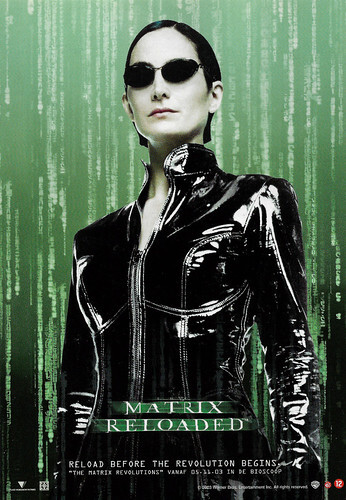
Belgian postcard by Boomerang for Extrazone. Photo: Warner Bros. Carrie Ann Moss in The Matrix Reloaded (Lana Wachowski, Lilly Wachowski, 2003).
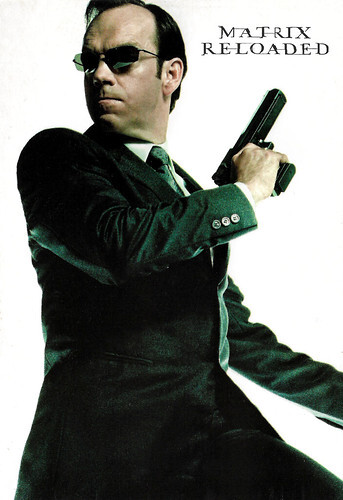
Vintage postcard, no. 810. Photo: Warner Bros. Hugo Weaving in The Matrix Reloaded (Lana Wachowski, Lilly Wachowski, 2003).
Extremely difficult action sequences
In the first film of the trilogy, The Matrix (Lana Wachowski, Lilly Wachowski, 1999), Neo (The One - Keanu Reeves ) discovered that the life he was leading was not real and found out what The Matrix is. At the end of the 21st century, mankind invented real AI (Artificial intelligence). This technology worked only on solar energy.
When the machines turned against humanity, people thought that by shutting them off from sunlight they could be rendered harmless. The humans turned the sky into an endless black cloud. The machines discovered an alternative form of energy generation: using the body heat of living people. So people were effectively turned into batteries.
To prevent humans from rebelling, the machines created a simulation of the world before it was destroyed and taken over. This virtual world was called "The Matrix" by the rebels. In the second film, The Matrix Reloaded (Lana Wachowski, Lilly Wachowski, 2003), Neo tries to fulfill The Prophecy and with freedom fighters Trinity (Carrie-Anne Moss), and Morpheus (Laurence Fishburne), he continues to lead the revolt against the Machine Army.
They estimate that they have 72 hours until Zion falls under siege to the Machine Army. Only a matter of hours separates the last human enclave on Earth from 250,000 Sentinels programmed to destroy mankind. But the citizens of Zion, emboldened by Morpheus's conviction that the One will fulfill the Oracle's Prophecy and end the war with the Machines, rest all manner of hope and expectation on Neo, who finds himself stalled by disturbing visions as he searches for a course of action.
Neo, Trinity, and Morpheus unleash their arsenal of extraordinary skills and weaponry against the systematic forces of repression and exploitation. Following the success of the previous film, the Wachowskis came up with extremely difficult action sequences, such as the Burly Brawl, a scene in which Neo had to fight 100 Agent Smiths. To develop technologies for the film, Warner Bros. launched ESC Entertainment.

French postcard by Sonis, no. F 110. Photo: Warner Bros. Laurence Fishburne in The Matrix Reloaded (Lana Wachowski, Lilly Wachowski, 2003).

Belgian postcard by Boomerang for Extrazone. Photo: Warner Bros. Laurence Fishburne in The Matrix Reloaded (Lana Wachowski, Lilly Wachowski, 2003). Caption: Reload before the revolution begins.
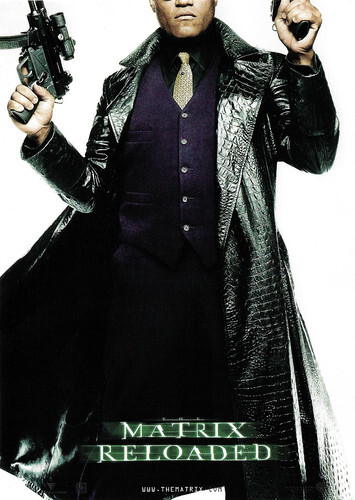
Dutch postcard by Boomerang Studycards, Amsterdam, no. P08-03, 2003. Laurence Fishburne in The Matrix Reloaded (Lana Wachowski, Lilly Wachowski, 2003).
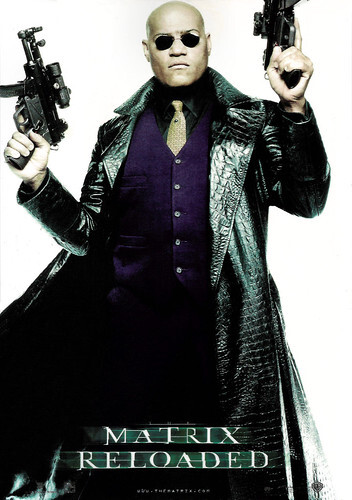
French postcard by Sonis, no. F 102. Photo: Warner Bros. Laurence Fishburne in The Matrix Reloaded (Lana Wachowski, Lilly Wachowski, 2003).
One of the most genuinely anticipated movies of its time
The Matrix (1999) was a cult hit, but The Matrix Reloaded (2003) made more money. Skyler Miller at AllMovie: "One of the most genuinely anticipated movies of its time, The Matrix Reloaded saturated theaters with an expectation of excellence that few films would ever be able to meet. But even with unrealistic expectations taken into account, this first sequel to The Matrix still disappoints. Respect must be given to the ambition, complexity, and sheer scale of the endeavor, but this quickly gives way to the significant problems with pacing and structure that didn't exist in the first movie."
The Matrix Reloaded (2003) grossed $739.4 million worldwide and received generally positive reviews from critics. Roger Ebert: "in Reloaded, (Neo) destroys dozens of clones of Agent Smith (Hugo Weaving) in martial combat. That fight scene is made with the wonders of digital effects and the choreography of the Hong Kong action director Yuen Wo Ping, who also did the fights in Crouching Tiger, Hidden Dragon. It provides one of the three great set pieces in the movie.
The second comes when Morpheus returns to Zion and addresses the assembled multitude--an audience that looks like a mosh pit crossed with the underground slaves in Metropolis. After his speech, the citizens dance in a percussion-driven frenzy, which is intercut with Neo and Trinity (Carrie-Anne Moss) having sex. I think their real bodies are having the sex, although you can never be sure. The third sensational sequence is a chase involving cars, motorcycles and trailer trucks, with gloriously choreographed moves including leaps into the air as a truck continues to move underneath. That this scene logically takes place in cyberspace does not diminish its thrilling 14-minute fun ride."
The Wachowskis paid a lot of attention to the storyline, there are many philosophical references, and the protagonist of the film, Neo, bears a striking resemblance to Jesus. He fights for 'Zion', sacrifices himself at the end of the trilogy, and fights an enemy far greater than himself.
The Matrix Reloaded and the third film, The Matrix Revolutions (2003) were filmed simultaneously but were released months apart in cinemas for marketing reasons. The initial plan was for the two films to be released two weeks apart, but this was eventually changed to six months. The Matrix Reloaded is absolutely inseparable from The Matrix Revolutions; the story in Reloaded stops abruptly and is continued in Revolutions.

Dutch postcard by Boomerang Studycards, Amsterdam, no. P08-03, 2003. Keanu Reeves in The Matrix Reloaded (Lana Wachowski, Lilly Wachowski, 2003).
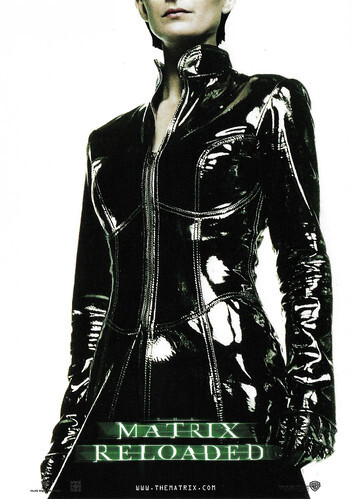
Dutch postcard by Boomerang Studycards, Amsterdam, no. P08-03, 2003. Carrie Ann Moss in The Matrix Reloaded (Lana Wachowski, Lilly Wachowski, 2003).

Belgian postcard by Boomerang for Extrazone. Photo: Warner Bros. Hugo Weaving in The Matrix Reloaded (Lana Wachowski, Lilly Wachowski, 2003). Caption: Reload before the revolution begins.

Vintage postcard, no. 813. Photo: Warner Bros. Adrian Rayment and Neil Rayment in The Matrix Reloaded (Lana Wachowski, Lilly Wachowski, 2003).
Sources: Roger Ebert (RogerEbert.com), Skyler Miller (AllMovie), Wikipedia (Dutch and English), and IMDb.

Belgian postcard by Boomerang for Extrazone. Photo: Warner Bros. Keanu Reeves in The Matrix Reloaded (Lana Wachowski, Lilly Wachowski, 2003).

French postcard by Sonis, no. F. 103. Photo: Warner Bros. Monica Bellucci in The Matrix Reloaded (Lana Wachowski, Lilly Wachowski, 2003).

Belgian postcard by Boomerang for Extrazone. Photo: Warner Bros. Carrie Ann Moss in The Matrix Reloaded (Lana Wachowski, Lilly Wachowski, 2003).

Vintage postcard, no. 810. Photo: Warner Bros. Hugo Weaving in The Matrix Reloaded (Lana Wachowski, Lilly Wachowski, 2003).
Extremely difficult action sequences
In the first film of the trilogy, The Matrix (Lana Wachowski, Lilly Wachowski, 1999), Neo (The One - Keanu Reeves ) discovered that the life he was leading was not real and found out what The Matrix is. At the end of the 21st century, mankind invented real AI (Artificial intelligence). This technology worked only on solar energy.
When the machines turned against humanity, people thought that by shutting them off from sunlight they could be rendered harmless. The humans turned the sky into an endless black cloud. The machines discovered an alternative form of energy generation: using the body heat of living people. So people were effectively turned into batteries.
To prevent humans from rebelling, the machines created a simulation of the world before it was destroyed and taken over. This virtual world was called "The Matrix" by the rebels. In the second film, The Matrix Reloaded (Lana Wachowski, Lilly Wachowski, 2003), Neo tries to fulfill The Prophecy and with freedom fighters Trinity (Carrie-Anne Moss), and Morpheus (Laurence Fishburne), he continues to lead the revolt against the Machine Army.
They estimate that they have 72 hours until Zion falls under siege to the Machine Army. Only a matter of hours separates the last human enclave on Earth from 250,000 Sentinels programmed to destroy mankind. But the citizens of Zion, emboldened by Morpheus's conviction that the One will fulfill the Oracle's Prophecy and end the war with the Machines, rest all manner of hope and expectation on Neo, who finds himself stalled by disturbing visions as he searches for a course of action.
Neo, Trinity, and Morpheus unleash their arsenal of extraordinary skills and weaponry against the systematic forces of repression and exploitation. Following the success of the previous film, the Wachowskis came up with extremely difficult action sequences, such as the Burly Brawl, a scene in which Neo had to fight 100 Agent Smiths. To develop technologies for the film, Warner Bros. launched ESC Entertainment.

French postcard by Sonis, no. F 110. Photo: Warner Bros. Laurence Fishburne in The Matrix Reloaded (Lana Wachowski, Lilly Wachowski, 2003).

Belgian postcard by Boomerang for Extrazone. Photo: Warner Bros. Laurence Fishburne in The Matrix Reloaded (Lana Wachowski, Lilly Wachowski, 2003). Caption: Reload before the revolution begins.

Dutch postcard by Boomerang Studycards, Amsterdam, no. P08-03, 2003. Laurence Fishburne in The Matrix Reloaded (Lana Wachowski, Lilly Wachowski, 2003).

French postcard by Sonis, no. F 102. Photo: Warner Bros. Laurence Fishburne in The Matrix Reloaded (Lana Wachowski, Lilly Wachowski, 2003).
One of the most genuinely anticipated movies of its time
The Matrix (1999) was a cult hit, but The Matrix Reloaded (2003) made more money. Skyler Miller at AllMovie: "One of the most genuinely anticipated movies of its time, The Matrix Reloaded saturated theaters with an expectation of excellence that few films would ever be able to meet. But even with unrealistic expectations taken into account, this first sequel to The Matrix still disappoints. Respect must be given to the ambition, complexity, and sheer scale of the endeavor, but this quickly gives way to the significant problems with pacing and structure that didn't exist in the first movie."
The Matrix Reloaded (2003) grossed $739.4 million worldwide and received generally positive reviews from critics. Roger Ebert: "in Reloaded, (Neo) destroys dozens of clones of Agent Smith (Hugo Weaving) in martial combat. That fight scene is made with the wonders of digital effects and the choreography of the Hong Kong action director Yuen Wo Ping, who also did the fights in Crouching Tiger, Hidden Dragon. It provides one of the three great set pieces in the movie.
The second comes when Morpheus returns to Zion and addresses the assembled multitude--an audience that looks like a mosh pit crossed with the underground slaves in Metropolis. After his speech, the citizens dance in a percussion-driven frenzy, which is intercut with Neo and Trinity (Carrie-Anne Moss) having sex. I think their real bodies are having the sex, although you can never be sure. The third sensational sequence is a chase involving cars, motorcycles and trailer trucks, with gloriously choreographed moves including leaps into the air as a truck continues to move underneath. That this scene logically takes place in cyberspace does not diminish its thrilling 14-minute fun ride."
The Wachowskis paid a lot of attention to the storyline, there are many philosophical references, and the protagonist of the film, Neo, bears a striking resemblance to Jesus. He fights for 'Zion', sacrifices himself at the end of the trilogy, and fights an enemy far greater than himself.
The Matrix Reloaded and the third film, The Matrix Revolutions (2003) were filmed simultaneously but were released months apart in cinemas for marketing reasons. The initial plan was for the two films to be released two weeks apart, but this was eventually changed to six months. The Matrix Reloaded is absolutely inseparable from The Matrix Revolutions; the story in Reloaded stops abruptly and is continued in Revolutions.

Dutch postcard by Boomerang Studycards, Amsterdam, no. P08-03, 2003. Keanu Reeves in The Matrix Reloaded (Lana Wachowski, Lilly Wachowski, 2003).

Dutch postcard by Boomerang Studycards, Amsterdam, no. P08-03, 2003. Carrie Ann Moss in The Matrix Reloaded (Lana Wachowski, Lilly Wachowski, 2003).

Belgian postcard by Boomerang for Extrazone. Photo: Warner Bros. Hugo Weaving in The Matrix Reloaded (Lana Wachowski, Lilly Wachowski, 2003). Caption: Reload before the revolution begins.

Vintage postcard, no. 813. Photo: Warner Bros. Adrian Rayment and Neil Rayment in The Matrix Reloaded (Lana Wachowski, Lilly Wachowski, 2003).
Sources: Roger Ebert (RogerEbert.com), Skyler Miller (AllMovie), Wikipedia (Dutch and English), and IMDb.
Published on June 09, 2022 22:00
June 8, 2022
La nascita di Salomè (1940)
The Italian-Spanish film comedy La nascita di Salomè/The birth of Salome (Jean Choux, 1940) was produced by Augusto Turati and Andrea Robilant for the company Stella Film. The script was based on a story by Cesare Meano. The film was shot in Cinecittà in Rome with both Italian and Spanish actors, all appearing in both versions. All Spanish actors were dubbed in the Italian version and vice-versa. The Italian version was released in Italy in July 1940, while the Spanish version of the film, known as El nacimiento de Salomé was released in Spain in March 1941.
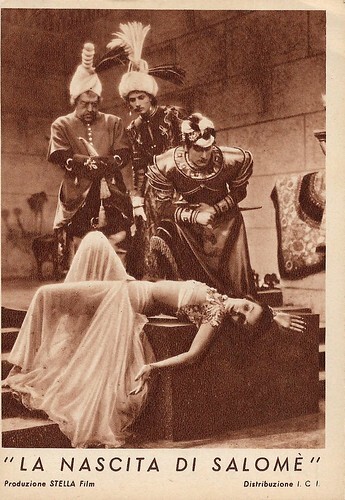
Italian postcard. Photo: Stella Film / I.C.I. Conchita Montenegro in La nascita di Salomè/The birth of Salome (Jean Choux, 1940).
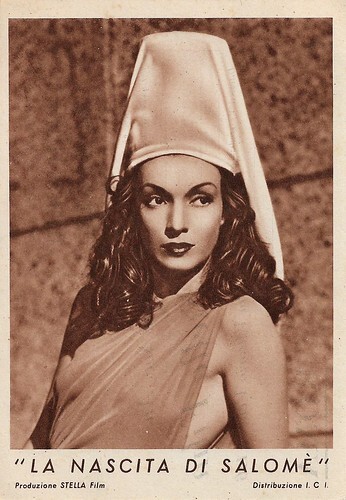
Italian postcard. Photo: Stella Film / I.C.I. Conchita Montenegro in La nascita di Salomè/The birth of Salome (Jean Choux, 1940).
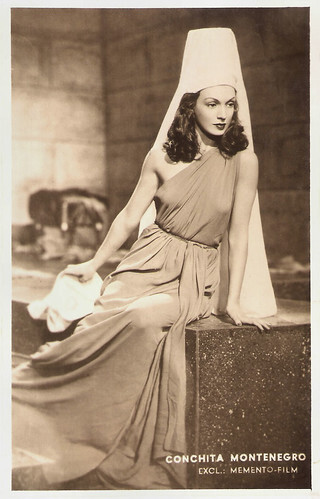
Italian postcard. Photo: Stella Film / I.C.I. Conchita Montenegro in La nascita di Salomè/The birth of Salome (Jean Choux, 1940).
A comedy set in Ancient times
La nascita di Salomè/The birth of Salome (Jean Choux, 1940) is a comedy set in Ancient times. Salomè was played by Conchita Montenegro , a Spanish model, dancer, and stage and screen actress who starred in several Spanish productions, but also in Italian, French, German and American films.
Nerio Bernardi stars as the king of the Parthians, a powerful ruler of ancient Persia.
He learns that the monarch of a small kingdom, Aristobulus ( Armando Falconi ), has married Salome, a beautiful dancer, and sends a messenger to offer him four provinces in exchange for his wife.
Aristobulus does not even dream of losing his Salome, who in reality has become a matron-like lady (Maria Gomez). He makes an agreement with a clever minister and sends him a substitute (Conchita Montenegro), carefully selected from among the beauties of his kingdom.
In this way a new Salome is born, a beautiful and skilful dancer, capable of captivating all men. All this is discovered by the envoys of the king of the Parthians but, fascinated, they pretend there has been no deception and bring the girl to their sovereign, who is very impressed and gives Aristobulus the promised provinces.
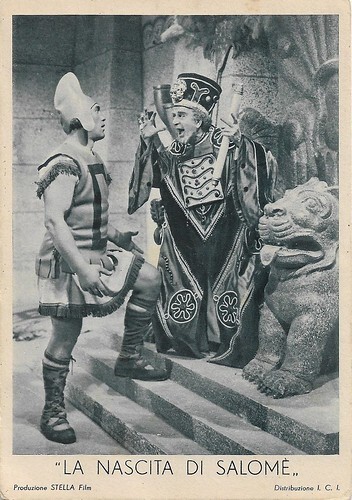
Italian postcard. Photo: Stella Film / I.C.I. Primo Carnera and Armando Falconi in La nascita di Salomè/The birth of Salome (Jean Choux, 1940). The back of the card offers a referendum on the two endings of the film, to be sent to the company Stella Film, Via Vittorio Veneto 116 in Rome.
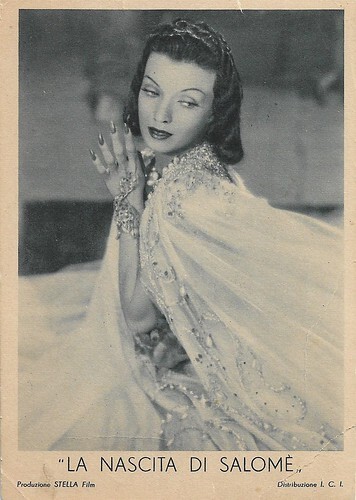
Italian postcard. Photo: Stella Film / I.C.I. Conchita Montenegro in La nascita di Salomè/The birth of Salome (Jean Choux, 1940).
Big gimmick
The costumes of La nascita di Salomè/The birth of Salome (Jean Choux, 1940) were designed by Gino Carlo Sensani and Maria De Matteis. The cinematography was by Carlo Montuori.
Gino Carlo Sensani was the most important costume designer of the Italian cinema of the 1930s and 1940s, specializing in historical films. Maria De Matteis was his assistant before becoming an important costume designer herself in the 1940s and 1950s, e.g. for Malombra (Mario Soldati, 1942), Ossessione (Luchino Visconti, 1943), La carrozza d'oro (Jean Renoir, 1953), Carosello napoletano (Ettore Giannini, 1954), and War and Peace (1956) by King Vidor.
Carlo Montuori was one of the most productive Italian cinematographers, with a long career starting in 1913 and ending in 1961. Montuori was involved in many historical films in the silent and sound era including the silent version of Ben-Hur (Fred Niblo, 1925), but also divafilms, many 1930s comedies by Camerini, Bragaglia, Righelli and others, notable dramas such as Piccolo mondo antico by Soldati, and several films by Vittorio De Sica .
Osvaldo Scaccia in his review of La nascita di Salomè/The birth of Salome in Film n. 52, 28 December 1940: "The big gimmick should be the two endings. The producers have even announced a 'referendum' among the viewers to find out which of the two they prefer. In the first ending, suffused with intimate humanity, we see the good-natured king clinging affectionately to his wife.
In the second, with its Trio Lescano comedy, the melancholy king's ambassador falls in love with Salome and his companion exclaims - hilarity! - I said it myself that someone was going to lose their head. [...] Of the leading actors, I remember Armando Falconi who gives a great performance and Conchita Montenegro. [...] The dance she does in front of the ambassador of the melancholic king is one of the most evocative scenes in this excellent film and manages to make us forget the two endings."
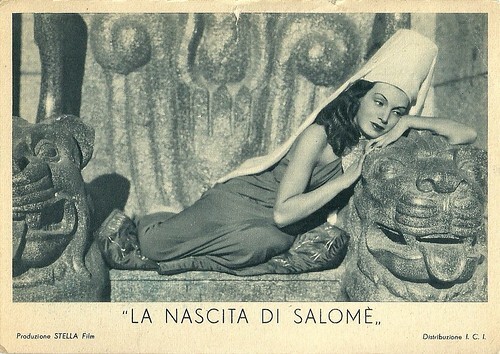
Italian postcard. Photo: Stella Film / I.C.I. Conchita Montenegro in La nascita di Salomè/The birth of Salome (Jean Choux, 1940).
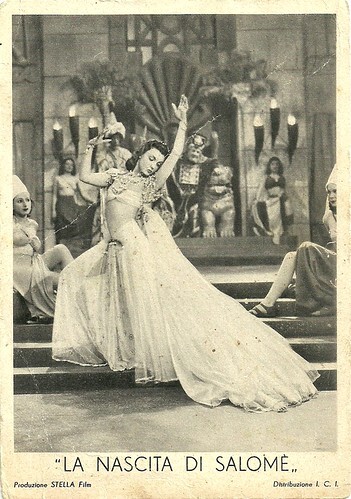
Italian postcard. Photo: Stella Film / I.C.I. Conchita Montenegro in La nascita di Salomè/The birth of Salome (Jean Choux, 1940).
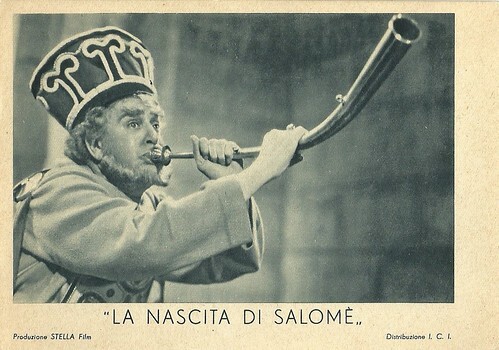
Italian postcard. Photo: Stella Film / I.C.I. Armando Falconi in La nascita di Salomè/The birth of Salome (Jean Choux, 1940).
Sources: Wikipedia (Italian), and IMDb.

Italian postcard. Photo: Stella Film / I.C.I. Conchita Montenegro in La nascita di Salomè/The birth of Salome (Jean Choux, 1940).

Italian postcard. Photo: Stella Film / I.C.I. Conchita Montenegro in La nascita di Salomè/The birth of Salome (Jean Choux, 1940).

Italian postcard. Photo: Stella Film / I.C.I. Conchita Montenegro in La nascita di Salomè/The birth of Salome (Jean Choux, 1940).
A comedy set in Ancient times
La nascita di Salomè/The birth of Salome (Jean Choux, 1940) is a comedy set in Ancient times. Salomè was played by Conchita Montenegro , a Spanish model, dancer, and stage and screen actress who starred in several Spanish productions, but also in Italian, French, German and American films.
Nerio Bernardi stars as the king of the Parthians, a powerful ruler of ancient Persia.
He learns that the monarch of a small kingdom, Aristobulus ( Armando Falconi ), has married Salome, a beautiful dancer, and sends a messenger to offer him four provinces in exchange for his wife.
Aristobulus does not even dream of losing his Salome, who in reality has become a matron-like lady (Maria Gomez). He makes an agreement with a clever minister and sends him a substitute (Conchita Montenegro), carefully selected from among the beauties of his kingdom.
In this way a new Salome is born, a beautiful and skilful dancer, capable of captivating all men. All this is discovered by the envoys of the king of the Parthians but, fascinated, they pretend there has been no deception and bring the girl to their sovereign, who is very impressed and gives Aristobulus the promised provinces.

Italian postcard. Photo: Stella Film / I.C.I. Primo Carnera and Armando Falconi in La nascita di Salomè/The birth of Salome (Jean Choux, 1940). The back of the card offers a referendum on the two endings of the film, to be sent to the company Stella Film, Via Vittorio Veneto 116 in Rome.

Italian postcard. Photo: Stella Film / I.C.I. Conchita Montenegro in La nascita di Salomè/The birth of Salome (Jean Choux, 1940).
Big gimmick
The costumes of La nascita di Salomè/The birth of Salome (Jean Choux, 1940) were designed by Gino Carlo Sensani and Maria De Matteis. The cinematography was by Carlo Montuori.
Gino Carlo Sensani was the most important costume designer of the Italian cinema of the 1930s and 1940s, specializing in historical films. Maria De Matteis was his assistant before becoming an important costume designer herself in the 1940s and 1950s, e.g. for Malombra (Mario Soldati, 1942), Ossessione (Luchino Visconti, 1943), La carrozza d'oro (Jean Renoir, 1953), Carosello napoletano (Ettore Giannini, 1954), and War and Peace (1956) by King Vidor.
Carlo Montuori was one of the most productive Italian cinematographers, with a long career starting in 1913 and ending in 1961. Montuori was involved in many historical films in the silent and sound era including the silent version of Ben-Hur (Fred Niblo, 1925), but also divafilms, many 1930s comedies by Camerini, Bragaglia, Righelli and others, notable dramas such as Piccolo mondo antico by Soldati, and several films by Vittorio De Sica .
Osvaldo Scaccia in his review of La nascita di Salomè/The birth of Salome in Film n. 52, 28 December 1940: "The big gimmick should be the two endings. The producers have even announced a 'referendum' among the viewers to find out which of the two they prefer. In the first ending, suffused with intimate humanity, we see the good-natured king clinging affectionately to his wife.
In the second, with its Trio Lescano comedy, the melancholy king's ambassador falls in love with Salome and his companion exclaims - hilarity! - I said it myself that someone was going to lose their head. [...] Of the leading actors, I remember Armando Falconi who gives a great performance and Conchita Montenegro. [...] The dance she does in front of the ambassador of the melancholic king is one of the most evocative scenes in this excellent film and manages to make us forget the two endings."

Italian postcard. Photo: Stella Film / I.C.I. Conchita Montenegro in La nascita di Salomè/The birth of Salome (Jean Choux, 1940).

Italian postcard. Photo: Stella Film / I.C.I. Conchita Montenegro in La nascita di Salomè/The birth of Salome (Jean Choux, 1940).

Italian postcard. Photo: Stella Film / I.C.I. Armando Falconi in La nascita di Salomè/The birth of Salome (Jean Choux, 1940).
Sources: Wikipedia (Italian), and IMDb.
Published on June 08, 2022 22:00
June 7, 2022
Anthony Delon
Former wild boy Anthony Delon (1964) is the son of screen idol Alain Delon and film actress Nathalie Delon. The handsome French-American actor was first better known as a jet setting playboy than as a serious film star, but coming of age he stepped out of the shadow of his famous father.

French postcard no. 68.

French postcard no. 1036.
Genes and good looks
Anthony Delon was born Antoine Delon in the famous Cedar Sinai hospital of Beverly Hills, USA. He was the son of actors Alain Delon and Nathalie Delon, and at the time, his father worked in Hollywood.
After his family’s return to France, Anthony spent his first school years at bilingual schools. After the divorce of his parents in 1968, he lived with his mother. He was a rebellious and wild child and his parents sent him to a boarding school.
When 19, Delon had his own leather company and part-owned a club, but his business partner in the venture was shot. Delon himself, for unrelated incidents, went to prison for a month. In the US, his genes and his good looks helped him get a modelling job with American photographer Bruce Weber.
This led to a leading part in the Italian romance drama Una spina nel cuore/A Thorn in the Heart (Alberto Lattuada, 1986), loosely based on the novel with the same title by Piero Chiara. His co-stars were Sophie Duez and Antonella Lualdi .
Even more prestigious was his next leading part in the drama Crónica de una muerte anunciada/Chronicle of a Death Foretold (Francesco Rosi, 1987), adapted by Tonino Guerra from the eponymous novel by Gabriel García Márquez. The film also starred Rupert Everett , Ornella Muti , and Gian Maria Volonté, and premiered at the Cannes film festival in May 1987. According to Wikipedia , the film was a critical success in Latin America and Eastern Europe but was snubbed by French critics.
At 24, Delon returned to the US and lived in Los Angeles for two years. He took some acting classes for about six months, and then just partied. He was even once, alongside Ivana Trump, Joan Collins and Richard Branson, one of the Miss World judges. During the 1980s, playboy Delon was one of the boyfriends of Princess Stéphanie of Monaco, and he also had a relationship with sexy actress Valerie Kaprisky.
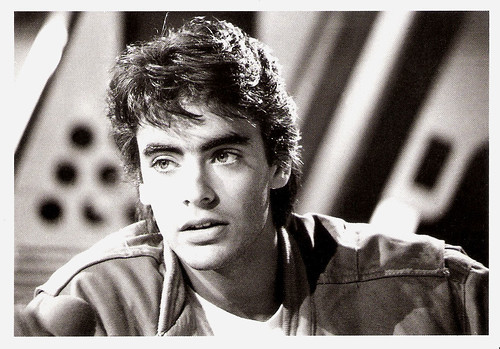
French postcard by Editions Humour à la Carte, Paris, no. ST-184.
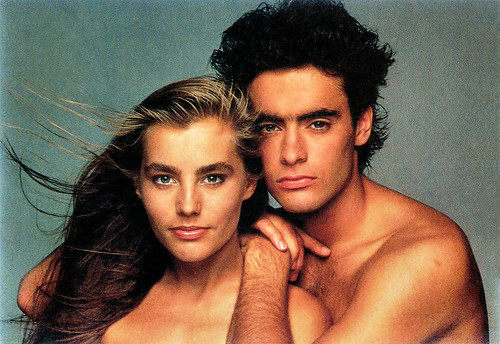
Italian postcard. Photo: publicity still for the Italian romance drama Una spina nel cuore/A Thorn in the Heart (Alberto Lattuada, 1986) with Sophie Duez.
A huge box office smash
In 1990 Anthony Delon returned to France. He played in the film comedy La Femme fardée/The Strange Woman (José Pinheiro, 1990) with Jeanne Moreau , which was a spectacular flop.
He found most of his work on TV in series and films like Sup de fric/Cash Academy (Christian Gion, 1992), starring Jean Poiret.
Ten years after Crónica de una muerte anunciada, Delon played a small role in the French film La Vérité si je mens!/Would I Lie to You? (Thomas Gilou, 1997), about working-class immigrants living in metropolitan Paris. It was a huge box office smash and lead to two sequels.
For Delon, the success meant he could finally step out of the shadow of his father. That same year, he played the lead in the TV Miniseries Deserto di fuoco/Desert of Fire (Enzo G. Castellari, 1997). This was a European co-production between Italy, Germany and France, with a cast including such European stars as Claudia Cardinale , Arielle Dombasle, Vittorio Gassman , Marie Laforêt , Franco Nero , Fabio Testi and Jean Sorel .
In the following years, he played several roles in French TV series and films. In the TV film Un amour de femme (Sylvie Verheyde, 2001), he played the husband of a woman (Hélène Fillières) who has an affair with a female dance instructor (Raffaëla Anderson).
Other films were the comedy Jeu de cons/Con Games (Jean-Michel Verner, 2001), the drama Danse avec lui/Dance With Him (Valérie Guignabodet, 2007) with Mathilde Seigner and Sami Frey, and Mensch (Steve Suissa, 2009) starring Nicolas Cazalé.

Romanian postcard by Casa Filmului Acin, no. 33102. Anthony Delon and Sophie Duez in the Italian romance drama Una spina nel cuore/A Thorn in the Heart (Alberto Lattuada, 1986).

British collectors card by Top Secrets.
That essential quality of being alive
In 2006, Anthony Delon married his long-time girlfriend Sophie Clerico. He has two daughters with her, Lou Delon (1996) and Liv Delon (2001).
In his autobiography, 'Le premier maillon' (2008), he wrote that he has another daughter, Alyson Le Borges (1986), from an affair with a former Crazy Horse dancer, Marie Hélène.
Recently, Delon appeared with Charles Dance and Anouk Aimée in the British film Paris Connections (Harley Cokeliss, 2010) written by Michael Tupy, based on a thriller by Jackie Collins. It was the first film funded by supermarket Tesco and released exclusively in their stores.
He also had a small part in the French drama film Polisse/Poliss (Maïwenn, 2011) with French rapper Joeystarr, Karin Viard, and Riccardo Scamarcio. The film centres on the Brigade de Protection des Mineurs, the Child Protection Unit of the Paris Police, and a photographer who is assigned to cover the unit. The title is a childish spelling of the word ‘police’. The film won the Jury Prize at the 2011 Cannes Film Festival and in 2012, it was nominated for thirteen César Awards (the French Oscar), winning two.
James Travers at French Films .Org : “Yet, whilst the film is crude, and unbearably tacky in a few places, it has that essential quality of being alive. In fact, it is a film that positively bursts with life. If we care to look beyond the soap-tinted surface, the characters and the world they inhabit do have a depth and reality to them, we do empathise with the troubled child protagonists and acquire a deeper respect for their police protectors. It is a film that it is difficult to like entirely, and some will doubtless hate it for the inelegant way it knocks the stuffing out of today's mainstream cinema conventions, yet it is a film that has definitely made its mark.”
Little is known about the whereabouts of Anthony Delon in recent years. Incidentally, he acts. Last year he appeared in the French TV film Meurtres au Mont Saint-Michel (Marie-Hélène Copti, 2021). French Wikipedia also notes that he was in a relationship with actress Sveva Alviti between 2019 and 2021 and that he studies and cultivates Buddhist philosophy.

French postcard no. 1023.

French postcard by I.P., no. 48.
Trailer Paris Connections (2010). Source: Parisconnections (YouTube).
Sources: Tobias Jones (The Independent), James Travers (French Films .Org), AllMovie, AlloCiné (French), Wikipedia (French and English), and .

French postcard no. 68.

French postcard no. 1036.
Genes and good looks
Anthony Delon was born Antoine Delon in the famous Cedar Sinai hospital of Beverly Hills, USA. He was the son of actors Alain Delon and Nathalie Delon, and at the time, his father worked in Hollywood.
After his family’s return to France, Anthony spent his first school years at bilingual schools. After the divorce of his parents in 1968, he lived with his mother. He was a rebellious and wild child and his parents sent him to a boarding school.
When 19, Delon had his own leather company and part-owned a club, but his business partner in the venture was shot. Delon himself, for unrelated incidents, went to prison for a month. In the US, his genes and his good looks helped him get a modelling job with American photographer Bruce Weber.
This led to a leading part in the Italian romance drama Una spina nel cuore/A Thorn in the Heart (Alberto Lattuada, 1986), loosely based on the novel with the same title by Piero Chiara. His co-stars were Sophie Duez and Antonella Lualdi .
Even more prestigious was his next leading part in the drama Crónica de una muerte anunciada/Chronicle of a Death Foretold (Francesco Rosi, 1987), adapted by Tonino Guerra from the eponymous novel by Gabriel García Márquez. The film also starred Rupert Everett , Ornella Muti , and Gian Maria Volonté, and premiered at the Cannes film festival in May 1987. According to Wikipedia , the film was a critical success in Latin America and Eastern Europe but was snubbed by French critics.
At 24, Delon returned to the US and lived in Los Angeles for two years. He took some acting classes for about six months, and then just partied. He was even once, alongside Ivana Trump, Joan Collins and Richard Branson, one of the Miss World judges. During the 1980s, playboy Delon was one of the boyfriends of Princess Stéphanie of Monaco, and he also had a relationship with sexy actress Valerie Kaprisky.

French postcard by Editions Humour à la Carte, Paris, no. ST-184.

Italian postcard. Photo: publicity still for the Italian romance drama Una spina nel cuore/A Thorn in the Heart (Alberto Lattuada, 1986) with Sophie Duez.
A huge box office smash
In 1990 Anthony Delon returned to France. He played in the film comedy La Femme fardée/The Strange Woman (José Pinheiro, 1990) with Jeanne Moreau , which was a spectacular flop.
He found most of his work on TV in series and films like Sup de fric/Cash Academy (Christian Gion, 1992), starring Jean Poiret.
Ten years after Crónica de una muerte anunciada, Delon played a small role in the French film La Vérité si je mens!/Would I Lie to You? (Thomas Gilou, 1997), about working-class immigrants living in metropolitan Paris. It was a huge box office smash and lead to two sequels.
For Delon, the success meant he could finally step out of the shadow of his father. That same year, he played the lead in the TV Miniseries Deserto di fuoco/Desert of Fire (Enzo G. Castellari, 1997). This was a European co-production between Italy, Germany and France, with a cast including such European stars as Claudia Cardinale , Arielle Dombasle, Vittorio Gassman , Marie Laforêt , Franco Nero , Fabio Testi and Jean Sorel .
In the following years, he played several roles in French TV series and films. In the TV film Un amour de femme (Sylvie Verheyde, 2001), he played the husband of a woman (Hélène Fillières) who has an affair with a female dance instructor (Raffaëla Anderson).
Other films were the comedy Jeu de cons/Con Games (Jean-Michel Verner, 2001), the drama Danse avec lui/Dance With Him (Valérie Guignabodet, 2007) with Mathilde Seigner and Sami Frey, and Mensch (Steve Suissa, 2009) starring Nicolas Cazalé.

Romanian postcard by Casa Filmului Acin, no. 33102. Anthony Delon and Sophie Duez in the Italian romance drama Una spina nel cuore/A Thorn in the Heart (Alberto Lattuada, 1986).

British collectors card by Top Secrets.
That essential quality of being alive
In 2006, Anthony Delon married his long-time girlfriend Sophie Clerico. He has two daughters with her, Lou Delon (1996) and Liv Delon (2001).
In his autobiography, 'Le premier maillon' (2008), he wrote that he has another daughter, Alyson Le Borges (1986), from an affair with a former Crazy Horse dancer, Marie Hélène.
Recently, Delon appeared with Charles Dance and Anouk Aimée in the British film Paris Connections (Harley Cokeliss, 2010) written by Michael Tupy, based on a thriller by Jackie Collins. It was the first film funded by supermarket Tesco and released exclusively in their stores.
He also had a small part in the French drama film Polisse/Poliss (Maïwenn, 2011) with French rapper Joeystarr, Karin Viard, and Riccardo Scamarcio. The film centres on the Brigade de Protection des Mineurs, the Child Protection Unit of the Paris Police, and a photographer who is assigned to cover the unit. The title is a childish spelling of the word ‘police’. The film won the Jury Prize at the 2011 Cannes Film Festival and in 2012, it was nominated for thirteen César Awards (the French Oscar), winning two.
James Travers at French Films .Org : “Yet, whilst the film is crude, and unbearably tacky in a few places, it has that essential quality of being alive. In fact, it is a film that positively bursts with life. If we care to look beyond the soap-tinted surface, the characters and the world they inhabit do have a depth and reality to them, we do empathise with the troubled child protagonists and acquire a deeper respect for their police protectors. It is a film that it is difficult to like entirely, and some will doubtless hate it for the inelegant way it knocks the stuffing out of today's mainstream cinema conventions, yet it is a film that has definitely made its mark.”
Little is known about the whereabouts of Anthony Delon in recent years. Incidentally, he acts. Last year he appeared in the French TV film Meurtres au Mont Saint-Michel (Marie-Hélène Copti, 2021). French Wikipedia also notes that he was in a relationship with actress Sveva Alviti between 2019 and 2021 and that he studies and cultivates Buddhist philosophy.

French postcard no. 1023.

French postcard by I.P., no. 48.
Trailer Paris Connections (2010). Source: Parisconnections (YouTube).
Sources: Tobias Jones (The Independent), James Travers (French Films .Org), AllMovie, AlloCiné (French), Wikipedia (French and English), and .
Published on June 07, 2022 22:00
June 6, 2022
Three later films with Lyda Borelli: Rapsodia satanica (1917), La storia dei tredici (1917) and Il dramma di una notte (1918)
Lyda Borelli (1887-1959) was the first diva of the Italian silent cinema. Between 1914 and 1918, the fascinating film star caused a craze among female fans called 'Borellismo'. In this post, Ivo Blom focuses on three of her later films: Rapsodia satanica/Satan's Rhapsody (1917), La storia dei tredici/The Thirteenth Man (1917) and Il dramma di una notte/The Drama of One Night (1918).
Rapsodia satanica (1917)
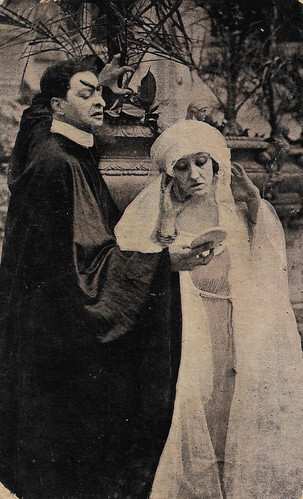
Spanish collectors card by Chocolate Imperiale, no. 1 of 6 cards. Photo: J. Muntañola, Barcelona / Cines. Lyda Borelli , and Ugo Bazzini in Rapsodia satanica (Nino Oxilia, 1917).
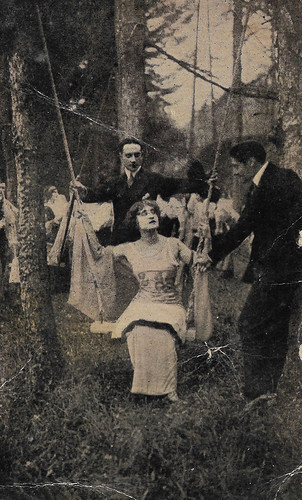
Spanish collectors card by Chocolate Imperiale, no. 2 of 6 cards. Photo: J. Muntañola, Barcelona / Cines. Lyda Borelli , Giovanni Cini, and Andrea Habay in Rapsodia satanica (Nino Oxilia, 1917).
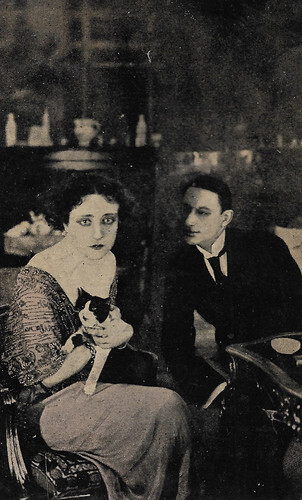
Spanish collectors card by Chocolate Imperiale, no. 3 of 6 cards. Photo: J. Muntañola, Barcelona / Cines. Lyda Borelli and Giovanni Cini in Rapsodia satanica (Nino Oxilia, 1917).
In Rapsodia satanica/Satan's Rhapsody (Nino Oxilia, 1917), the old Contessa Alba d'Oltrevita ( Lyda Borelli ) deplores her faded youth after a party at her castle. Mephisto (Ugo Bazzini) steps out of a painting and offers her a pact: if she denies love, he will make her young again. She destroys a statuette of Love to conform her renouncement (yet, the sculpture was not entirely broken).
Alba changes into youthful splendour and enjoys the company of young men, in particular the two brothers Tristano and Sergio. Sergio is head over heels in love with her, but she laughs him off. During a costumed ball, in which Alba is dressed as Salome, she gets a note from Sergio, telling her to come out at midnight or he will kill himself. The capricious Alba then seduces Tristano and forces him to choose: either he or his brother will have her. He goes mad and prevents her from going outside.
A shot is heard: Sergio has killed himself. Tristano and Alba are shocked, she pushes him away and closes the castle to mourn her loss. After a while she notices Spring has arrived and revives, covering her rooms with flowers. At nighttime, she notices there is a cavalier on the hills. Could it be Tristano returning? She dresses up like a priestess and goes outside, expecting her lover. But instead, it is Mephisto who punishes her for falling in love and changes her back into the old lady. When seeing herself in the pond, she dies of a heart attack.
As Anthony Kobal writes on IMDb , "Rapsodia Satanica was the last film directed by Nino Oxilia [who was killed in action in 1917] and is undoubtedly one of the finest achievements of the early Italian cinema. In it, Oxilia spins a variation on the Faust myth, embodied here by the diva Lyda Borelli . Typical of extravagant D'Annunzian aestheticism at its height, Rapsodia Satanica was one of the summits of what was later called the "tail coat film." Diametrically opposed to the "cinema of reality" practiced by Serena, Martoglio, and others, "tail coat films" set their melodramatic stories in the salons and villas of the upper-middle class and the aristocracy, deploying narrative structures contrived to showcase their actors and especially its actresses. This had the effect of accentuating their physical presence and turning them into stars - probably the first stars in movie history. The success of the "diva" contributed to the development of motion picture grammar in its special use of the close-up."
This is the first and only film to feature a score written especially for it by famous composer Pietro Mascagni. While already in 1914 Oxilia had started shooting, in 1915 Mascagni was involved and additional footage was shot to please the maestro. While the film was ready that year, it still took two more years to be released, in a reduced and not very successful version.
Only in the 1980s, the film was rediscovered. It was e.g. included in the Dutch retrospective 'Hartstocht en heldendom: Il primo cinema italiano, 1905-1945' (1988), co-organised by Ivo Blom and Nelly Voorhuis. It was still a black-and-white version then, but in 1996 a part monochrome tinted and toned, and part hand-colored version was found at the Cinémathèque Suisse in Lausanne. Thanks to the film archives of Bologna, Milan, and Lausanne the film was analog restored. In 2015 the film was digitally restored in 4K by Bologna and Lausanne. In 2018 Cineteca di Bologna released the 4-films-DVD Dive!, which includes Rapsodia satanica, with the music by Mascagni.
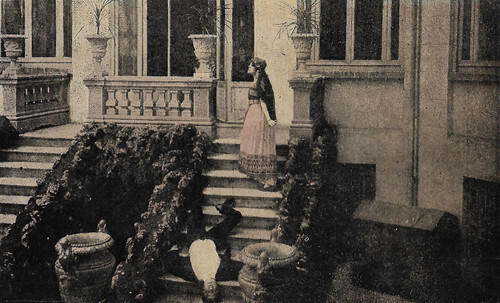
Spanish collectors card by Chocolate Imperiale, no. 4 of 6 cards. Photo: J. Muntañola, Barcelona / Cines. Lyda Borelli and Giovanni Cini in Rapsodia satanica (Nino Oxilia, 1917).
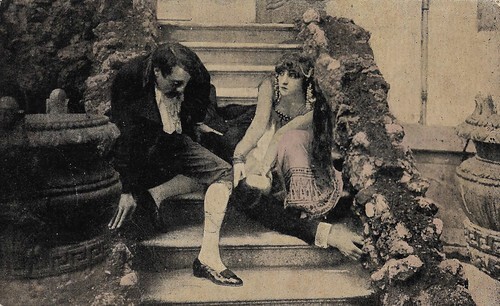
Spanish collectors card by Chocolate Imperiale, no. 5 of 6 cards. Photo: J. Muntañola, Barcelona / Cines. Andrea Habay , Giovanni Cini, and Lyda Borelli in Rapsodia satanica (Nino Oxilia, 1917).
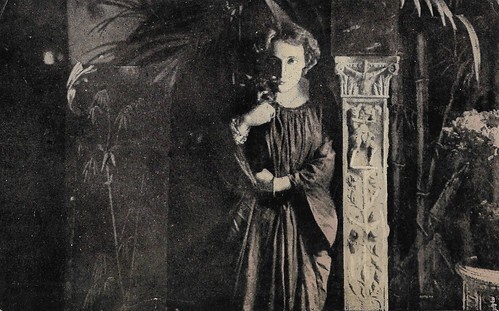
Spanish collectors card by Chocolate Imperiale, no. 6 of 6 cards. Photo: J. Muntañola, Barcelona / Cines. Lyda Borelli in Rapsodia satanica (Nino Oxilia, 1917).
La storia dei tredici (1917)
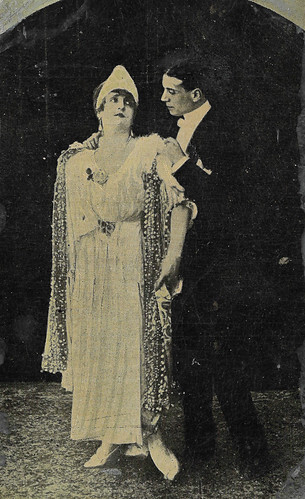
Spanish collectors card by Chocolate Imperiale, no. 1 of 6 cards. Photo: J. Muntañola, Barcelona / Cines. Lyda Borelli in La storia dei tredici (Carmine Gallone, 1917).
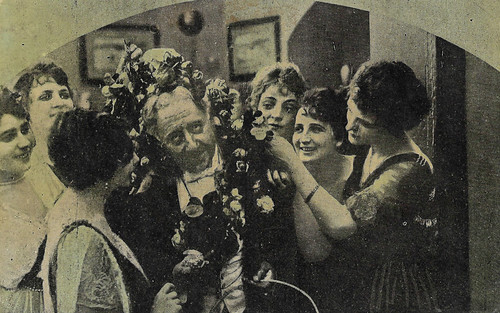
Spanish collectors card by Chocolate Imperiale, no. 3 of 6 cards. Photo: J. Muntañola, Barcelona / Cines. Ugo Piperno in La storia dei tredici (Carmine Gallone, 1917).
La storia dei tredici/The Thirteenth Man (Carmine Gallone, 1917) was made after a script by Lucio d'Ambra based on 'La duchesse de Langeais', one of the three volumes of Honoré de Balzac's tripartite novel 'L'histoire des treize' (1833-39), which appeared as 'Ferragus', 'La duchesse de Langeais' and 'La fille aux yeux d'or'.
A poet, a sculptor, a philosopher, an astronomist, a painter, a musician, and seven other men of culture and pleasure, tired of the joys of wealth, youth, and ardor, unite to heighten their existence under the motto of One for All and All for One. Yet, love is banned. In an ordinary house, they recreate the most ancient pleasures: the court of Pericles, the gardens of Arcadia, etc.
But one of them betrays the pact, falling in love with the Duchess of Langeais ( Lyda Borelli ). In order to find out who is the trespasser, Count Cent'Anni (Ugo Piperno) orders Montriveaux (Sandro Salvini), the only one who was never in love, to find the guilty one. Yet, it is Montriveaux himself who loves the duchess and who now perseveres with even more ardor the austere virtue of the duchess.
But the friends suspect betrayal and have the duchess abducted. In a masked session, they menace to torture in a cruel way by threatening the duchess with a fire-reddened cross of Lorraine on her forehead. Montriveaux goes berserk and stops the act, betraying himself and is derided. The duchess is escorted home, but when she finds out her persisting lover was the masked man who saved her, her love dies and she decides to join a convent.
Meanwhile, Montriveaux suffers too. Because of the cynic egoism of the Thirteen two lovers have been split, and when remorse sets in, they find out it is too late. Restless, Montriveaux travels all over Europe with Cent'Anni. Finally, at a convent in Spain, they hear an angelic voice in the choir: it is hers. When they plan a second abduction, they find the body of the duchess, whose heart could not take it any longer. But love is stronger than death, the duchess resuscitates, and the lovers are reunited.
La storia dei tredici had its premiere in Rome on 13 October 1917. In 1917, Ugo Ugoletti wrote in the Roman journal Cine-gazzetto that normally film adaptations of literary classics often fail because of a too close following of content and style, but that in this case screenwriter Lucio d'Ambra had well transformed the literary source in a script well fit to the medium of cinema and its popular audience. By just keeping the center of the action, D'Ambra had made a very free adaptation of the novel, the only thing Ugoletti wrote should have been indicated.
On the performance of the actors, he wrote: "Even if not perfect on the whole, the performance by Lyda Borelli is laudable - she is the exquisite animator of unforgettable scenes - in which she shows all of her talent and attraction. In particular, in certain close-ups she managed to reach expressions of marvelous efficacy." Ugoletti also praised the other two actors Salvini and Piperno, the latter marked as 'truly delicious".
Together with Marcia nuziale (Carmine Gallone, 1915), La storia dei tredici is one of the lost films with Lyda Borelli. While most films of Borelli survive, or at least fragments remain (La falena, La dramma di una notte), from this film no footage resurfaced, despite the opening up of film archives in the past decades.
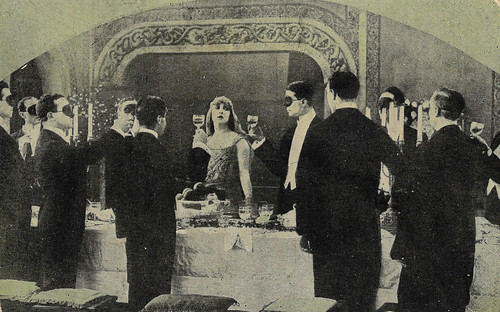
Spanish collectors card by Chocolate Imperiale, no. 4 of 6 cards. Photo: J. Muntañola, Barcelona / Cines. Lyda Borelli in La storia dei tredici (Carmine Gallone, 1917). The man right of Borelli may be the actor Sandro Salvini, the male lead of the film.
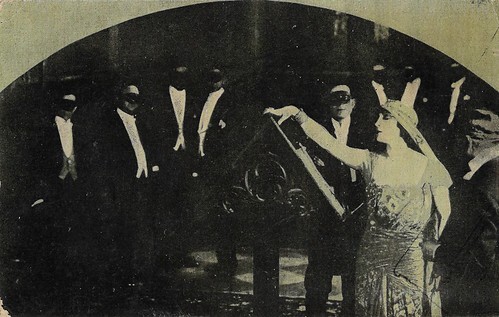
Spanish collectors card by Chocolate Imperiale, no. 5 of 6 cards. Photo: J. Muntañola, Barcelona / Cines. Lyda Borelli in La storia dei tredici (Carmine Gallone, 1917).
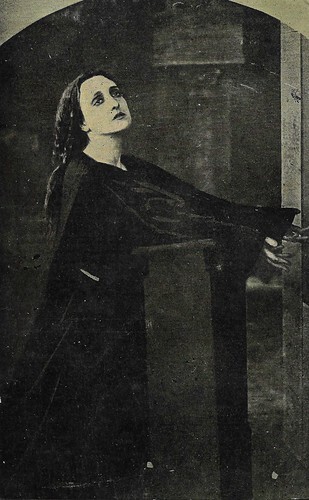
Spanish collectors card by Chocolate Imperiale, no. 6 of 6 cards. Photo: J. Muntañola, Barcelona / Cines. Lyda Borelli in La storia dei tredici (Carmine Gallone, 1917).
Il dramma di una notte/Una notte a Calcutta (1918)
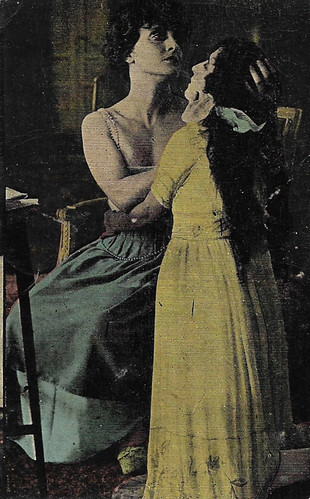
Spanish collectors card by Chocolat Imperiale, no. 1. Lyda Borelli in Il dramma di una notte/The Drama of One Night aka Una notte a Calcutta/One Night in Calcutta (Mario Caserini 1918). El drama de una noche, the Spanish release title, was released in Spain during WWI by the company José Muntañola, Barcelona. Here we also see Anna Rocchi as Nelly's sister Daisy.
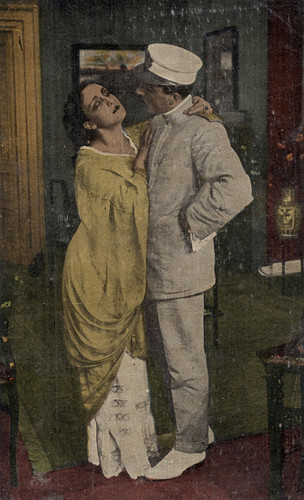
Spanish collectors card by Chocolat Imperiale, no. 3. Lyda Borelli in Il dramma di una notte/The Drama of One Night aka Una notte a Calcutta/One Night in Calcutta (Mario Caserini 1918). El drama de una noche, the Spanish release title, was released in Spain during WWI by the company José Muntañola, Barcelona.
The story of Il dramma di una notte/The Drama of One Night aka Una notte a Calcutta/One Night in Calcutta (Mario Caserini 1918) is about marine officer Guido (unknown actor, in older sources mistakenly indicated as Alberto Capozzi), who returns to Italy to meet his brother's future wife and recognizes Nelly ( Lyda Borelli ), an 'easy' woman, he once had a story with, in a house of vice in India.
At the time, Nelly took care of her mother and younger sister Daisy (Anna Rocchi). After her mother's death, Nelly repents, returns to Italy, and learns to love with sincerity: Riccardo (Livio Pavanelli).
Nelly begs, then threatens Guido not to tell his brother, but finally accepts to leave without a trace. When she is on her own, she scratches herself with a venous Indian nail varnish she wears and thus kills herself.
This was Lyda Borelli 's final film before she married count Vittorio Cini and retired from public life, both the stage and the screen. Il dramma di una notte is a lost film, but a short fragment resurfaced recently at EYE Filmmuseum.
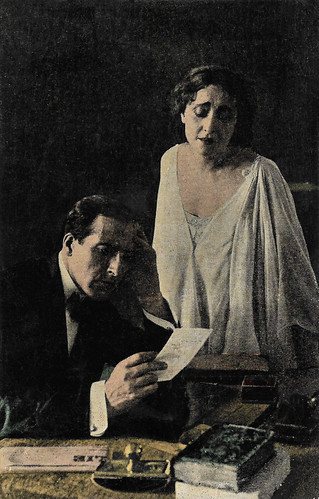
Spanish collectors card by Chocolat Imperiale, no. 4. Lyda Borelli in Il dramma di una notte/The Drama of One Night aka Una notte a Calcutta/One Night in Calcutta (Mario Caserini 1918). El drama de una noche, the Spanish release title, was released in Spain during WWI by the company José Muntañola, Barcelona. The man here next to Borelli, playing Guido, for sure is not Capozzi nor Pavanelli. Actually, he is the same protagonist from Borelli's film Carnevalesca, but alas Vittorio Martinelli's reference books Il cinema muto italiano mix up names for both films, so we still don't know who he is. An enigma...
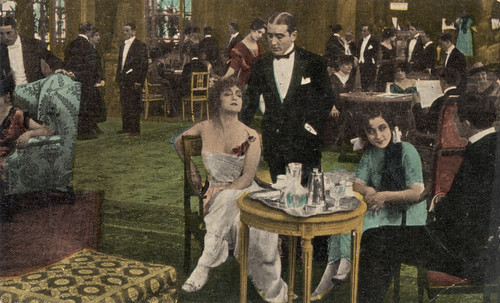
Spanish collectors card by Chocolat Imperiale, no. 5. Lyda Borelli in Il dramma di una notte/The Drama of One Night aka Una notte a Calcutta/One Night in Calcutta (Mario Caserini 1918). El drama de una noche, the Spanish release title, was released in Spain during WWI by the company José Muntañola, Barcelona. Here Borelli sits in a classic Borellian pose, while the man behind here is Augusto Poggioli. The girl is Anna Rocchi.
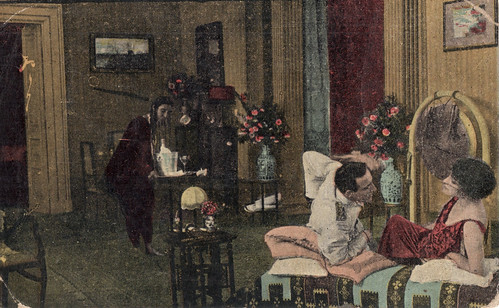
Spanish collectors card by Chocolat Imperiale, no. 6. Lyda Borelli in Il dramma di una notte/The Drama of One Night aka Una notte a Calcutta/One Night in Calcutta (Mario Caserini 1918). El drama de una noche, the Spanish release title, was released in Spain during WWI by the company José Muntañola, Barcelona.
Sources: Vittorio Martinelli (Il cinema muto italiano, Vol. 1917), , and plot on the back of the cards.
Rapsodia satanica (1917)

Spanish collectors card by Chocolate Imperiale, no. 1 of 6 cards. Photo: J. Muntañola, Barcelona / Cines. Lyda Borelli , and Ugo Bazzini in Rapsodia satanica (Nino Oxilia, 1917).

Spanish collectors card by Chocolate Imperiale, no. 2 of 6 cards. Photo: J. Muntañola, Barcelona / Cines. Lyda Borelli , Giovanni Cini, and Andrea Habay in Rapsodia satanica (Nino Oxilia, 1917).

Spanish collectors card by Chocolate Imperiale, no. 3 of 6 cards. Photo: J. Muntañola, Barcelona / Cines. Lyda Borelli and Giovanni Cini in Rapsodia satanica (Nino Oxilia, 1917).
In Rapsodia satanica/Satan's Rhapsody (Nino Oxilia, 1917), the old Contessa Alba d'Oltrevita ( Lyda Borelli ) deplores her faded youth after a party at her castle. Mephisto (Ugo Bazzini) steps out of a painting and offers her a pact: if she denies love, he will make her young again. She destroys a statuette of Love to conform her renouncement (yet, the sculpture was not entirely broken).
Alba changes into youthful splendour and enjoys the company of young men, in particular the two brothers Tristano and Sergio. Sergio is head over heels in love with her, but she laughs him off. During a costumed ball, in which Alba is dressed as Salome, she gets a note from Sergio, telling her to come out at midnight or he will kill himself. The capricious Alba then seduces Tristano and forces him to choose: either he or his brother will have her. He goes mad and prevents her from going outside.
A shot is heard: Sergio has killed himself. Tristano and Alba are shocked, she pushes him away and closes the castle to mourn her loss. After a while she notices Spring has arrived and revives, covering her rooms with flowers. At nighttime, she notices there is a cavalier on the hills. Could it be Tristano returning? She dresses up like a priestess and goes outside, expecting her lover. But instead, it is Mephisto who punishes her for falling in love and changes her back into the old lady. When seeing herself in the pond, she dies of a heart attack.
As Anthony Kobal writes on IMDb , "Rapsodia Satanica was the last film directed by Nino Oxilia [who was killed in action in 1917] and is undoubtedly one of the finest achievements of the early Italian cinema. In it, Oxilia spins a variation on the Faust myth, embodied here by the diva Lyda Borelli . Typical of extravagant D'Annunzian aestheticism at its height, Rapsodia Satanica was one of the summits of what was later called the "tail coat film." Diametrically opposed to the "cinema of reality" practiced by Serena, Martoglio, and others, "tail coat films" set their melodramatic stories in the salons and villas of the upper-middle class and the aristocracy, deploying narrative structures contrived to showcase their actors and especially its actresses. This had the effect of accentuating their physical presence and turning them into stars - probably the first stars in movie history. The success of the "diva" contributed to the development of motion picture grammar in its special use of the close-up."
This is the first and only film to feature a score written especially for it by famous composer Pietro Mascagni. While already in 1914 Oxilia had started shooting, in 1915 Mascagni was involved and additional footage was shot to please the maestro. While the film was ready that year, it still took two more years to be released, in a reduced and not very successful version.
Only in the 1980s, the film was rediscovered. It was e.g. included in the Dutch retrospective 'Hartstocht en heldendom: Il primo cinema italiano, 1905-1945' (1988), co-organised by Ivo Blom and Nelly Voorhuis. It was still a black-and-white version then, but in 1996 a part monochrome tinted and toned, and part hand-colored version was found at the Cinémathèque Suisse in Lausanne. Thanks to the film archives of Bologna, Milan, and Lausanne the film was analog restored. In 2015 the film was digitally restored in 4K by Bologna and Lausanne. In 2018 Cineteca di Bologna released the 4-films-DVD Dive!, which includes Rapsodia satanica, with the music by Mascagni.

Spanish collectors card by Chocolate Imperiale, no. 4 of 6 cards. Photo: J. Muntañola, Barcelona / Cines. Lyda Borelli and Giovanni Cini in Rapsodia satanica (Nino Oxilia, 1917).

Spanish collectors card by Chocolate Imperiale, no. 5 of 6 cards. Photo: J. Muntañola, Barcelona / Cines. Andrea Habay , Giovanni Cini, and Lyda Borelli in Rapsodia satanica (Nino Oxilia, 1917).

Spanish collectors card by Chocolate Imperiale, no. 6 of 6 cards. Photo: J. Muntañola, Barcelona / Cines. Lyda Borelli in Rapsodia satanica (Nino Oxilia, 1917).
La storia dei tredici (1917)

Spanish collectors card by Chocolate Imperiale, no. 1 of 6 cards. Photo: J. Muntañola, Barcelona / Cines. Lyda Borelli in La storia dei tredici (Carmine Gallone, 1917).

Spanish collectors card by Chocolate Imperiale, no. 3 of 6 cards. Photo: J. Muntañola, Barcelona / Cines. Ugo Piperno in La storia dei tredici (Carmine Gallone, 1917).
La storia dei tredici/The Thirteenth Man (Carmine Gallone, 1917) was made after a script by Lucio d'Ambra based on 'La duchesse de Langeais', one of the three volumes of Honoré de Balzac's tripartite novel 'L'histoire des treize' (1833-39), which appeared as 'Ferragus', 'La duchesse de Langeais' and 'La fille aux yeux d'or'.
A poet, a sculptor, a philosopher, an astronomist, a painter, a musician, and seven other men of culture and pleasure, tired of the joys of wealth, youth, and ardor, unite to heighten their existence under the motto of One for All and All for One. Yet, love is banned. In an ordinary house, they recreate the most ancient pleasures: the court of Pericles, the gardens of Arcadia, etc.
But one of them betrays the pact, falling in love with the Duchess of Langeais ( Lyda Borelli ). In order to find out who is the trespasser, Count Cent'Anni (Ugo Piperno) orders Montriveaux (Sandro Salvini), the only one who was never in love, to find the guilty one. Yet, it is Montriveaux himself who loves the duchess and who now perseveres with even more ardor the austere virtue of the duchess.
But the friends suspect betrayal and have the duchess abducted. In a masked session, they menace to torture in a cruel way by threatening the duchess with a fire-reddened cross of Lorraine on her forehead. Montriveaux goes berserk and stops the act, betraying himself and is derided. The duchess is escorted home, but when she finds out her persisting lover was the masked man who saved her, her love dies and she decides to join a convent.
Meanwhile, Montriveaux suffers too. Because of the cynic egoism of the Thirteen two lovers have been split, and when remorse sets in, they find out it is too late. Restless, Montriveaux travels all over Europe with Cent'Anni. Finally, at a convent in Spain, they hear an angelic voice in the choir: it is hers. When they plan a second abduction, they find the body of the duchess, whose heart could not take it any longer. But love is stronger than death, the duchess resuscitates, and the lovers are reunited.
La storia dei tredici had its premiere in Rome on 13 October 1917. In 1917, Ugo Ugoletti wrote in the Roman journal Cine-gazzetto that normally film adaptations of literary classics often fail because of a too close following of content and style, but that in this case screenwriter Lucio d'Ambra had well transformed the literary source in a script well fit to the medium of cinema and its popular audience. By just keeping the center of the action, D'Ambra had made a very free adaptation of the novel, the only thing Ugoletti wrote should have been indicated.
On the performance of the actors, he wrote: "Even if not perfect on the whole, the performance by Lyda Borelli is laudable - she is the exquisite animator of unforgettable scenes - in which she shows all of her talent and attraction. In particular, in certain close-ups she managed to reach expressions of marvelous efficacy." Ugoletti also praised the other two actors Salvini and Piperno, the latter marked as 'truly delicious".
Together with Marcia nuziale (Carmine Gallone, 1915), La storia dei tredici is one of the lost films with Lyda Borelli. While most films of Borelli survive, or at least fragments remain (La falena, La dramma di una notte), from this film no footage resurfaced, despite the opening up of film archives in the past decades.

Spanish collectors card by Chocolate Imperiale, no. 4 of 6 cards. Photo: J. Muntañola, Barcelona / Cines. Lyda Borelli in La storia dei tredici (Carmine Gallone, 1917). The man right of Borelli may be the actor Sandro Salvini, the male lead of the film.

Spanish collectors card by Chocolate Imperiale, no. 5 of 6 cards. Photo: J. Muntañola, Barcelona / Cines. Lyda Borelli in La storia dei tredici (Carmine Gallone, 1917).

Spanish collectors card by Chocolate Imperiale, no. 6 of 6 cards. Photo: J. Muntañola, Barcelona / Cines. Lyda Borelli in La storia dei tredici (Carmine Gallone, 1917).
Il dramma di una notte/Una notte a Calcutta (1918)

Spanish collectors card by Chocolat Imperiale, no. 1. Lyda Borelli in Il dramma di una notte/The Drama of One Night aka Una notte a Calcutta/One Night in Calcutta (Mario Caserini 1918). El drama de una noche, the Spanish release title, was released in Spain during WWI by the company José Muntañola, Barcelona. Here we also see Anna Rocchi as Nelly's sister Daisy.

Spanish collectors card by Chocolat Imperiale, no. 3. Lyda Borelli in Il dramma di una notte/The Drama of One Night aka Una notte a Calcutta/One Night in Calcutta (Mario Caserini 1918). El drama de una noche, the Spanish release title, was released in Spain during WWI by the company José Muntañola, Barcelona.
The story of Il dramma di una notte/The Drama of One Night aka Una notte a Calcutta/One Night in Calcutta (Mario Caserini 1918) is about marine officer Guido (unknown actor, in older sources mistakenly indicated as Alberto Capozzi), who returns to Italy to meet his brother's future wife and recognizes Nelly ( Lyda Borelli ), an 'easy' woman, he once had a story with, in a house of vice in India.
At the time, Nelly took care of her mother and younger sister Daisy (Anna Rocchi). After her mother's death, Nelly repents, returns to Italy, and learns to love with sincerity: Riccardo (Livio Pavanelli).
Nelly begs, then threatens Guido not to tell his brother, but finally accepts to leave without a trace. When she is on her own, she scratches herself with a venous Indian nail varnish she wears and thus kills herself.
This was Lyda Borelli 's final film before she married count Vittorio Cini and retired from public life, both the stage and the screen. Il dramma di una notte is a lost film, but a short fragment resurfaced recently at EYE Filmmuseum.

Spanish collectors card by Chocolat Imperiale, no. 4. Lyda Borelli in Il dramma di una notte/The Drama of One Night aka Una notte a Calcutta/One Night in Calcutta (Mario Caserini 1918). El drama de una noche, the Spanish release title, was released in Spain during WWI by the company José Muntañola, Barcelona. The man here next to Borelli, playing Guido, for sure is not Capozzi nor Pavanelli. Actually, he is the same protagonist from Borelli's film Carnevalesca, but alas Vittorio Martinelli's reference books Il cinema muto italiano mix up names for both films, so we still don't know who he is. An enigma...

Spanish collectors card by Chocolat Imperiale, no. 5. Lyda Borelli in Il dramma di una notte/The Drama of One Night aka Una notte a Calcutta/One Night in Calcutta (Mario Caserini 1918). El drama de una noche, the Spanish release title, was released in Spain during WWI by the company José Muntañola, Barcelona. Here Borelli sits in a classic Borellian pose, while the man behind here is Augusto Poggioli. The girl is Anna Rocchi.

Spanish collectors card by Chocolat Imperiale, no. 6. Lyda Borelli in Il dramma di una notte/The Drama of One Night aka Una notte a Calcutta/One Night in Calcutta (Mario Caserini 1918). El drama de una noche, the Spanish release title, was released in Spain during WWI by the company José Muntañola, Barcelona.
Sources: Vittorio Martinelli (Il cinema muto italiano, Vol. 1917), , and plot on the back of the cards.
Published on June 06, 2022 22:00
June 5, 2022
Ossi Oswalda
Ossi Oswalda (1895-1947) was one of the most popular comediennes of German silent cinema. Ernst Lubitsch became her Pygmalion, who let her play in numerous comedies between 1916 and 1920. Her popularity at the time earned her the nickname 'The German Mary Pickford'.

French postcard in the Europe series, no. 590. Photo: Agence Européenne Cinematographique. Ossi Oswalda in Das Mädel auf der Schaukel/The girl on the swing (Felix Basch, 1926).

German postcard by Ross Verlag, Berlin, no. 529/1, 1919-1924. Photo: Ossi Oswalda-Film.
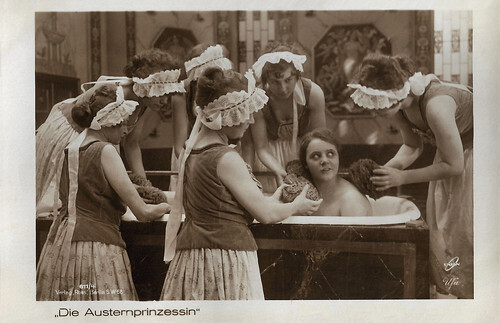
German postcard by Ross Verlag, Berlin, no. 611/4. Photo: Union / Ufa. Ossi Oswalda in Die Austernprinzessin/The Oyster Princess (Ernst Lubitsch, 1919).
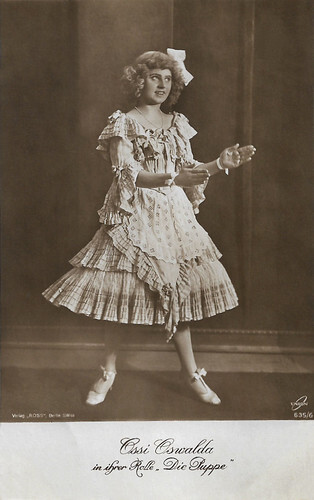
German postcard by Ross Verlag, Berlin, no. 635/6. Photo: Union. Ossi Oswalda in Die Puppe/The Doll (Ernst Lubitsch, 1919).
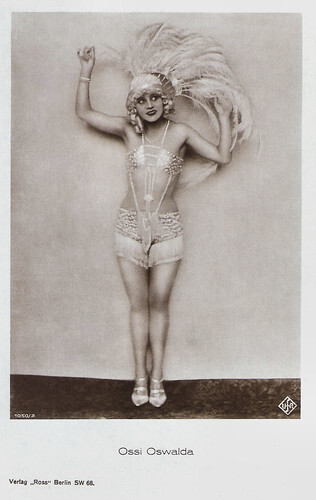
German postcard by Ross Verlag, Berlin, no. 1050/2, 1927-1928. Photo: Ufa. Ossi Oswalda in Blitzzug der Liebe/The Cupid Express (Johannes Guter, 1925).
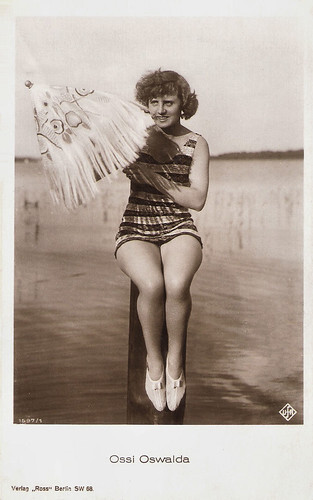
German postcard by Ross Verlag, Berlin, no. 1597/1, 1927-1928. Photo: Ufa.
Ernst Lubitsch
Ossi Oswalda (1895-1947) was born in Niederschönhausen, Imperial Germany (now part of Berlin), but she was of Prague origin. Her real name was Oswalda Stäglich.
Oswalda trained as a ballerina and became a dancer for a theater in Berlin.
She made her film debut in Nächte des Grauens/Night of Horrors (Richard Oswald, Arthur Robison, 1916) before being discovered by the actor and screenwriter Hanns Kräly.
He recommended her to director Ernst Lubitsch who cast her in their comedy Schuhpalast Pinkus/Shoe Salon Pinkus (1916).
Lubitsch became her Pygmalion, who let her play in numerous comedies between 1916 and 1920, which joked with the provincial and stiff petty-bourgeois mentality of Wilhelminian Germany.
Examples are Ossis Tagebuch/Ossi's Diary (1917), Ich möchte kein Mann sein/I Don't Want to Be a Man (1918), Meine Frau, die Filmschauspielerin/My Wife the Movie Star (1919), and Die Puppe/The Doll (1919).
The best of these was Die Austernprinzessin/The Oyster Princess (1919), in which Ossi is a spoiled daughter of a wealthy American, who is supposed to wed an impoverished German prince (but is marrying his stupid servant instead).
The whole film exaggerated all the clichés about Americans who like everything big and make modern, absurdistic music, and about Germans who are only interested in food & drinks, but Lubitsch did so in a very witty way.
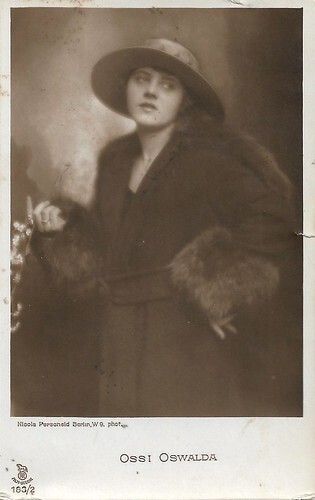
German postcard by Rotophot in the Film-Sterne series, no. 183/2. Photo: Nicola Perscheid.
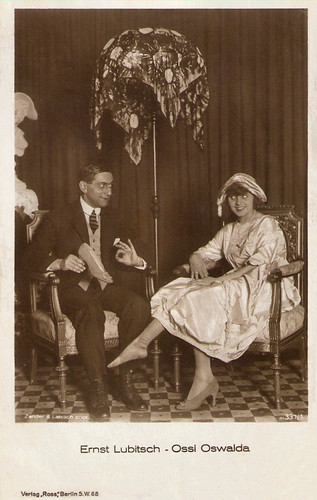
With Ernst Lubitsch. German postcard by Ross Verlag, Berlin, no. 337/1, 1919-1924. Photo: Zander & Labisch.
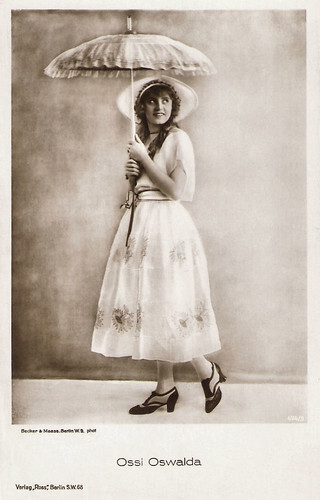
German postcard by Ross Verlag, Berlin, no. 474/3, 1919-1924. Photo: Becker & Maass, Berlin.
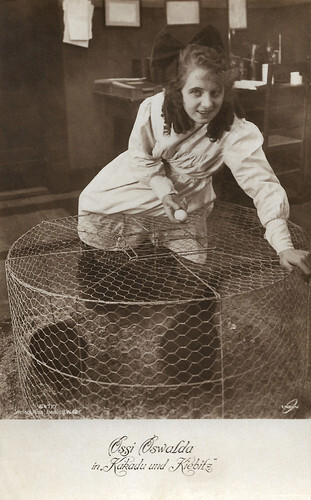
German postcard by Ross Verlag, Berlin, no. 641/7. Photo: Union. Ossi Oswalda in Kakadu und Kieblitz/Kakadu and Kiebitz (Erich Schönfelder, 1920).
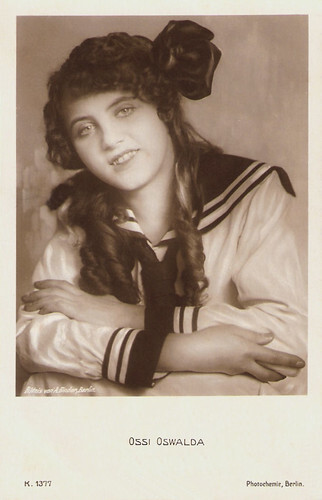
German postcard by Photochemie, Berlin, no. K. 1377. Photo: Alex Binder.
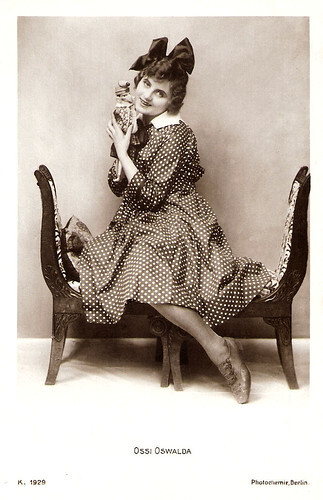
German postcard by Photochemie, Berlin, no. K. 1929.
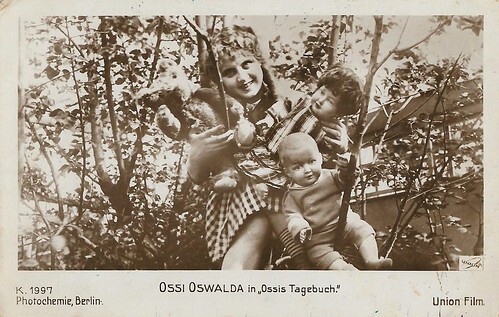
German postcard by Photochemie, Berlin, no. K. 1997. Photo: Union Film. Ossi Oswalda in Ossi's Tagebuch/Ossi's Diary (Ernst Lubitsch, 1917).
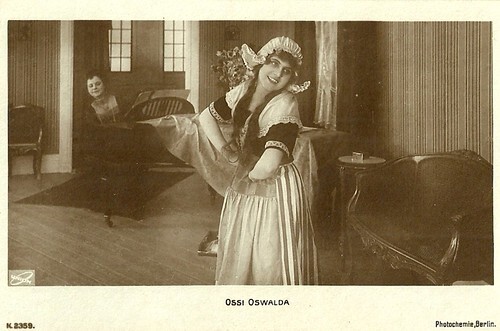
German postcard by Photochemie, Berlin, no. K. 2359. Photo: Union Film. Ossi Oswalda in (probably) Das Mädel vom Ballett/Ther Ballet Girl (Ernst Lubitsch, 1918). The actress in the back is Margarethe Kupfer.
Unrestrained, Wild and Witty Girl
When Ernst Lubitsch left for America he left Ossi Oswalda in the hands of Victor Janson , who had been her co-star in Die Wohnungsnot/The Housing Shortage (Ernst Lubitsch, 1920) and Kakadu und Kiebitz/Kakadu and Kiebitz (Erich Schönfelder, 1920).
Janson was not unworthy for his task but he repeated Oswalda's typology of the unrestrained, wild and witty girl, without adding the spice Lubitsch always had added.
In 1921, Oswalda started her own film production company with her husband at the time, Baron Gustav von Koczian.
However, during the next four years, they only produced four films, including Amor am Steuer/Love at the Wheel (Victor Janson, 1921) and Das Mädel mit der Maske/The Girl With the Mask (Victor Janson, 1922) with Hermann Thimig .
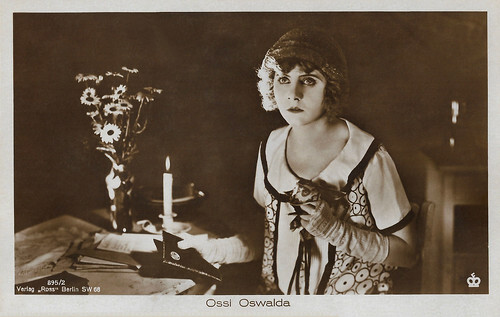
German postcard by Ross Verlag, Berlin, no. 895/2, 1925-1926. Photo: Ossi Oswalda-Film-Prod. Ossi Oswalda in Colibri (Viktor Janson, 1924).

German postcard by Ross Verlag, no. 30/2. Photo: Ufa. Ossi Oswalda and Ernst Hofmann in Blitzzug der Liebe/The Cupid Express (Johannes Guter, 1925).
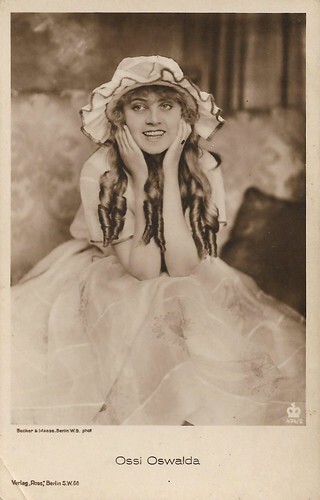
German postcard by Ross Verlag, Berlin, no. 474/2. Photo: Becker & Maass, Berlin.
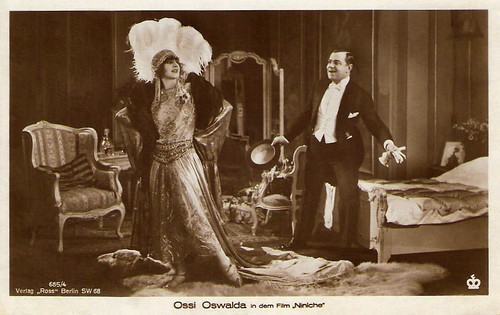
German postcard by Ross Verlag, Berlin, no. 685/4, 1919-1924. Photo: publicity still for Niniche (Victor Janson, 1925).
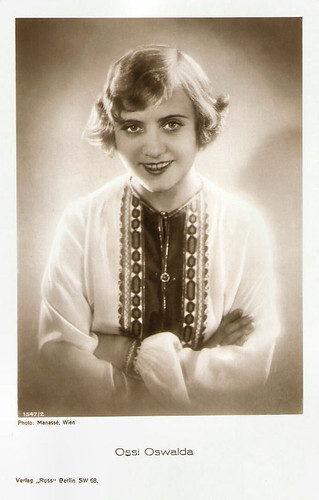
German postcard by Ross Verlag, no. 1347/2, 1927-1928. Photo: Manassé, Wien.
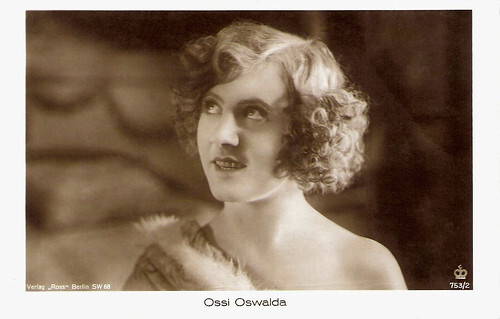
German postcard by Ross Verlag, Berlin, no. 753/2, 1925-1926.
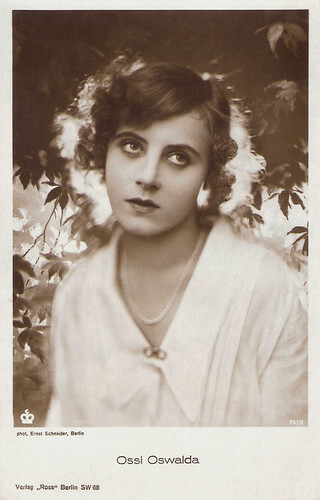
German postcard by Ross Verlag, Berlin, no. 761/2, 1925-1926. Photo: Ernst Schneider, Berlin.
Crown Prince
From 1925 on, Ossi Oswalda was contracted to the Ufa. She starred in comedies like Blitzzug der Liebe/Love Express Train (Johannes Guter, 1925) and Herrn Filip Collins Abenteuer/Mr. Filip Collins Adventure (Johannes Guter, 1926) with Georg Alexander .
When Oswalda's name was romantically linked to that of former Crown Prince Wilhelm, while that of Lily Damita with the prince's son Ludwig Ferdinand, insulting caricatures spread, and the Hohenzollern family stopped both affairs short.
The affair also influenced Oswalda's career, who continued to make films but she would never reach the top anymore. Her star dwindled down, and her parts became smaller and smaller.
She appeared in only two sound films, making her final film appearance in Der Stern von Valencia/The Star of Valencia (Alfred Zeisler, 1933).
Later on, she became a stage actor, and in 1943, she wrote the story for the Czechoslovakian film Ctrnáctý u stolu (Oldrich Nový, Antonín Zelenka, 1943).
For a short while, Ossi Oswalda was the talk of the town again once more, after she had died in the most miserable condition in Prague in 1947.
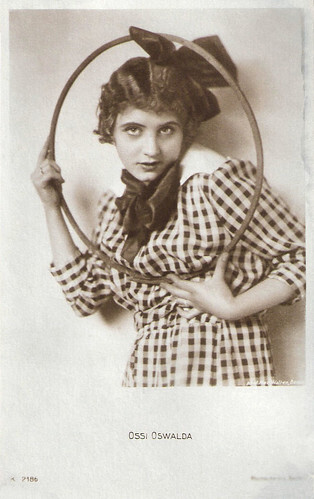
German postcard by Photochemie, Berlin, no. K. 2186. Photo: Mac Walten, Berlin.
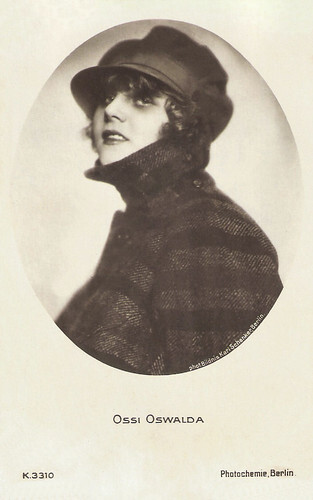
German postcard by Photochemie, Berlin, no. K. 3310. Photo: Karl Schenker, Berlin.
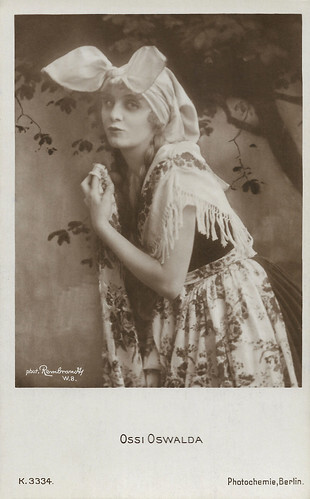
German postcard by Photochemie, Berlin, no. K. 3334. Photo: Rembrandt.
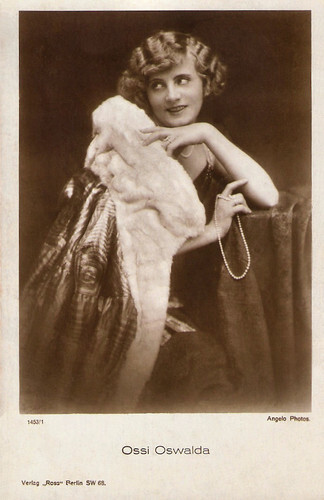
German postcard by Ross Verlag, Berlin, no. 1453/1, 1927-1928. Photo: Angelo Photos.
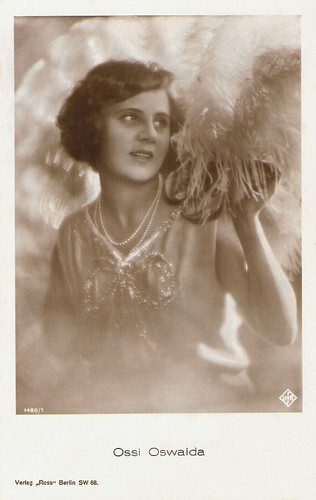
German postcard by Ross Verlag, Berlin, no. 1480/1, 1927-1928. Photo: Ufa.
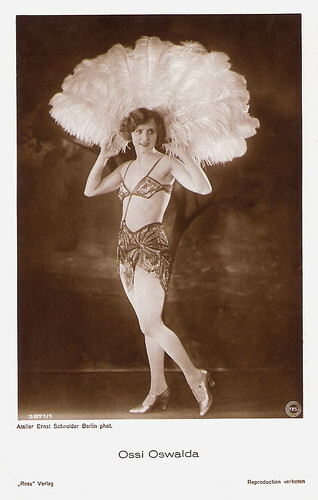
German postcard by Ross Verlag, Berlin, no. 3871/1, 1928-1929. Photo: Atelier Ernst Schneider, Berlin / FPS.
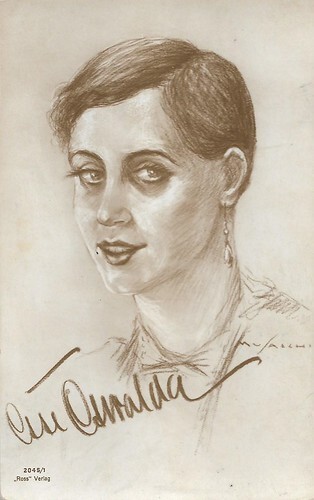
German postcard by Ross Verlag, Berlin, no. 2045/1. Portrait of Ossi Oswalda, sketched by the Italian caricaturist Cesare Musacchio (1882-1956).

German postcard by Westi, Berlin. Photo: Westi Film. Ossi Oswalda and Livio Pavanelli in Niniche (Victor Janson, 1925). The postcard was sent by mail in 1925.
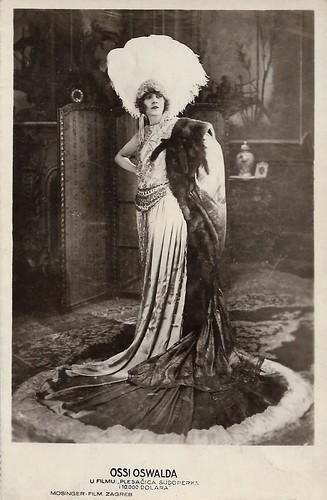
Croatian (former Kingdom of Yugoslavia) postcard. Mosinger-Film, Zagreb. Jos Caklovic, Zagreb, No. 43. Ossi Oswalda in Niniche (Victor Janson, 1925).
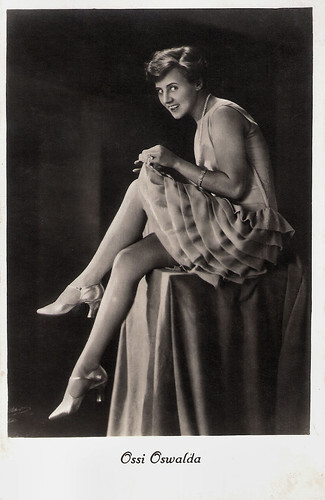
German postcard by H.C. Stöckel, Hannover-Linden, for Bemberg Strümpfen. Caption: I only dance through life with Bemberg stockings. Ossi Oswalda.
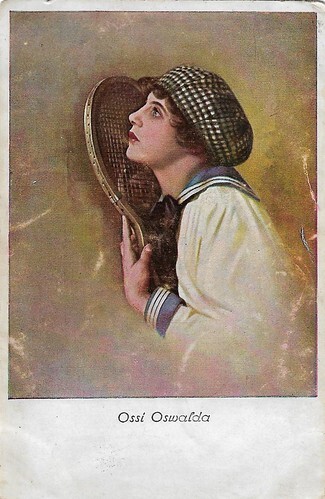
German postcard in the Moderne Künstler series by MMB, no. 462. Photo: F.J. Wesselsky.
Source: Vittorio Martinelli (Le dive del silenzio - Italian), Wikipedia, and .

French postcard in the Europe series, no. 590. Photo: Agence Européenne Cinematographique. Ossi Oswalda in Das Mädel auf der Schaukel/The girl on the swing (Felix Basch, 1926).

German postcard by Ross Verlag, Berlin, no. 529/1, 1919-1924. Photo: Ossi Oswalda-Film.

German postcard by Ross Verlag, Berlin, no. 611/4. Photo: Union / Ufa. Ossi Oswalda in Die Austernprinzessin/The Oyster Princess (Ernst Lubitsch, 1919).

German postcard by Ross Verlag, Berlin, no. 635/6. Photo: Union. Ossi Oswalda in Die Puppe/The Doll (Ernst Lubitsch, 1919).

German postcard by Ross Verlag, Berlin, no. 1050/2, 1927-1928. Photo: Ufa. Ossi Oswalda in Blitzzug der Liebe/The Cupid Express (Johannes Guter, 1925).

German postcard by Ross Verlag, Berlin, no. 1597/1, 1927-1928. Photo: Ufa.
Ernst Lubitsch
Ossi Oswalda (1895-1947) was born in Niederschönhausen, Imperial Germany (now part of Berlin), but she was of Prague origin. Her real name was Oswalda Stäglich.
Oswalda trained as a ballerina and became a dancer for a theater in Berlin.
She made her film debut in Nächte des Grauens/Night of Horrors (Richard Oswald, Arthur Robison, 1916) before being discovered by the actor and screenwriter Hanns Kräly.
He recommended her to director Ernst Lubitsch who cast her in their comedy Schuhpalast Pinkus/Shoe Salon Pinkus (1916).
Lubitsch became her Pygmalion, who let her play in numerous comedies between 1916 and 1920, which joked with the provincial and stiff petty-bourgeois mentality of Wilhelminian Germany.
Examples are Ossis Tagebuch/Ossi's Diary (1917), Ich möchte kein Mann sein/I Don't Want to Be a Man (1918), Meine Frau, die Filmschauspielerin/My Wife the Movie Star (1919), and Die Puppe/The Doll (1919).
The best of these was Die Austernprinzessin/The Oyster Princess (1919), in which Ossi is a spoiled daughter of a wealthy American, who is supposed to wed an impoverished German prince (but is marrying his stupid servant instead).
The whole film exaggerated all the clichés about Americans who like everything big and make modern, absurdistic music, and about Germans who are only interested in food & drinks, but Lubitsch did so in a very witty way.

German postcard by Rotophot in the Film-Sterne series, no. 183/2. Photo: Nicola Perscheid.

With Ernst Lubitsch. German postcard by Ross Verlag, Berlin, no. 337/1, 1919-1924. Photo: Zander & Labisch.

German postcard by Ross Verlag, Berlin, no. 474/3, 1919-1924. Photo: Becker & Maass, Berlin.

German postcard by Ross Verlag, Berlin, no. 641/7. Photo: Union. Ossi Oswalda in Kakadu und Kieblitz/Kakadu and Kiebitz (Erich Schönfelder, 1920).

German postcard by Photochemie, Berlin, no. K. 1377. Photo: Alex Binder.

German postcard by Photochemie, Berlin, no. K. 1929.

German postcard by Photochemie, Berlin, no. K. 1997. Photo: Union Film. Ossi Oswalda in Ossi's Tagebuch/Ossi's Diary (Ernst Lubitsch, 1917).

German postcard by Photochemie, Berlin, no. K. 2359. Photo: Union Film. Ossi Oswalda in (probably) Das Mädel vom Ballett/Ther Ballet Girl (Ernst Lubitsch, 1918). The actress in the back is Margarethe Kupfer.
Unrestrained, Wild and Witty Girl
When Ernst Lubitsch left for America he left Ossi Oswalda in the hands of Victor Janson , who had been her co-star in Die Wohnungsnot/The Housing Shortage (Ernst Lubitsch, 1920) and Kakadu und Kiebitz/Kakadu and Kiebitz (Erich Schönfelder, 1920).
Janson was not unworthy for his task but he repeated Oswalda's typology of the unrestrained, wild and witty girl, without adding the spice Lubitsch always had added.
In 1921, Oswalda started her own film production company with her husband at the time, Baron Gustav von Koczian.
However, during the next four years, they only produced four films, including Amor am Steuer/Love at the Wheel (Victor Janson, 1921) and Das Mädel mit der Maske/The Girl With the Mask (Victor Janson, 1922) with Hermann Thimig .

German postcard by Ross Verlag, Berlin, no. 895/2, 1925-1926. Photo: Ossi Oswalda-Film-Prod. Ossi Oswalda in Colibri (Viktor Janson, 1924).

German postcard by Ross Verlag, no. 30/2. Photo: Ufa. Ossi Oswalda and Ernst Hofmann in Blitzzug der Liebe/The Cupid Express (Johannes Guter, 1925).

German postcard by Ross Verlag, Berlin, no. 474/2. Photo: Becker & Maass, Berlin.

German postcard by Ross Verlag, Berlin, no. 685/4, 1919-1924. Photo: publicity still for Niniche (Victor Janson, 1925).

German postcard by Ross Verlag, no. 1347/2, 1927-1928. Photo: Manassé, Wien.

German postcard by Ross Verlag, Berlin, no. 753/2, 1925-1926.

German postcard by Ross Verlag, Berlin, no. 761/2, 1925-1926. Photo: Ernst Schneider, Berlin.
Crown Prince
From 1925 on, Ossi Oswalda was contracted to the Ufa. She starred in comedies like Blitzzug der Liebe/Love Express Train (Johannes Guter, 1925) and Herrn Filip Collins Abenteuer/Mr. Filip Collins Adventure (Johannes Guter, 1926) with Georg Alexander .
When Oswalda's name was romantically linked to that of former Crown Prince Wilhelm, while that of Lily Damita with the prince's son Ludwig Ferdinand, insulting caricatures spread, and the Hohenzollern family stopped both affairs short.
The affair also influenced Oswalda's career, who continued to make films but she would never reach the top anymore. Her star dwindled down, and her parts became smaller and smaller.
She appeared in only two sound films, making her final film appearance in Der Stern von Valencia/The Star of Valencia (Alfred Zeisler, 1933).
Later on, she became a stage actor, and in 1943, she wrote the story for the Czechoslovakian film Ctrnáctý u stolu (Oldrich Nový, Antonín Zelenka, 1943).
For a short while, Ossi Oswalda was the talk of the town again once more, after she had died in the most miserable condition in Prague in 1947.

German postcard by Photochemie, Berlin, no. K. 2186. Photo: Mac Walten, Berlin.

German postcard by Photochemie, Berlin, no. K. 3310. Photo: Karl Schenker, Berlin.

German postcard by Photochemie, Berlin, no. K. 3334. Photo: Rembrandt.

German postcard by Ross Verlag, Berlin, no. 1453/1, 1927-1928. Photo: Angelo Photos.

German postcard by Ross Verlag, Berlin, no. 1480/1, 1927-1928. Photo: Ufa.

German postcard by Ross Verlag, Berlin, no. 3871/1, 1928-1929. Photo: Atelier Ernst Schneider, Berlin / FPS.

German postcard by Ross Verlag, Berlin, no. 2045/1. Portrait of Ossi Oswalda, sketched by the Italian caricaturist Cesare Musacchio (1882-1956).

German postcard by Westi, Berlin. Photo: Westi Film. Ossi Oswalda and Livio Pavanelli in Niniche (Victor Janson, 1925). The postcard was sent by mail in 1925.

Croatian (former Kingdom of Yugoslavia) postcard. Mosinger-Film, Zagreb. Jos Caklovic, Zagreb, No. 43. Ossi Oswalda in Niniche (Victor Janson, 1925).

German postcard by H.C. Stöckel, Hannover-Linden, for Bemberg Strümpfen. Caption: I only dance through life with Bemberg stockings. Ossi Oswalda.

German postcard in the Moderne Künstler series by MMB, no. 462. Photo: F.J. Wesselsky.
Source: Vittorio Martinelli (Le dive del silenzio - Italian), Wikipedia, and .
Published on June 05, 2022 22:00
June 4, 2022
Written by Alexandre Dumas père
Alexandre Dumas père (1802-1870) was a French dramatist and writer of mainly historical novels such as 'The Three Musketeers. He also wrote articles for newspapers and magazines and left an extensive correspondence. He is the father of Alexandre Dumas fils, who was also a writer, including the famous work 'La Dame aux camélias' and about whom EFSP will dedicate a post next week.
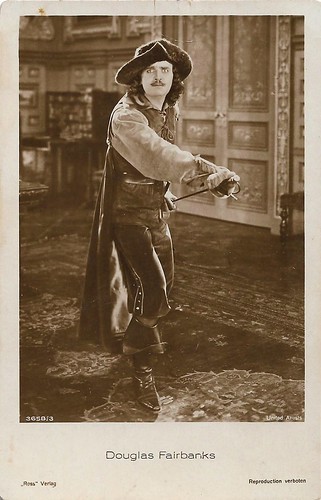
German postcard. Ross Verlag, No. 3658/3. United Artists. The card depicts a moment in The Three Musketeers (Fred Niblo, 1921), but stems from when Douglas Fairbanks made the sequel to The Three Musketeers: The Iron Mask (Allan Dwan, 1929).
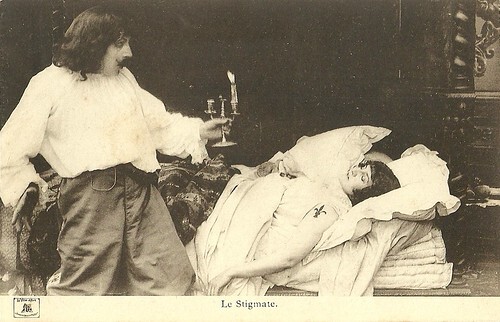
French postcard for the two-part film Les trois mousquetaires (Henry Pouctal, André Calmettes, 1912-1913). Caption: The Stigmata. The film starred Emile Dehelly as D'Artagnan and Nelly Cormon as Milady. The sets were by Emile Bertin.
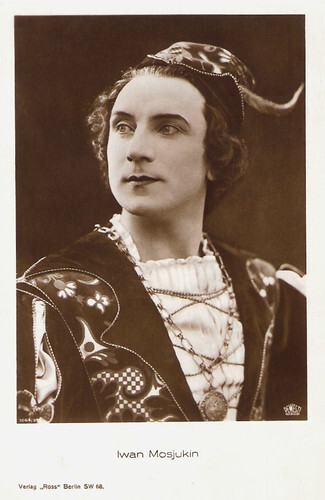
German postcard by Ross Verlag, no. 1064/3, 1927-1928. Photo: DeWesti Film-Verleih. Ivan Mozzhukhin in Kean (Alexandre Volkoff, 1924).
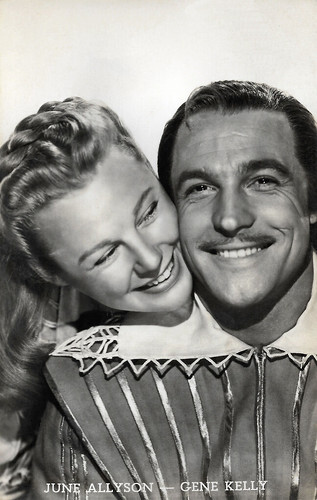
Dutch postcard by van Leer's Fotodrukindustrie N.V., Amsterdam, no. 351, no. 6. Photo: Metro Goldwyn Mayer (M.G.M.). June Allyson and Gene Kelly in The Three Musketeers (George Sidney, 1948).
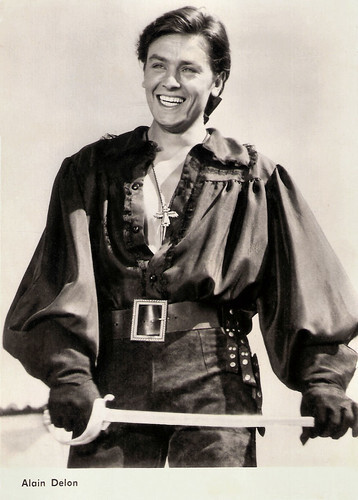
East-German postcard by VEB Progress Film-Vertrieb, Berlin, no. 2480, 1965. Photo: Alain Delon in La tulipe noire/The Black Tulip (Christian-Jaque, 1964).
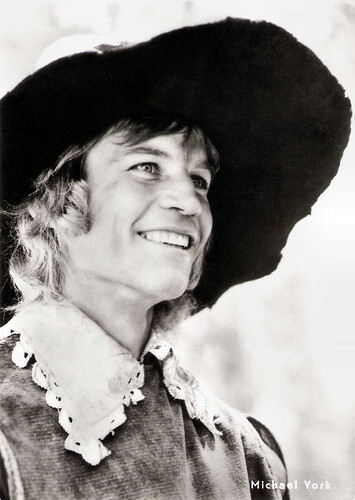
East-German postcard by Progress Film-Verleih, Berlin, no. 115/76. Photo: Michael York in The Three Musketeers (Richard Lester, 1973).
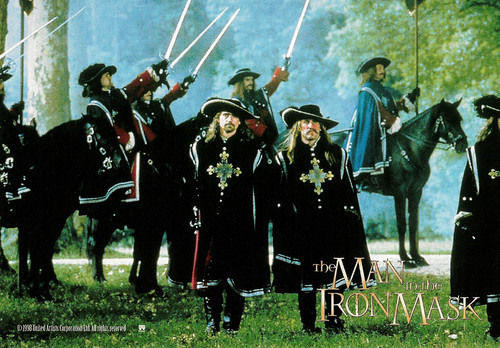
French postcard by Sonis, no. C. 853. Photo: United Artists. Gérard Depardieu and Jeremy Irons in The Man in the Iron Mask (Randall Wallace, 1998).
The first great success of the romantic drama
Alexandre Davy de La Pailleterie Dumas was born in Villers-Cotterêts (Aisne) in 1802. His father, the French general Thomas Alexandre Dumas, was the son of Antoine Alexandre Davy, marquis de La Pailleterie, and his mother was Marie-Louise-Elisabeth Labouret. In 1806, his father died of a stomach ailment, and Alexandre grew up in rather poor circumstances. The only - rather rudimentary - education he received was from a priest. In spite of this, the young Dumas showed a quick and sharp mind and broadened his knowledge by devouring books.
Dumas initially worked as a third clerk for a local notary but dreamed of Paris. He decided to break with his employer to try his luck in the capital and found a job as a copyist at the Duke of Orléans' secretariat. Dumas began a relationship with a young divorced linen seamstress from Rouen, Marie-Cathérine Labay, with whom he would have a son in 1824, Alexandre Dumas fils, who would also become a writer. Dumas only acknowledged his son in 1831 and acquired custody of his son after a court case. Dumas' mother also moved in with her son during this period and continued to live with him until her death in 1868.
His literary work initially consisted mainly of vaudeville plays and melodramas, which he wrote in collaboration with his friend Adolphe de Leuven, the son of an exiled Swedish nobleman. Their first play, 'La Chasse et l'Amour', was shown in 1825. He also had a hand in another vaudeville piece, entitled 'La noce et l'enterrement'. At first, Dumas had little success. His first great success came in 1829 with the play 'Henri III et sa cour', which can be considered as the first great success of the romantic drama.
The greats of the romantic movement such as Victor Hugo and Alfred de Vigny noticed him. The Duke of Orléans, who had attended the performance, hired Dumas as a librarian at the Palais Royal. Dumas' first success was followed by another successful play, 'Christine' (1830), about Christina of Sweden. These successes made it possible for Dumas to live off his pen and give up his job.
Dumas played an active role in the revolution of 1830, which brought his former employer, the Duke of Orléans, to the throne as the Citizen King Louis Philippe. The revolution caused Dumas to leave the literary scene for a while. He was sent by La Fayette on several missions. However, Dumas became more and more estranged from the government and was even told that it would be good for him to leave France for a while, but Dumas would maintain a close relationship with the Duke of Orléans until his death in 1850.
During this period Dumas still had many successes, for instance with the plays 'Antony' (1831), which was resumed one hundred and thirty times, and 'La Tour de Nesle' (1832). The successes also meant a change of lifestyle for the young writer. He made a good impression, dressed eccentrically, and travelled extensively. In 1840 he married the actress Ida Ferrier, allegedly at the instigation of the Duke of Orléans or through financial manipulation. The marriage, however, did not change Dumas' lifestyle in any way.
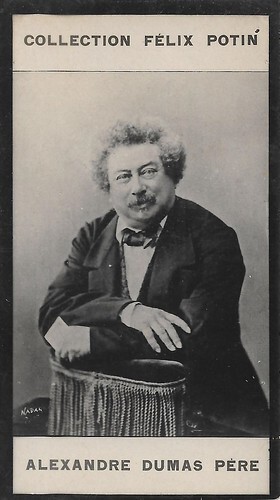
Vintage French minicard in the Collection Felix Potin. Photo: Nadar. Portrait of the writer Alexandre Dumas père.
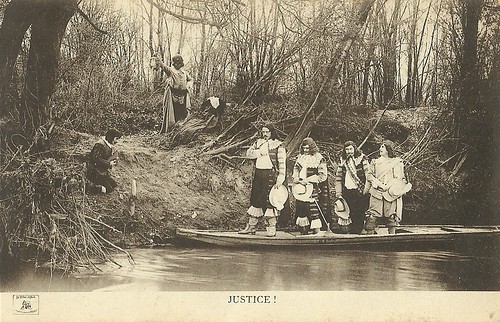
French postcard for the two-part film Les trois mousquetaires (Henry Pouctal, André Calmettes, 1912-1913). Caption: Justice!
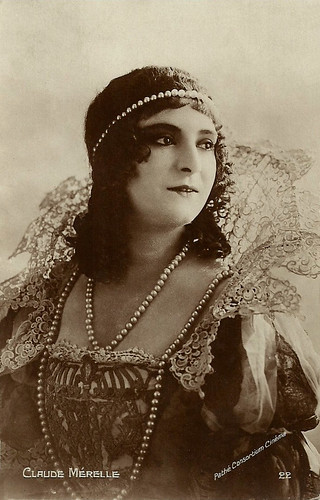
French postcard by Editions Cinémagazine, no. 22. Photo: Pathé Consortium Cinéma. Claude Mérelle as the evil Milady de Winter in Les trois mousquetaires/The Three Musketeers (Henri Diamant-Berger 1921).
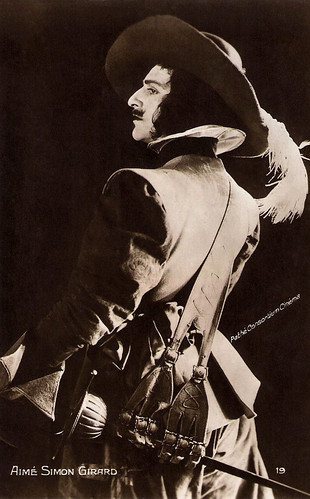
French postcard by Editions Cinémagazine, no. 19. Photo: Pathé Consortium Cinéma. Aimé Simon-Girard as D'Artagnan in Les Trois Mousquetaires/The Three Musketeers (Henri Diamant-Berger, 1921).
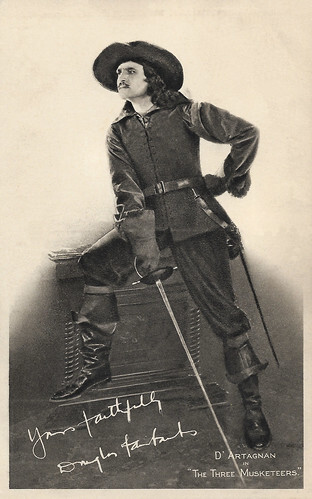
British postcard by Cinema Art LTD, London. Douglas Fairbanks as D'Artagnan in The Three Musketeers (Fred Niblo, 1921).
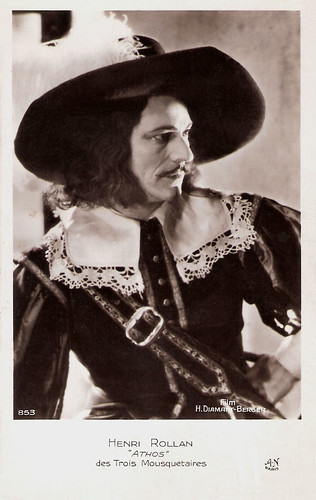
French postcard by A.N., Paris no. 853. Photo: Film H. Diamant-Berger. Henri Rollan as Athos in Les Trois Mousquetaires/The Three Musketeers (Henri Diamant-Berger, 1932).
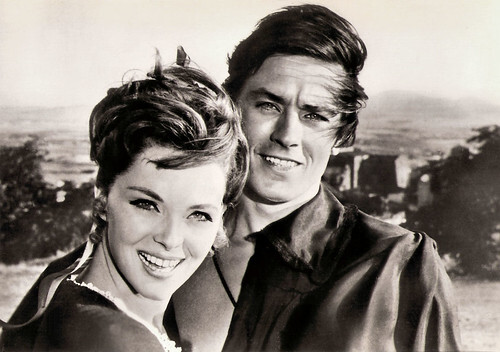
East-German postcard by VEB Progress Filmvertrieb, Berlin, no. 2481, 1965. Photo: Alain Delon and Virna Lisi in La tulipe noire/The Black Tulip (Christian-Jacque, 1964).
His unbridled imagination and fighting spirit
Alexandre Dumas was not content with playwriting alone. His unbridled imagination and fighting spirit urged him to devote himself to the novel as well. One of Dumas' first attempts at a novel was 'Le capitaine Paul' (1838), a reworking of one of his plays, which he had published as a serial in a newspaper. In the period 1839-1841, Dumas worked with some friends on an eight-volume collection of essays on famous criminals and crimes from European history, including essays on Cesare and Lucrezia Borgia, but also on more recent figures such as Karl Ludwig Sand.
The attention to history is amply reflected in Dumas' best-known novels. Through his friend, the poet Gérard de Nerval, Dumas met the history teacher Auguste Maquet in 1839. The two men entered into a cooperation agreement, whereby Maquet would provide the necessary material for the novels and Dumas would mould the facts into the form of a novel in his own lively way.
The first product of the collaboration was the grand novel 'Les Trois Mousquetaires' (The Three Musketeers) (8 volumes, 1844), based on the memoirs of d'Artagnan written by Gatien de Courtilz de Sandras. The novel tells the adventures of D'Artagnan, Athos, Porthos, and Aramis, who together take on Cardinal de Richelieu for Anna of Austria.
The admirers of this novel were delighted with two sequels, 'Vingt Ans Après' in 1845 (Twenty Years Later) and 'Le Vicomte de Bragelonne ou Dix ans plus tard' from 1848 (The Viscount of Bragelonne or Ten Years Later), of which the third and last part, 'The Man in the Iron Mask', is the most famous. The success of 'The Three Musketeers' was overwhelming, so much so that Dumas was asked if it could also be shown on stage. Dumas was reluctant at first because of several stage failures he had suffered. In the end, however, he gave in, largely on the basis of financial gain.
Immediately after 'The Three Musketeers', in 1844-1845, Dumas published another successful work: 'Le Comte de Monte-Cristo' (The Count of Monte-Christo). While writing this novel, Dumas had a new whim: he had to have a castle that would bear the name Monte-Cristo. And so it came to pass: the castle was built in Le Port-Marly.
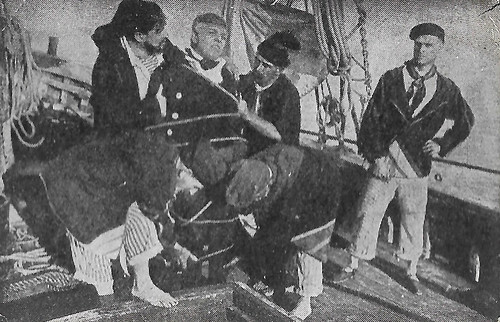
French postcard. Photo: Film d'Art. Léon Mathot as the title character in the French silent serial film Le Comte de Monte-Cristo (Henri Pouctal, 1918).
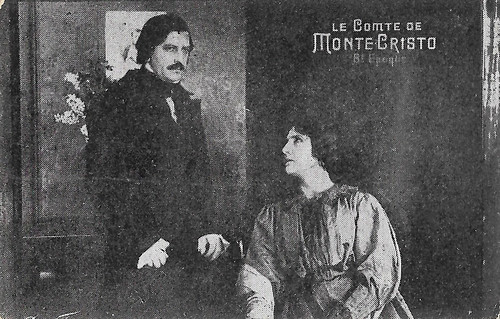
Spanish minicards by Chocolate Amatller, Marca Luna, Series 2. Photo: Film d'Art/Pathé Frères. Léon Mathot as Edmond Dantès/The Count of Monte-Cristo, and Nelly Cormon as Mercedes in Le Comte de Monte-Cristo/The Count of Monte Cristo (Henri Pouctal, 1918).
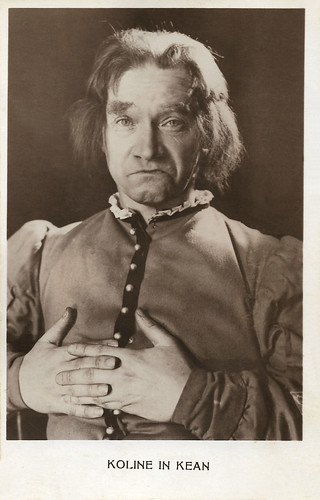
German postcard. Photo: Nicolas Koline in Kean/Edmund Kean: Prince Among Lovers (Alexander Volkov, 1924).
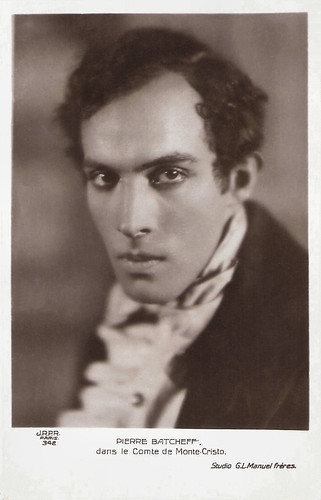
French postcard by J.R.P.R., Paris, no. 348. Photo: Studio G.L. Manuel Frères. Pierre Batche ff in Le Comte de Monte-Christo/Monte Cristo (Henri Fescourt, 1929).
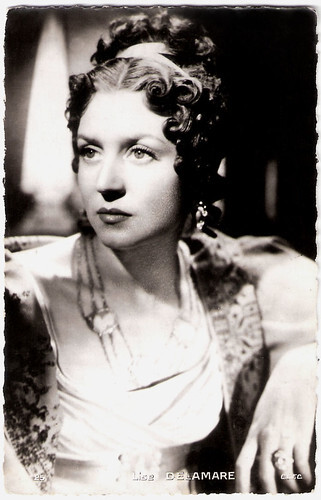
French postcard by Ed. Chantal, Rueil, no. 25. Photo: C.E.F.C. Lise Delamare in Le Comte de Monte-Cristo/The Count of Monte Christo (Robert Vernay, 1943).

French postcard by A.N., Paris, no. 439. Photo: Engberg. Marcelle Chantal , aka Marcelle Jefferson-Cohn, as the Countess de la Motte in Le Collier de la reine/The Queen's Necklace (Tony Lekain, Gaston Ravel, 1929).
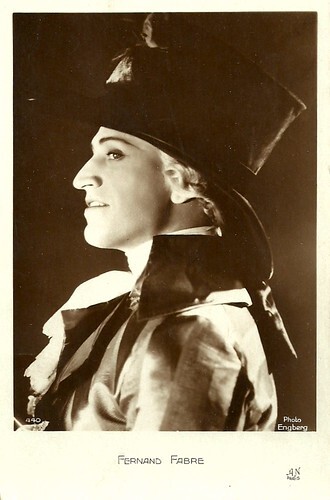
French postcard by A.N., Paris, no. 440. Photo: Engberg. Fernand Fabre as the Count de la Motte in Le collier de la reine/The Queen's Necklace (Tony Lekain, Gaston Ravel, 1929). The film was shot as a silent film, but a soundtrack with music was added afterward. Based loosely on the novel by Alexandre Dumas, The Queen's Necklace, itself inspired by the famous affair of the Queen's Necklace, the film shows Queen Marie-Antoinette (Diana Karenne) caught up in a nefarious plot hatched by the Countess de la Motte.
A castle filled with bums
Alexandre Dumas père is also known for the novels belonging to the Valois cycle. These include 'La Reine Margot' (Queen Margot) (6 volumes, 1845), 'La Dame de Monsoreau' (8 volumes, 1846), and 'Les Quarante-cinq' (10 volumes, 1847-48). Most of Dumas' novels appeared in several instalments in Parisian newspapers, with the aim of reaching the widest possible audience. Together with Eugène Sue, Dumas was one of the masters of the serial novel.
The collaboration between Dumas and Maquet was a very successful one, with Maquet's historical research work forming the basis of Dumas' storytelling. Dumas was a tireless worker and, as a result, the books followed one another in a very short period of time. The popularity of Dumas caused a lot of envy and he was portrayed as an advertising man who earns money at the expense of other hard-working writers. However, Dumas' creative input was of great importance to the final stories. The broad outlines of the stories were provided by Maquet or other writers, but it was Dumas who gave life to the stories by adding details and dialogues.
Dumas' great output in this period is largely explained by his extravagant lifestyle. He had many mistresses and lived on a grand scale. The construction of his castle, the Château de Monte-Cristo, was also an expensive affair. Moreover, Dumas filled the castle with a large number of bums who were only interested in profiting from Dumas and his money. This recklessly expensive way of life eventually left him penniless. His own theatre, the Théâtre Historique, also had to close its doors.
Dumas was very ambitious and sought recognition on several levels. He eagerly competed for a place in the Académie française and for a seat in the Assemblée Nationale. In the revolution year 1848, Dumas also wanted to play a role in politics. He founded the political and historical magazine Mois and made election speeches for a seat in the Chamber of Deputies for the department of Yonne.
In 1851, Dumas decided to move to the Belgian capital Brussels, partly to escape his creditors, but also because as a republican, he was not favoured by the new emperor Napoleon III. However, he did not stay long in Brussels. He returned to Paris at the end of 1853 and founded a newspaper, Le Mousquetaire. Dumas tried to persuade his son to write for the paper, but he refused. Le Mousquetaire survived only until 1857, partly because Dumas had again surrounded himself with a crowd of profiteers who contributed little to the magazine.
In 1858 Dumas fled Paris and the misfortunes he had suffered there, and made several trips. He travelled to Italy to take part in Garibaldi's struggle for independence. He even put his fortune at the disposal of the Italian independence fighter to buy weapons. As a reward, Garibaldi got him an appointment as museum director in Naples. After his four-year stay in Naples, Dumas returned to Paris. After this, Dumas' powers weakened and his successes faded. His plays and novels lost their appeal, partly because of the realism that reigned at the time. He still tried to cling to his faded fame in all kinds of new ways, but eventually, he sank into a kind of withdrawn resignation. Alexandre Dumas passed away in 1870 at his son's house in Puys, near Dieppe.
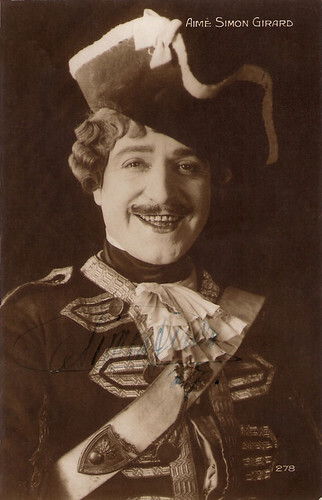
French postcard by Cinémagazine, no. 278. Aimé Simon-Girard .
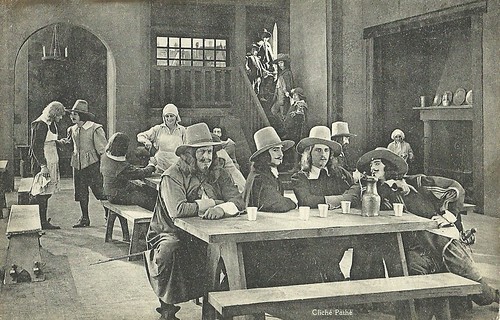
French postcard. Photo: Pathé. The three musketeers, Porthos ( Charles Martinelli ), Aramis ( Pierre de Guingand ) and Athos ( Henri Rollan ), and D'Artagnan (Jean Yonnel) in Vingt ans après/The Return of the Musketeers (Henri Diamant-Berger, 1922). In 1921, Henri Diamant-Berger directed Les Trois Mousquetaires and Vingt ans après (literally: Twenty Years After) was the sequel.
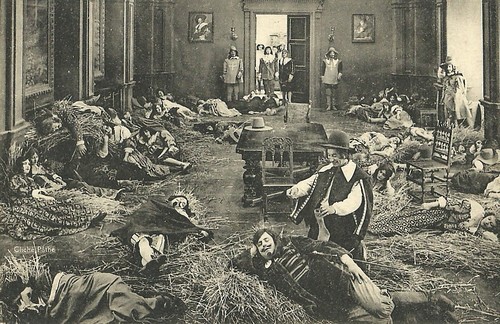
French postcard. Photo: Pathé. Porthos ( Charles Martinelli ) and his servant Planchet ( Armand Bernard ) in Vingt ans après/The Return of the Musketeers (Henri Diamant-Berger, 1922).
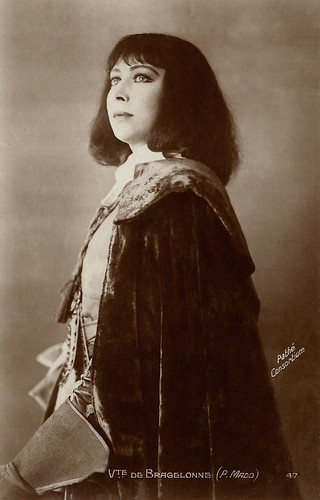
French postcard by Editions Cinémagazine, no. 47. Photo: Pathé Consortium. Pierrette Madd as Raoul, the Vicomte de Bragelonne in Vingt ans après/The Return of the Musketeers (Henri Diamant-Berger, 1922), the sequel to Les Trois mousquetaires/The Three Musketeers (Henri Diamant-Berger, 1921).
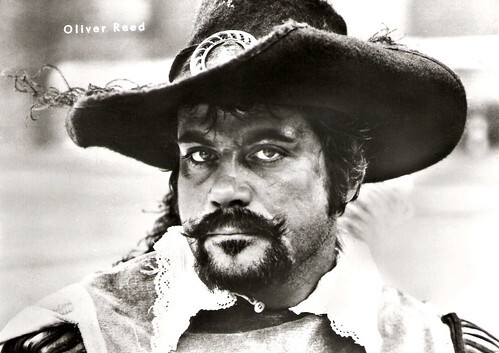
East-German postcard by Progress Film-Verleih, no. 19/77. Oliver Reed in The Four Musketeers (Richard Lester, 1974).
More than 200 times filmed
Alexandre Dumas' adventure novels are more than just entertainment literature. Most are both historical novels and feuilletons. Dumas published his novels in sections in the Parisian press. For his contemporaries, the historical novel was the modern form of the epic and Dumas was the master of the genre, thanks to his sense of action and plot twists, and the freedom he took when it came to historical facts. Liveliness and inspiration take precedence over the scrupulous safeguarding of historical accuracy. He combines freedom with historical truth, with attention to the picturesque and the couleur local.
Dumas' historical novels have been filmed more than 200 times. Serials based on his two best-known novels, 'The Three Musketeers' and 'The Count of Monte-Cristo', appeared continuously until 1930. Notable is the French silent film Les Trois Mousquetaires (1921), with Aimé Simon-Girard as d'Artagnan. One of the better-known American versions, The Three Musketeers, also dates from the same year, with Douglas Fairbanks in the role of D'Artagnan. A classic sound version dates from 1948, with Gene Kelly and Lana Turner as D'Artagnan and Milady, and supporting roles for Angela Lansbury and Vincent Price as Queen Anne and Cardinal Richelieu.
Richard Lester directed another version that consisted of two parts, starring Michael York as D'Artagnan, Oliver Reed as Athos, and Richard Chamberlain as Aramis. After The Three Musketeers in 1973, the aptly titled The Four Musketeers followed a year later. It starred Faye Dunaway (Milady), Charlton Heston (Richelieu), Christopher Lee (Rochefort), Geraldine Chaplin (Queen Anne), and Raquel Welch (Constance).
Dumas' own sequel to the heroic tale, 'Twenty Years Later', was a slightly less frequent film adaptation, but the best known was The Return of the Musketeers (Richard Lester, 1989) with much the same cast as the earlier Richard Lester films. Kim Cattrall was added to the cast as Milady's vengeful child.
In 1993, a Disney adaptation followed entitled The Three Musketeers, starring Charlie Sheen as Aramis, Kiefer Sutherland as Athos, Chris O'Donnell as D'Artagnan, Oliver Platt as Porthos, and Tim Curry as Cardinal Richelieu. The young Julie Delpy can be seen as Constance and Rebecca de Mornay as Milady de Winter. The film was a modest success, but the title song 'All for Love' sung by Sting , Rod Stewart, and co-writer Bryan Adams, was a worldwide hit.
The third book of Dumas' musketeer trilogy, 'The Vicomte de Bragelonne', is best known for the part about the Man with the Iron Mask. The best-known film adaptations of this chapter are the silent version The Iron Mask (Allan Dwan, 19239) starring Douglas Fairbanks , James Whale's The Man in the Iron Mask (1939), starring Louis Hayward and Joan Bennett , and The Man in the Iron Mask (Randall Wallace, 1998), starring Leonardo DiCaprio , Jeremy Irons, and Gérard Depardieu .

Dutch postcard by Foto Archief Film en Toneel, no. 3454. Photo: M.G.M. Van Heflin, Gene Kelly, Gig Young, and Robert Coote in The Three Musketeers (George Sidney, 1948), based on the novel by Alexandre Dumas.
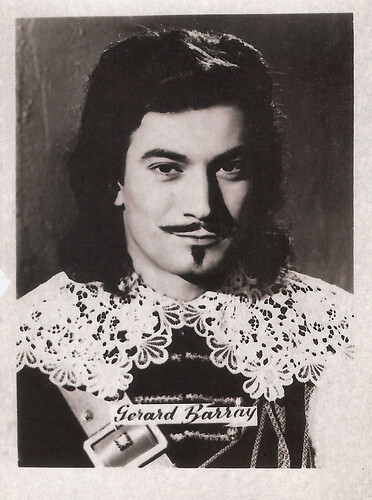
Small Romanian collectors card. Photo: Gérard Barray in Les trois mousquetaires/The Three Musketeers (Bernard Borderie, 1961).
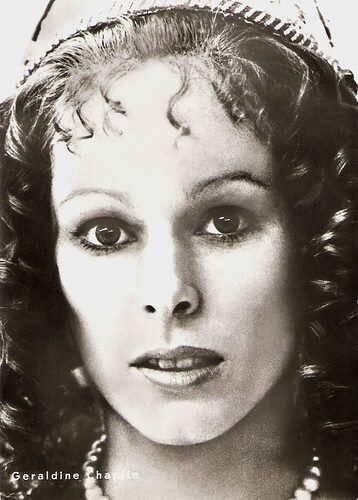
East-German postcard by VEB Progress Film-Vertrieb, Berlin, no. 65/75. Photo: Cinerama. Geraldine Chaplin as Queen Anna in The Three Musketeers (Richard Lester, 1973).
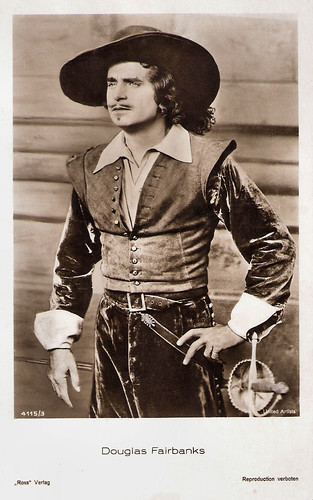
German postcard by Ross Verlag, no. 4115/3, 1929-1930. Photo: United Artists. Douglas Fairbanks in The Iron Mask (Allan Dwan, 1929).
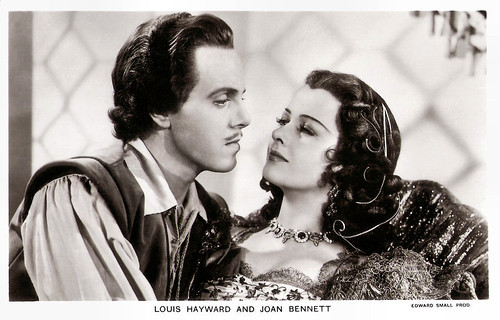
British postcard in the Film Partners Series, London, no. P. 306. Photo: Edward Small Prod. Louis Hayward and Joan Bennett in The Man in the Iron Mask (James Whale, 1939).
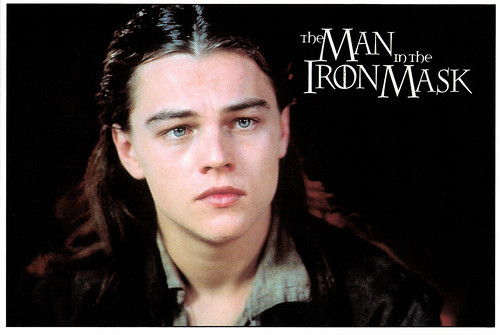
British postcard by the London Postcard Company, no. MG 2004 (Series 1 of 9), Portrait #3. Photo: United Artists. Leonardo DiCaprio as Phillippe in The Man in the Iron Mask (Randall Wallace, 1998).
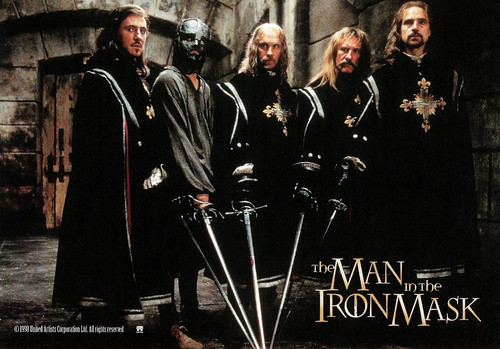
French postcard by Sonis, no. C. 854. Photo: United Artists. Gabriel Byrne, Leonardo DiCaprio , John Malkovich, Gérard Depardieu, and Jeremy Irons in The Man in the Iron Mask (Randall Wallace, 1998).
Sources: Wikipedia (Dutch), and IMDb.

German postcard. Ross Verlag, No. 3658/3. United Artists. The card depicts a moment in The Three Musketeers (Fred Niblo, 1921), but stems from when Douglas Fairbanks made the sequel to The Three Musketeers: The Iron Mask (Allan Dwan, 1929).

French postcard for the two-part film Les trois mousquetaires (Henry Pouctal, André Calmettes, 1912-1913). Caption: The Stigmata. The film starred Emile Dehelly as D'Artagnan and Nelly Cormon as Milady. The sets were by Emile Bertin.

German postcard by Ross Verlag, no. 1064/3, 1927-1928. Photo: DeWesti Film-Verleih. Ivan Mozzhukhin in Kean (Alexandre Volkoff, 1924).

Dutch postcard by van Leer's Fotodrukindustrie N.V., Amsterdam, no. 351, no. 6. Photo: Metro Goldwyn Mayer (M.G.M.). June Allyson and Gene Kelly in The Three Musketeers (George Sidney, 1948).

East-German postcard by VEB Progress Film-Vertrieb, Berlin, no. 2480, 1965. Photo: Alain Delon in La tulipe noire/The Black Tulip (Christian-Jaque, 1964).

East-German postcard by Progress Film-Verleih, Berlin, no. 115/76. Photo: Michael York in The Three Musketeers (Richard Lester, 1973).

French postcard by Sonis, no. C. 853. Photo: United Artists. Gérard Depardieu and Jeremy Irons in The Man in the Iron Mask (Randall Wallace, 1998).
The first great success of the romantic drama
Alexandre Davy de La Pailleterie Dumas was born in Villers-Cotterêts (Aisne) in 1802. His father, the French general Thomas Alexandre Dumas, was the son of Antoine Alexandre Davy, marquis de La Pailleterie, and his mother was Marie-Louise-Elisabeth Labouret. In 1806, his father died of a stomach ailment, and Alexandre grew up in rather poor circumstances. The only - rather rudimentary - education he received was from a priest. In spite of this, the young Dumas showed a quick and sharp mind and broadened his knowledge by devouring books.
Dumas initially worked as a third clerk for a local notary but dreamed of Paris. He decided to break with his employer to try his luck in the capital and found a job as a copyist at the Duke of Orléans' secretariat. Dumas began a relationship with a young divorced linen seamstress from Rouen, Marie-Cathérine Labay, with whom he would have a son in 1824, Alexandre Dumas fils, who would also become a writer. Dumas only acknowledged his son in 1831 and acquired custody of his son after a court case. Dumas' mother also moved in with her son during this period and continued to live with him until her death in 1868.
His literary work initially consisted mainly of vaudeville plays and melodramas, which he wrote in collaboration with his friend Adolphe de Leuven, the son of an exiled Swedish nobleman. Their first play, 'La Chasse et l'Amour', was shown in 1825. He also had a hand in another vaudeville piece, entitled 'La noce et l'enterrement'. At first, Dumas had little success. His first great success came in 1829 with the play 'Henri III et sa cour', which can be considered as the first great success of the romantic drama.
The greats of the romantic movement such as Victor Hugo and Alfred de Vigny noticed him. The Duke of Orléans, who had attended the performance, hired Dumas as a librarian at the Palais Royal. Dumas' first success was followed by another successful play, 'Christine' (1830), about Christina of Sweden. These successes made it possible for Dumas to live off his pen and give up his job.
Dumas played an active role in the revolution of 1830, which brought his former employer, the Duke of Orléans, to the throne as the Citizen King Louis Philippe. The revolution caused Dumas to leave the literary scene for a while. He was sent by La Fayette on several missions. However, Dumas became more and more estranged from the government and was even told that it would be good for him to leave France for a while, but Dumas would maintain a close relationship with the Duke of Orléans until his death in 1850.
During this period Dumas still had many successes, for instance with the plays 'Antony' (1831), which was resumed one hundred and thirty times, and 'La Tour de Nesle' (1832). The successes also meant a change of lifestyle for the young writer. He made a good impression, dressed eccentrically, and travelled extensively. In 1840 he married the actress Ida Ferrier, allegedly at the instigation of the Duke of Orléans or through financial manipulation. The marriage, however, did not change Dumas' lifestyle in any way.

Vintage French minicard in the Collection Felix Potin. Photo: Nadar. Portrait of the writer Alexandre Dumas père.

French postcard for the two-part film Les trois mousquetaires (Henry Pouctal, André Calmettes, 1912-1913). Caption: Justice!

French postcard by Editions Cinémagazine, no. 22. Photo: Pathé Consortium Cinéma. Claude Mérelle as the evil Milady de Winter in Les trois mousquetaires/The Three Musketeers (Henri Diamant-Berger 1921).

French postcard by Editions Cinémagazine, no. 19. Photo: Pathé Consortium Cinéma. Aimé Simon-Girard as D'Artagnan in Les Trois Mousquetaires/The Three Musketeers (Henri Diamant-Berger, 1921).

British postcard by Cinema Art LTD, London. Douglas Fairbanks as D'Artagnan in The Three Musketeers (Fred Niblo, 1921).

French postcard by A.N., Paris no. 853. Photo: Film H. Diamant-Berger. Henri Rollan as Athos in Les Trois Mousquetaires/The Three Musketeers (Henri Diamant-Berger, 1932).

East-German postcard by VEB Progress Filmvertrieb, Berlin, no. 2481, 1965. Photo: Alain Delon and Virna Lisi in La tulipe noire/The Black Tulip (Christian-Jacque, 1964).
His unbridled imagination and fighting spirit
Alexandre Dumas was not content with playwriting alone. His unbridled imagination and fighting spirit urged him to devote himself to the novel as well. One of Dumas' first attempts at a novel was 'Le capitaine Paul' (1838), a reworking of one of his plays, which he had published as a serial in a newspaper. In the period 1839-1841, Dumas worked with some friends on an eight-volume collection of essays on famous criminals and crimes from European history, including essays on Cesare and Lucrezia Borgia, but also on more recent figures such as Karl Ludwig Sand.
The attention to history is amply reflected in Dumas' best-known novels. Through his friend, the poet Gérard de Nerval, Dumas met the history teacher Auguste Maquet in 1839. The two men entered into a cooperation agreement, whereby Maquet would provide the necessary material for the novels and Dumas would mould the facts into the form of a novel in his own lively way.
The first product of the collaboration was the grand novel 'Les Trois Mousquetaires' (The Three Musketeers) (8 volumes, 1844), based on the memoirs of d'Artagnan written by Gatien de Courtilz de Sandras. The novel tells the adventures of D'Artagnan, Athos, Porthos, and Aramis, who together take on Cardinal de Richelieu for Anna of Austria.
The admirers of this novel were delighted with two sequels, 'Vingt Ans Après' in 1845 (Twenty Years Later) and 'Le Vicomte de Bragelonne ou Dix ans plus tard' from 1848 (The Viscount of Bragelonne or Ten Years Later), of which the third and last part, 'The Man in the Iron Mask', is the most famous. The success of 'The Three Musketeers' was overwhelming, so much so that Dumas was asked if it could also be shown on stage. Dumas was reluctant at first because of several stage failures he had suffered. In the end, however, he gave in, largely on the basis of financial gain.
Immediately after 'The Three Musketeers', in 1844-1845, Dumas published another successful work: 'Le Comte de Monte-Cristo' (The Count of Monte-Christo). While writing this novel, Dumas had a new whim: he had to have a castle that would bear the name Monte-Cristo. And so it came to pass: the castle was built in Le Port-Marly.

French postcard. Photo: Film d'Art. Léon Mathot as the title character in the French silent serial film Le Comte de Monte-Cristo (Henri Pouctal, 1918).

Spanish minicards by Chocolate Amatller, Marca Luna, Series 2. Photo: Film d'Art/Pathé Frères. Léon Mathot as Edmond Dantès/The Count of Monte-Cristo, and Nelly Cormon as Mercedes in Le Comte de Monte-Cristo/The Count of Monte Cristo (Henri Pouctal, 1918).

German postcard. Photo: Nicolas Koline in Kean/Edmund Kean: Prince Among Lovers (Alexander Volkov, 1924).

French postcard by J.R.P.R., Paris, no. 348. Photo: Studio G.L. Manuel Frères. Pierre Batche ff in Le Comte de Monte-Christo/Monte Cristo (Henri Fescourt, 1929).

French postcard by Ed. Chantal, Rueil, no. 25. Photo: C.E.F.C. Lise Delamare in Le Comte de Monte-Cristo/The Count of Monte Christo (Robert Vernay, 1943).

French postcard by A.N., Paris, no. 439. Photo: Engberg. Marcelle Chantal , aka Marcelle Jefferson-Cohn, as the Countess de la Motte in Le Collier de la reine/The Queen's Necklace (Tony Lekain, Gaston Ravel, 1929).

French postcard by A.N., Paris, no. 440. Photo: Engberg. Fernand Fabre as the Count de la Motte in Le collier de la reine/The Queen's Necklace (Tony Lekain, Gaston Ravel, 1929). The film was shot as a silent film, but a soundtrack with music was added afterward. Based loosely on the novel by Alexandre Dumas, The Queen's Necklace, itself inspired by the famous affair of the Queen's Necklace, the film shows Queen Marie-Antoinette (Diana Karenne) caught up in a nefarious plot hatched by the Countess de la Motte.
A castle filled with bums
Alexandre Dumas père is also known for the novels belonging to the Valois cycle. These include 'La Reine Margot' (Queen Margot) (6 volumes, 1845), 'La Dame de Monsoreau' (8 volumes, 1846), and 'Les Quarante-cinq' (10 volumes, 1847-48). Most of Dumas' novels appeared in several instalments in Parisian newspapers, with the aim of reaching the widest possible audience. Together with Eugène Sue, Dumas was one of the masters of the serial novel.
The collaboration between Dumas and Maquet was a very successful one, with Maquet's historical research work forming the basis of Dumas' storytelling. Dumas was a tireless worker and, as a result, the books followed one another in a very short period of time. The popularity of Dumas caused a lot of envy and he was portrayed as an advertising man who earns money at the expense of other hard-working writers. However, Dumas' creative input was of great importance to the final stories. The broad outlines of the stories were provided by Maquet or other writers, but it was Dumas who gave life to the stories by adding details and dialogues.
Dumas' great output in this period is largely explained by his extravagant lifestyle. He had many mistresses and lived on a grand scale. The construction of his castle, the Château de Monte-Cristo, was also an expensive affair. Moreover, Dumas filled the castle with a large number of bums who were only interested in profiting from Dumas and his money. This recklessly expensive way of life eventually left him penniless. His own theatre, the Théâtre Historique, also had to close its doors.
Dumas was very ambitious and sought recognition on several levels. He eagerly competed for a place in the Académie française and for a seat in the Assemblée Nationale. In the revolution year 1848, Dumas also wanted to play a role in politics. He founded the political and historical magazine Mois and made election speeches for a seat in the Chamber of Deputies for the department of Yonne.
In 1851, Dumas decided to move to the Belgian capital Brussels, partly to escape his creditors, but also because as a republican, he was not favoured by the new emperor Napoleon III. However, he did not stay long in Brussels. He returned to Paris at the end of 1853 and founded a newspaper, Le Mousquetaire. Dumas tried to persuade his son to write for the paper, but he refused. Le Mousquetaire survived only until 1857, partly because Dumas had again surrounded himself with a crowd of profiteers who contributed little to the magazine.
In 1858 Dumas fled Paris and the misfortunes he had suffered there, and made several trips. He travelled to Italy to take part in Garibaldi's struggle for independence. He even put his fortune at the disposal of the Italian independence fighter to buy weapons. As a reward, Garibaldi got him an appointment as museum director in Naples. After his four-year stay in Naples, Dumas returned to Paris. After this, Dumas' powers weakened and his successes faded. His plays and novels lost their appeal, partly because of the realism that reigned at the time. He still tried to cling to his faded fame in all kinds of new ways, but eventually, he sank into a kind of withdrawn resignation. Alexandre Dumas passed away in 1870 at his son's house in Puys, near Dieppe.

French postcard by Cinémagazine, no. 278. Aimé Simon-Girard .

French postcard. Photo: Pathé. The three musketeers, Porthos ( Charles Martinelli ), Aramis ( Pierre de Guingand ) and Athos ( Henri Rollan ), and D'Artagnan (Jean Yonnel) in Vingt ans après/The Return of the Musketeers (Henri Diamant-Berger, 1922). In 1921, Henri Diamant-Berger directed Les Trois Mousquetaires and Vingt ans après (literally: Twenty Years After) was the sequel.

French postcard. Photo: Pathé. Porthos ( Charles Martinelli ) and his servant Planchet ( Armand Bernard ) in Vingt ans après/The Return of the Musketeers (Henri Diamant-Berger, 1922).

French postcard by Editions Cinémagazine, no. 47. Photo: Pathé Consortium. Pierrette Madd as Raoul, the Vicomte de Bragelonne in Vingt ans après/The Return of the Musketeers (Henri Diamant-Berger, 1922), the sequel to Les Trois mousquetaires/The Three Musketeers (Henri Diamant-Berger, 1921).

East-German postcard by Progress Film-Verleih, no. 19/77. Oliver Reed in The Four Musketeers (Richard Lester, 1974).
More than 200 times filmed
Alexandre Dumas' adventure novels are more than just entertainment literature. Most are both historical novels and feuilletons. Dumas published his novels in sections in the Parisian press. For his contemporaries, the historical novel was the modern form of the epic and Dumas was the master of the genre, thanks to his sense of action and plot twists, and the freedom he took when it came to historical facts. Liveliness and inspiration take precedence over the scrupulous safeguarding of historical accuracy. He combines freedom with historical truth, with attention to the picturesque and the couleur local.
Dumas' historical novels have been filmed more than 200 times. Serials based on his two best-known novels, 'The Three Musketeers' and 'The Count of Monte-Cristo', appeared continuously until 1930. Notable is the French silent film Les Trois Mousquetaires (1921), with Aimé Simon-Girard as d'Artagnan. One of the better-known American versions, The Three Musketeers, also dates from the same year, with Douglas Fairbanks in the role of D'Artagnan. A classic sound version dates from 1948, with Gene Kelly and Lana Turner as D'Artagnan and Milady, and supporting roles for Angela Lansbury and Vincent Price as Queen Anne and Cardinal Richelieu.
Richard Lester directed another version that consisted of two parts, starring Michael York as D'Artagnan, Oliver Reed as Athos, and Richard Chamberlain as Aramis. After The Three Musketeers in 1973, the aptly titled The Four Musketeers followed a year later. It starred Faye Dunaway (Milady), Charlton Heston (Richelieu), Christopher Lee (Rochefort), Geraldine Chaplin (Queen Anne), and Raquel Welch (Constance).
Dumas' own sequel to the heroic tale, 'Twenty Years Later', was a slightly less frequent film adaptation, but the best known was The Return of the Musketeers (Richard Lester, 1989) with much the same cast as the earlier Richard Lester films. Kim Cattrall was added to the cast as Milady's vengeful child.
In 1993, a Disney adaptation followed entitled The Three Musketeers, starring Charlie Sheen as Aramis, Kiefer Sutherland as Athos, Chris O'Donnell as D'Artagnan, Oliver Platt as Porthos, and Tim Curry as Cardinal Richelieu. The young Julie Delpy can be seen as Constance and Rebecca de Mornay as Milady de Winter. The film was a modest success, but the title song 'All for Love' sung by Sting , Rod Stewart, and co-writer Bryan Adams, was a worldwide hit.
The third book of Dumas' musketeer trilogy, 'The Vicomte de Bragelonne', is best known for the part about the Man with the Iron Mask. The best-known film adaptations of this chapter are the silent version The Iron Mask (Allan Dwan, 19239) starring Douglas Fairbanks , James Whale's The Man in the Iron Mask (1939), starring Louis Hayward and Joan Bennett , and The Man in the Iron Mask (Randall Wallace, 1998), starring Leonardo DiCaprio , Jeremy Irons, and Gérard Depardieu .

Dutch postcard by Foto Archief Film en Toneel, no. 3454. Photo: M.G.M. Van Heflin, Gene Kelly, Gig Young, and Robert Coote in The Three Musketeers (George Sidney, 1948), based on the novel by Alexandre Dumas.

Small Romanian collectors card. Photo: Gérard Barray in Les trois mousquetaires/The Three Musketeers (Bernard Borderie, 1961).

East-German postcard by VEB Progress Film-Vertrieb, Berlin, no. 65/75. Photo: Cinerama. Geraldine Chaplin as Queen Anna in The Three Musketeers (Richard Lester, 1973).

German postcard by Ross Verlag, no. 4115/3, 1929-1930. Photo: United Artists. Douglas Fairbanks in The Iron Mask (Allan Dwan, 1929).

British postcard in the Film Partners Series, London, no. P. 306. Photo: Edward Small Prod. Louis Hayward and Joan Bennett in The Man in the Iron Mask (James Whale, 1939).

British postcard by the London Postcard Company, no. MG 2004 (Series 1 of 9), Portrait #3. Photo: United Artists. Leonardo DiCaprio as Phillippe in The Man in the Iron Mask (Randall Wallace, 1998).

French postcard by Sonis, no. C. 854. Photo: United Artists. Gabriel Byrne, Leonardo DiCaprio , John Malkovich, Gérard Depardieu, and Jeremy Irons in The Man in the Iron Mask (Randall Wallace, 1998).
Sources: Wikipedia (Dutch), and IMDb.
Published on June 04, 2022 22:00
June 3, 2022
Published by Vin Désiles
Vin Désiles is an alcohol-based tonic preparation resembling a kind of cinchona wine. The inventor was the Frenchman Alexandre Choffé. To promote his tonic a huge series of black and white postcards was published during the first decades of the 20th Century. Many actors were pictured for this series called 'Collection artistique du Vin Désiles', drinking a glass of le Vin Désiles. Film historian Ivo Blom loves to collect these vintage gems and we selected 20 of his Vin Désiles postcards for this post.
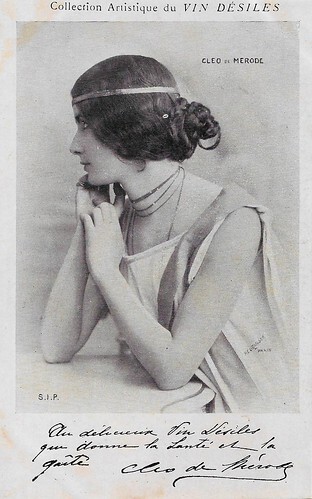
French postcard in the Collection artistique du Vin Désiles by S.I.P. Photo: Reutlinger. Caption: Au délicieux Vin Désiles qui donne la santé et la gaité (To the delicious Vin Désiles that gives health and cheerfulness).
Cleo de Mérode (1875-1966) was a French dancer of the Belle Époque. She has been referred to as the "first real celebrity icon" and the "first modern celebrity". She was also the first woman whose photographic image, due in particular to photographers Nadar and Léopold-Émile Reutlinger , was distributed worldwide.
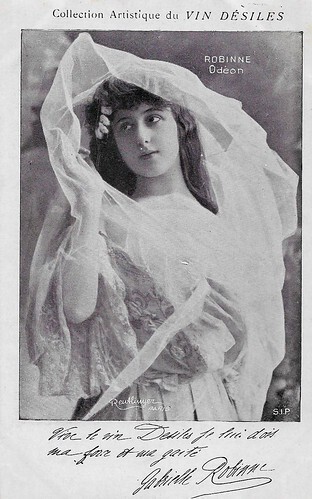
French postcard in the Collection artistique du Vin Désiles by S.I.P. Photo: Reutlinger. Caption: Vive le vin Désiles, je lui dois ma force et ma gaité. (Long live the Désiles wine, I owe my strength and cheerfulness to it).
Gabrielle Robinne (1886-1980) was a French stage and film actress, who had the peak of her film career in the 1910s.
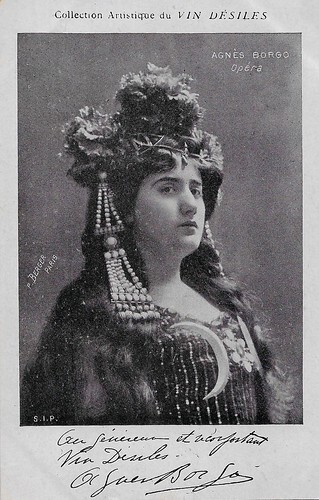
French postcard in the Collection artistique du Vin Désiles by S.I.P. Photo: Berger, Paris. Caption: Au généreux et réconfortant Vin Desiles (To the generous and comforting Vin Desiles.)
Agnès Borgo (1879-1958) was a Corsican soprano. This card depicts her in her attire for Ernest Reyer's opera 'Salammbo'.
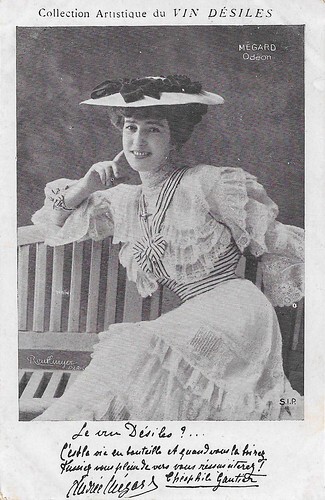
French postcard in the Collection artistique du Vin Désiles by S.I.P. Photo: Reutlinger. Caption: Le vin Desiles? C'est la vie en bouteille et quand vous le buvez, ... vous plein de vers vous réssusciterez! Theophile Gautier. (The Désiles wine? It is life in a bottle and when you drink it, ... with a full glass you will resurrect! Theophile Gautier.)
French actress and stage beauty Andrée Mégard (1869–1952) was on the Paris stage from 1896 to 1925, appearing in shows including Shakespearean tragedies, comedies, and plays directed by her husband, Firmin Gémier. She played the love interest, Roxane, in a 1913 revival of Edmond Rostand's 'Cyrano de Bergerac', while she was having an affair with Rostand himself. She appeared in one silent film, La tour de Nesle (1909). Mégard was considered "tall, graceful, and distinguished-looking." Her hairstyles and the designs of her costumes, hats, and gowns were reported in detail, internationally, often with photographs or drawings showing their features.
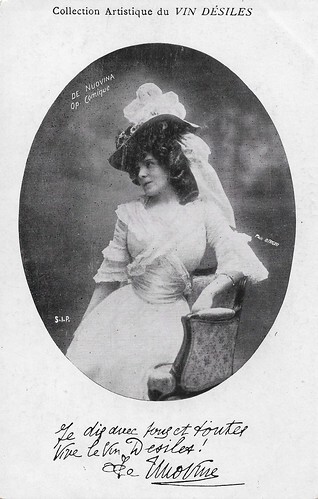
French postcard in the Collection artistique du Vin Désiles by S.I.P. Photo: Berger. Caption: Je dis avec tous et toutes: vive le vin Desiles! (I say with all: long live Desiles wine!).
Marguerite 'Zina' de Nuovina, originally Marguerite Lamandi nee Moldave (1865-1936) was a Romanian mezzosoprano, who debuted in 1889. Around 1900, she became a highly acclaimed singer in such operas as 'Carmen', 'Cavalleria rusticana' and 'Lohengrin'.
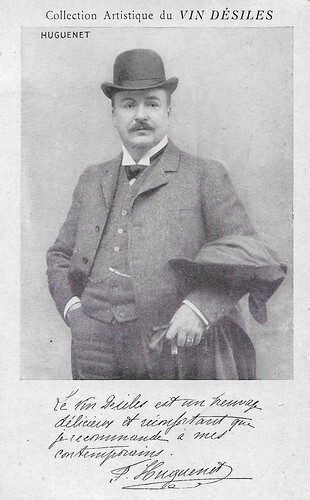
French postcard in the Collection artistique du Vin Désiles by S.I.P. Photo: Berger. Caption: Le Vin Desiles est un beuvage délicieux et réconfortant que je recommande à mes contemporains. (The Desiles wine is a delicious and comforting beverage that I recommend to my contemporaries).
Félix Huguenet (1858-1926) only stayed two years with the Comédie Française but he had a rich stage career between the 1880s and the 1920s. He played in four films, including Mademoiselle de La Seiglière (André Antoine, 1921).
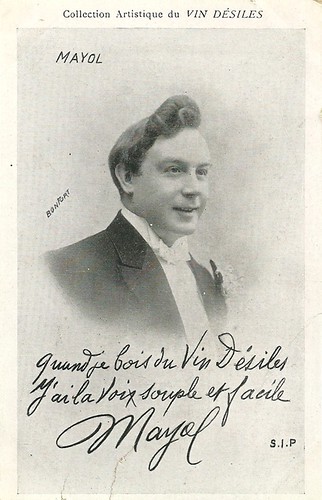
French postcard in the Collection Artistique du Vin Désiles by S.I.P. Photo: Bonfort. Caption: Whenever I drink Vin Désiles, my voice is flexible and easy.
Félix Mayol (1872-1941) was a popular French singer of the Belle Epoque. French Wikipedia lists some 120 songs. After a 1905 phonoscènes series at Gaumont, Mayol acted in five more films, three silent films, including Le filon du Bouif (Louis Osmont, 1922), and two early sound films, Aux urnes, citoyens!/Tu sera député (Jean Hémard, 1932) and La dame de chez Maxim's (Alexander Korda, 1933) starring Florelle.
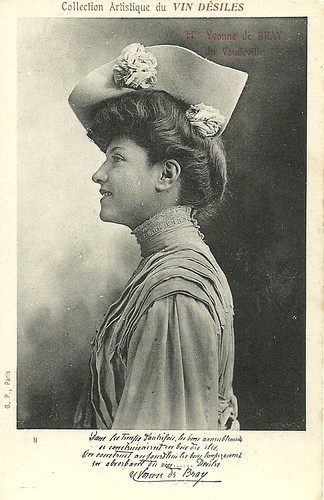
French postcard in the Collection Artistique de Vin Désiles by G.P., Paris, no. 8. Caption: Dans les temps d'autrefois, les bons ameublements on se construisaient en bois des îles, On construit aujourd’hui les bons tempéraments en absorbant du vin Désiles. (Once, they constructed good furniture from wood of the islands. Nowadays they construct good temper with Désiles wine).
Yvonne de Bray (1887-1954) was a French stage and screen actress, famous for her role as Sophie in Jean Cocteau's film Les parents terribles (1948).
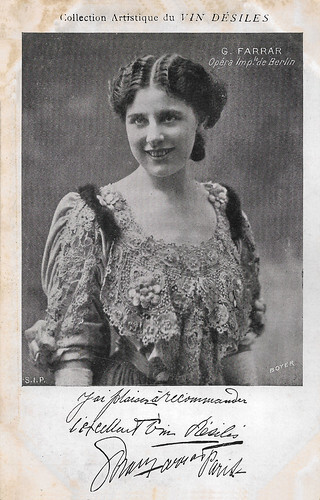
French postcard in the 'Collection Artistique du Vin Désiles' series by S.I.P. Photo: Boyer. Caption: I've the pleasure to recommend the excellent Désiles Wine, Geraldine Farrar, Imperial Opera of Berlin.
American soprano opera singer and film actress Geraldine Farrar (1882-1967) was noted for her glamorous beauty, acting ability, and the timbre of her voice. Barely 20, she was already the toast of Berlin. Later at the Met in New York, she had a large following among young women, who were nicknamed ‘Gerry-flappers’. Farrar also starred in more than a dozen silent films from 1915 to 1920. She was married to and co-starred with Dutch matinee idol Lou Tellegen.
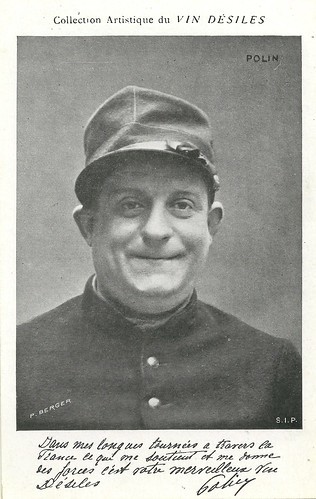
French postcard in the 'Collection Artistique du Vin Désiles' series by S.I.P. Photo: P. Berger. Caption: Dans mes longues tournées à travers la France ce qui me soutient et me donne des forces c'est votre merveilleux vin Désiles. (During my long tours across France, it is your wonderful Vin Désiles that supports me and gives me strength.)
French comedian Polin (1863-1927) was one of the greatest stars of the café-concerts of Paris. His interpretations were sober and had nuance and finesse, which were rare in the café-concerts. From 1910 on, he also appeared in film and theatre, including Sacha Guitry's play 'Le Grand Duc/The Grand Duke' (1921) with Lucien and Sacha Guitry and Yvonne Printemps.
Warming and tonic effects on the muscular fibres
Alexandre Choffé was born on 12 January 1845 in Chaumont (Haute Marne). He was the son of Nicolas Choffé, a baker, and Françoise Badet. Alexandre succeeded in completing his secondary education, obtaining a bachelor's degree in literature in 1862 and a bachelor's degree in science in 1863.
After being dismissed for indiscipline from the military school of Strasbourg, he was nevertheless accepted to the examination of auxiliary doctor of the navy and entered in function in Brest in 1868. After many trips around the world, he decided to study medicine at the Faculty of Montpellier and officially became a doctor in 1873.
He invented many medicinal recipes, but the most famous were Désiline and Vin Désiles. His naval anchor framed by his two initials (A.C) will be his trademark and will be affixed to the packaging of the "medicines". Vin Désiles will however be sold in pharmacies.
Vin Désiles is recommended to be taken before each of the two meals, in order to feel at the maximum these warming and tonic effects on the muscular fibres! Here is the composition:
Special liqueur wine at 15° - 1 litre Kola nut - 11 gr Coca leaves - 14 gr Quiquina succirubra - 13 gr Theobrama - cocoa - 3 gr Iodine (tincture Codex) - 0.40 gr Lme phosphate - 1 gr Glycerine chemically pure 30° - 2 gr Orange Alcohol - 18 gr Lithium carbonate - 0.050gr.
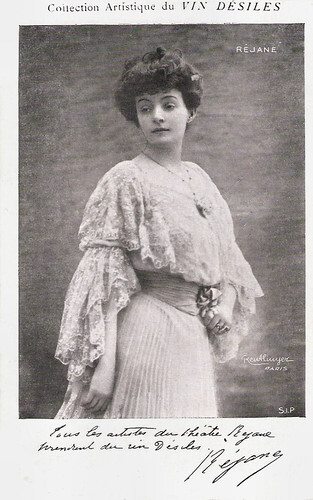
French postcard in the 'Collection Artistique du Vin Désiles' series by S.I.P. Photo: Reutlinger, Paris. Caption: Tous les artistes du théàtre Réjane prendront du vin Désiles. (All the artists of the Rejane theater will take the Désiles wine.)
Gabrielle Réjane (1856-1920) was a successful French stage actress and early silent film actress. She is most famous for her role as Catherine, in Sardou's play 'Madame Sans-Gene' (1893), which she filmed twice.
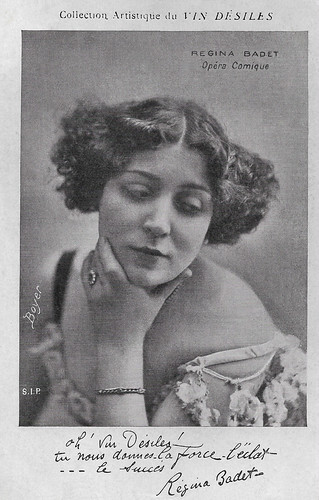
French postcard in the 'Collection Artistique du Vin Désiles' series by S.I.P. Photo: Boyer. Caption: Oh! Vin Désiles! You give us the force, the sparkle ... the success.
French actress and dancer Régina Badet (1876-1949) was a star of the Opéra-Comique in Paris. She also had a short career in the French silent cinema.
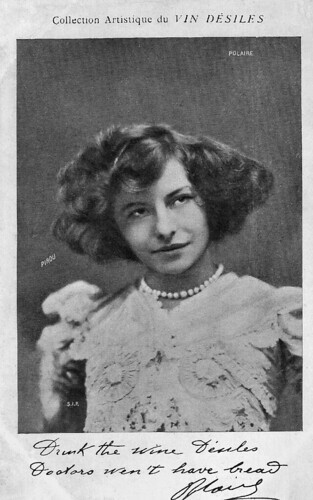
French postcard in the 'Collection Artistique du Vin Désiles' series by S.I.P. Photo: Pirou. Caption: Drink the wine Désiles. Doctors won't have bread. Polaire.
French singer and actress Polaire (1874-1939) had a career in the entertainment industry that stretched from the early 1890s to the mid-1930s and encompassed the range from music-hall singer to stage and film actress. Her most successful period professionally was from the mid-1890s to the beginning of the First World War. From 1909, Polaire appeared in several film roles. After two films at Pathé frères, she went to Germany to play a Cuban lady in Zouza (Reinhard Bruck, 1911). Back in France she acted again at Pathé in Le visiteur/The Visitor (Albert Capellani, René Leprince, 1911), but she mostly was active at the Éclair film company between 1911 and 1914, starting with Le poison de l’humanité/The Poison of Humanity (Émile Chautard, Victorin Jasset, 1911). From 1912 to 1914 she did a series of six films with then young and upcoming film director Maurice Tourneur, including Les gaîtés de l'escadron/The Funny Regiment (1913).
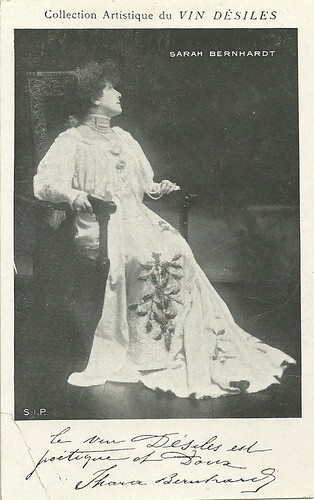
French postcard in the 'Collection Artistique du Vin Désiles' series by S.I.P. Caption: The Désiles wine is poetic and sweet, Sarah Bernhardt.
French vedette Sarah Bernhardt (1844-1923) has been referred to as 'the most famous actress in the history of the world'. She developed a reputation as a serious dramatic actress, earning her the nickname 'The Divine Sarah'. Bernhardt made her fame on the stages of Europe in the 1870s and was soon high in demand in both Americas too. And she was one of the first film stars. What a woman!
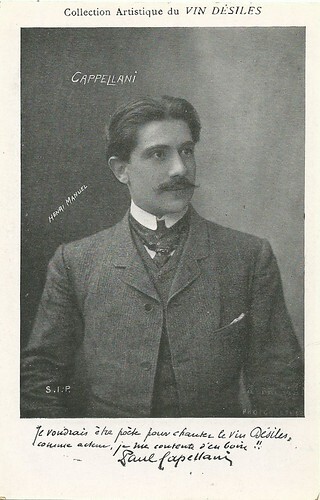
French postcard in the 'Collection Artistique du Vin Désiles' series by S.I.P. Photo: Manuel. Capellani's name is mispelled on the card. Caption: 'Je voudrais être poète pour chanter le vin Désiles, comme acteur, je me contente d'en boire.' (I wish I was a poet so I could hymn Désiles wine, as actor I am content to just drink it.)
Paul Capellani (1877-1960) was a stage and film actor who was active in French and American silent films. He was the younger brother of the film director of the silent era Albert Capellani.
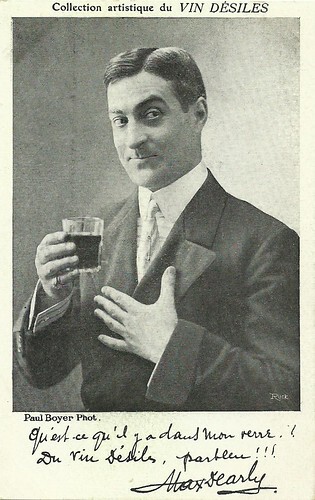
French postcard in the 'Collection Artistique du Vin Désiles' series by Ruck. Photo: Paul Boyer. Caption: Qu'est-ce qu'il y a dans mon verre? Du Vin Désiles, parbleu!!! (What's that in my glass? Its is Désiles wine, parbleu!!!).
Max Dearly (1874-1943) was a French actor, famous for his parts in the 1930s in French sound films but also for his previous career in Parisian vaudeville.
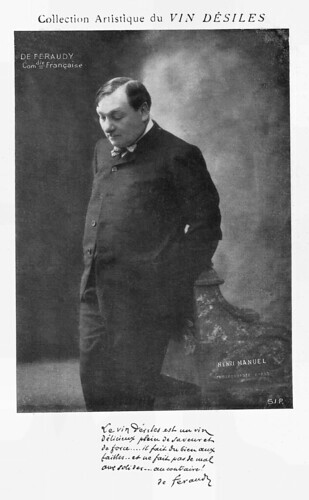
French postcard in the 'Collection Artistique du Vin Désiles' series by S.I.P. Photo: Henri Manuel. Caption: 'Le Vin Désiles est un vin délicieux, plein de saveur et de force... il fait du bien aux faibles... et ne fait pas du mal aux solides... au contraire!' (Vin Désiles is a delicious wine, full of taste and vigor. While it does well to the weak, and means no harm to the solid ones, on the contrary!)
Maurice de Féraudy (1859-1932) was an actor of the Comédie-Française and a French director. He was also a notable actor and director in French silent cinema.
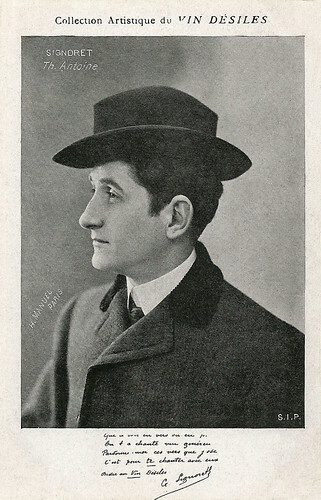
French postcard in the 'Collection Artistique du Vin Désiles' series by S.I.P. Photo: Henri Manuel. Caption: 'Que ce soit en vers ou en prose, On t'a chanté vers genereux, Pardonnez-moi ces vers que j'ose, C'est pour te chanter avec eux, Dédié au Vin Désiles.' (Whether in verse or prose, generous verses have been dedicated to you. Permit me to dedicate these verses to you, It's to praise you together with the others. Dedicated to V.D.)
Gabriel Signoret aka Signoret (1878-1937) was a French actor and director who played in some 85 films, mostly silent ones.
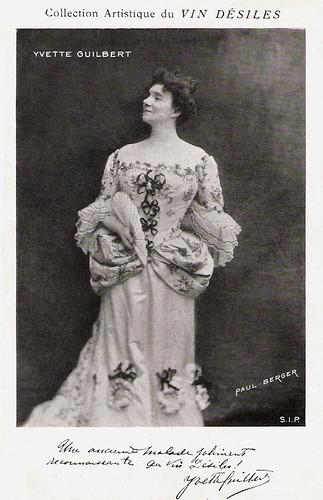
French postcard in the 'Collection Artistique du Vin Désiles' series by S.I.P. Photo: Paul Berger. Caption: Une ancienne malade joliment reconnaissante au Vin Désiles! (A former patient who is now cheerfully grateful to V.D.)
Yvette Guilbert (1865-1944) was a French cabaret singer and actress of the Belle Époque. Her ingenious delivery of songs charged with risqué meaning made her famous. She also appeared in some classic silent films.
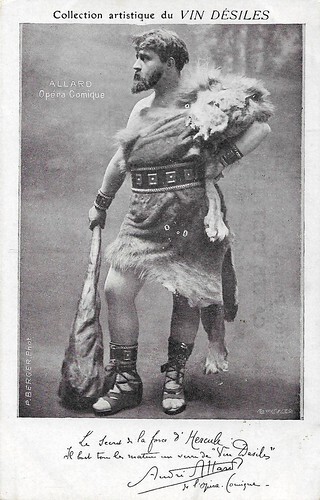
French postcard in the 'Collection Artistique du Vin Désiles' series by S.I.P. Photo: Paul Berger. Caption: Le secret de la force d'Hercule, il boit tous les matins un ver de Vin Desiles. (The secret of Hercules' strength, he drinks a glass of Desiles Wine every morning.)
André Allard (1874-1938) was a famous French baritone. He studied singing at the Conservatoire de Paris and made his debut in 1897 at the Opéra National de Bordeaux. While in 1900 he sang at Covent Garden, in the early 1900s he was highly active at the Paris Opéra Comique, and in the early 1910s at the Opéra de Monte-Carlo.
Source: Cartes Postales Anciennes (French).

French postcard in the Collection artistique du Vin Désiles by S.I.P. Photo: Reutlinger. Caption: Au délicieux Vin Désiles qui donne la santé et la gaité (To the delicious Vin Désiles that gives health and cheerfulness).
Cleo de Mérode (1875-1966) was a French dancer of the Belle Époque. She has been referred to as the "first real celebrity icon" and the "first modern celebrity". She was also the first woman whose photographic image, due in particular to photographers Nadar and Léopold-Émile Reutlinger , was distributed worldwide.

French postcard in the Collection artistique du Vin Désiles by S.I.P. Photo: Reutlinger. Caption: Vive le vin Désiles, je lui dois ma force et ma gaité. (Long live the Désiles wine, I owe my strength and cheerfulness to it).
Gabrielle Robinne (1886-1980) was a French stage and film actress, who had the peak of her film career in the 1910s.

French postcard in the Collection artistique du Vin Désiles by S.I.P. Photo: Berger, Paris. Caption: Au généreux et réconfortant Vin Desiles (To the generous and comforting Vin Desiles.)
Agnès Borgo (1879-1958) was a Corsican soprano. This card depicts her in her attire for Ernest Reyer's opera 'Salammbo'.

French postcard in the Collection artistique du Vin Désiles by S.I.P. Photo: Reutlinger. Caption: Le vin Desiles? C'est la vie en bouteille et quand vous le buvez, ... vous plein de vers vous réssusciterez! Theophile Gautier. (The Désiles wine? It is life in a bottle and when you drink it, ... with a full glass you will resurrect! Theophile Gautier.)
French actress and stage beauty Andrée Mégard (1869–1952) was on the Paris stage from 1896 to 1925, appearing in shows including Shakespearean tragedies, comedies, and plays directed by her husband, Firmin Gémier. She played the love interest, Roxane, in a 1913 revival of Edmond Rostand's 'Cyrano de Bergerac', while she was having an affair with Rostand himself. She appeared in one silent film, La tour de Nesle (1909). Mégard was considered "tall, graceful, and distinguished-looking." Her hairstyles and the designs of her costumes, hats, and gowns were reported in detail, internationally, often with photographs or drawings showing their features.

French postcard in the Collection artistique du Vin Désiles by S.I.P. Photo: Berger. Caption: Je dis avec tous et toutes: vive le vin Desiles! (I say with all: long live Desiles wine!).
Marguerite 'Zina' de Nuovina, originally Marguerite Lamandi nee Moldave (1865-1936) was a Romanian mezzosoprano, who debuted in 1889. Around 1900, she became a highly acclaimed singer in such operas as 'Carmen', 'Cavalleria rusticana' and 'Lohengrin'.

French postcard in the Collection artistique du Vin Désiles by S.I.P. Photo: Berger. Caption: Le Vin Desiles est un beuvage délicieux et réconfortant que je recommande à mes contemporains. (The Desiles wine is a delicious and comforting beverage that I recommend to my contemporaries).
Félix Huguenet (1858-1926) only stayed two years with the Comédie Française but he had a rich stage career between the 1880s and the 1920s. He played in four films, including Mademoiselle de La Seiglière (André Antoine, 1921).

French postcard in the Collection Artistique du Vin Désiles by S.I.P. Photo: Bonfort. Caption: Whenever I drink Vin Désiles, my voice is flexible and easy.
Félix Mayol (1872-1941) was a popular French singer of the Belle Epoque. French Wikipedia lists some 120 songs. After a 1905 phonoscènes series at Gaumont, Mayol acted in five more films, three silent films, including Le filon du Bouif (Louis Osmont, 1922), and two early sound films, Aux urnes, citoyens!/Tu sera député (Jean Hémard, 1932) and La dame de chez Maxim's (Alexander Korda, 1933) starring Florelle.

French postcard in the Collection Artistique de Vin Désiles by G.P., Paris, no. 8. Caption: Dans les temps d'autrefois, les bons ameublements on se construisaient en bois des îles, On construit aujourd’hui les bons tempéraments en absorbant du vin Désiles. (Once, they constructed good furniture from wood of the islands. Nowadays they construct good temper with Désiles wine).
Yvonne de Bray (1887-1954) was a French stage and screen actress, famous for her role as Sophie in Jean Cocteau's film Les parents terribles (1948).

French postcard in the 'Collection Artistique du Vin Désiles' series by S.I.P. Photo: Boyer. Caption: I've the pleasure to recommend the excellent Désiles Wine, Geraldine Farrar, Imperial Opera of Berlin.
American soprano opera singer and film actress Geraldine Farrar (1882-1967) was noted for her glamorous beauty, acting ability, and the timbre of her voice. Barely 20, she was already the toast of Berlin. Later at the Met in New York, she had a large following among young women, who were nicknamed ‘Gerry-flappers’. Farrar also starred in more than a dozen silent films from 1915 to 1920. She was married to and co-starred with Dutch matinee idol Lou Tellegen.

French postcard in the 'Collection Artistique du Vin Désiles' series by S.I.P. Photo: P. Berger. Caption: Dans mes longues tournées à travers la France ce qui me soutient et me donne des forces c'est votre merveilleux vin Désiles. (During my long tours across France, it is your wonderful Vin Désiles that supports me and gives me strength.)
French comedian Polin (1863-1927) was one of the greatest stars of the café-concerts of Paris. His interpretations were sober and had nuance and finesse, which were rare in the café-concerts. From 1910 on, he also appeared in film and theatre, including Sacha Guitry's play 'Le Grand Duc/The Grand Duke' (1921) with Lucien and Sacha Guitry and Yvonne Printemps.
Warming and tonic effects on the muscular fibres
Alexandre Choffé was born on 12 January 1845 in Chaumont (Haute Marne). He was the son of Nicolas Choffé, a baker, and Françoise Badet. Alexandre succeeded in completing his secondary education, obtaining a bachelor's degree in literature in 1862 and a bachelor's degree in science in 1863.
After being dismissed for indiscipline from the military school of Strasbourg, he was nevertheless accepted to the examination of auxiliary doctor of the navy and entered in function in Brest in 1868. After many trips around the world, he decided to study medicine at the Faculty of Montpellier and officially became a doctor in 1873.
He invented many medicinal recipes, but the most famous were Désiline and Vin Désiles. His naval anchor framed by his two initials (A.C) will be his trademark and will be affixed to the packaging of the "medicines". Vin Désiles will however be sold in pharmacies.
Vin Désiles is recommended to be taken before each of the two meals, in order to feel at the maximum these warming and tonic effects on the muscular fibres! Here is the composition:
Special liqueur wine at 15° - 1 litre Kola nut - 11 gr Coca leaves - 14 gr Quiquina succirubra - 13 gr Theobrama - cocoa - 3 gr Iodine (tincture Codex) - 0.40 gr Lme phosphate - 1 gr Glycerine chemically pure 30° - 2 gr Orange Alcohol - 18 gr Lithium carbonate - 0.050gr.

French postcard in the 'Collection Artistique du Vin Désiles' series by S.I.P. Photo: Reutlinger, Paris. Caption: Tous les artistes du théàtre Réjane prendront du vin Désiles. (All the artists of the Rejane theater will take the Désiles wine.)
Gabrielle Réjane (1856-1920) was a successful French stage actress and early silent film actress. She is most famous for her role as Catherine, in Sardou's play 'Madame Sans-Gene' (1893), which she filmed twice.

French postcard in the 'Collection Artistique du Vin Désiles' series by S.I.P. Photo: Boyer. Caption: Oh! Vin Désiles! You give us the force, the sparkle ... the success.
French actress and dancer Régina Badet (1876-1949) was a star of the Opéra-Comique in Paris. She also had a short career in the French silent cinema.

French postcard in the 'Collection Artistique du Vin Désiles' series by S.I.P. Photo: Pirou. Caption: Drink the wine Désiles. Doctors won't have bread. Polaire.
French singer and actress Polaire (1874-1939) had a career in the entertainment industry that stretched from the early 1890s to the mid-1930s and encompassed the range from music-hall singer to stage and film actress. Her most successful period professionally was from the mid-1890s to the beginning of the First World War. From 1909, Polaire appeared in several film roles. After two films at Pathé frères, she went to Germany to play a Cuban lady in Zouza (Reinhard Bruck, 1911). Back in France she acted again at Pathé in Le visiteur/The Visitor (Albert Capellani, René Leprince, 1911), but she mostly was active at the Éclair film company between 1911 and 1914, starting with Le poison de l’humanité/The Poison of Humanity (Émile Chautard, Victorin Jasset, 1911). From 1912 to 1914 she did a series of six films with then young and upcoming film director Maurice Tourneur, including Les gaîtés de l'escadron/The Funny Regiment (1913).

French postcard in the 'Collection Artistique du Vin Désiles' series by S.I.P. Caption: The Désiles wine is poetic and sweet, Sarah Bernhardt.
French vedette Sarah Bernhardt (1844-1923) has been referred to as 'the most famous actress in the history of the world'. She developed a reputation as a serious dramatic actress, earning her the nickname 'The Divine Sarah'. Bernhardt made her fame on the stages of Europe in the 1870s and was soon high in demand in both Americas too. And she was one of the first film stars. What a woman!

French postcard in the 'Collection Artistique du Vin Désiles' series by S.I.P. Photo: Manuel. Capellani's name is mispelled on the card. Caption: 'Je voudrais être poète pour chanter le vin Désiles, comme acteur, je me contente d'en boire.' (I wish I was a poet so I could hymn Désiles wine, as actor I am content to just drink it.)
Paul Capellani (1877-1960) was a stage and film actor who was active in French and American silent films. He was the younger brother of the film director of the silent era Albert Capellani.

French postcard in the 'Collection Artistique du Vin Désiles' series by Ruck. Photo: Paul Boyer. Caption: Qu'est-ce qu'il y a dans mon verre? Du Vin Désiles, parbleu!!! (What's that in my glass? Its is Désiles wine, parbleu!!!).
Max Dearly (1874-1943) was a French actor, famous for his parts in the 1930s in French sound films but also for his previous career in Parisian vaudeville.

French postcard in the 'Collection Artistique du Vin Désiles' series by S.I.P. Photo: Henri Manuel. Caption: 'Le Vin Désiles est un vin délicieux, plein de saveur et de force... il fait du bien aux faibles... et ne fait pas du mal aux solides... au contraire!' (Vin Désiles is a delicious wine, full of taste and vigor. While it does well to the weak, and means no harm to the solid ones, on the contrary!)
Maurice de Féraudy (1859-1932) was an actor of the Comédie-Française and a French director. He was also a notable actor and director in French silent cinema.

French postcard in the 'Collection Artistique du Vin Désiles' series by S.I.P. Photo: Henri Manuel. Caption: 'Que ce soit en vers ou en prose, On t'a chanté vers genereux, Pardonnez-moi ces vers que j'ose, C'est pour te chanter avec eux, Dédié au Vin Désiles.' (Whether in verse or prose, generous verses have been dedicated to you. Permit me to dedicate these verses to you, It's to praise you together with the others. Dedicated to V.D.)
Gabriel Signoret aka Signoret (1878-1937) was a French actor and director who played in some 85 films, mostly silent ones.

French postcard in the 'Collection Artistique du Vin Désiles' series by S.I.P. Photo: Paul Berger. Caption: Une ancienne malade joliment reconnaissante au Vin Désiles! (A former patient who is now cheerfully grateful to V.D.)
Yvette Guilbert (1865-1944) was a French cabaret singer and actress of the Belle Époque. Her ingenious delivery of songs charged with risqué meaning made her famous. She also appeared in some classic silent films.

French postcard in the 'Collection Artistique du Vin Désiles' series by S.I.P. Photo: Paul Berger. Caption: Le secret de la force d'Hercule, il boit tous les matins un ver de Vin Desiles. (The secret of Hercules' strength, he drinks a glass of Desiles Wine every morning.)
André Allard (1874-1938) was a famous French baritone. He studied singing at the Conservatoire de Paris and made his debut in 1897 at the Opéra National de Bordeaux. While in 1900 he sang at Covent Garden, in the early 1900s he was highly active at the Paris Opéra Comique, and in the early 1910s at the Opéra de Monte-Carlo.
Source: Cartes Postales Anciennes (French).
Published on June 03, 2022 22:00
June 2, 2022
Sigourney Weaver
American actress Sigourney Weaver (1949) rose to international fame with her role as Ellen Ripley in the Alien saga. After her breakthrough in the Science Fiction blockbuster Alien (1979), she became one of Hollywood's major female stars during the 1980s and 1990s. Weaver often plays strong, independent, and driven women. She was nominated for an Oscar for Aliens (1987), Gorillas in the Mist: The Story of Dian Fossey (1988) and Working Girl (1988), and her tour-de-force performance in the Broadway play 'Hurlyburly' (1984) earned her a Tony Award nomination. Weaver has actually won more than ten film awards, including two Golden Globes and a BAFTA Award.

Spanish postcard by Coleccion Estrellas Cinematograficas Cacitel, S.L., no. 34.

Vintage postcard in the Movie's Images series, no. 54. Sigourney Weaver in Alien - Resurrection (Jean-Pierre Jeunet, 1997).
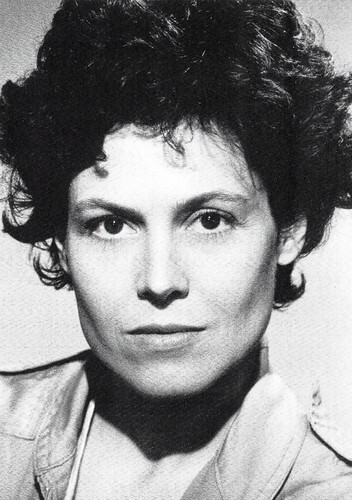
British postcard in the Mini Series by Lilliput Production, London, no. 502.
Alien
Susan Alexandra 'Sigourney' Weaver was born in New York, in 1949. Weaver is the daughter of television producer and president of NBC Pat Weaver and British actress Elizabeth Inglis. She changed her name to 'Sigourney' at the age of 14, after a character in F. Scott Fitzgerald's book 'The Great Gatsby'.
She graduated from Stanford and Yale, in the same class as Meryl Streep . In the 1970s, she acted in experimental and classical plays, including those by her former classmate Christopher Durang. Because of her height (she is 1.82 metres), she was often ignored by most producers and directors. In 1976, Weaver got a role in the soap opera Somerset.
The following year, she made her film debut: she appeared for six seconds in Annie Hall (Woody Allen, 1977). However, it made many people sit up and take notice. She had her first starring role in Madman (Dan Cohen, 1978) starring Michael Beck. Her breakthrough followed in Ridley Scott's Alien (1979). The part of Ellen Ripley became her most famous role and made Weaver one of the greatest actresses of the moment.
She continued her career with drama films such as Eyewitness (Peter Yates, 1981) and The Year of Living Dangerously (Peter Weir, 1982), with Mel Gibson. In 1984, she played her first comic role as Dana Barrett in Ghostbusters (Ivan Reitman, 1984). In 1986, the first sequel to Alien was released. In Aliens (James Cameron, 1986), Weaver portrayed Ripley as an intelligent, powerful woman. The film was an even greater commercial success than the original and she was rewarded for her role with her first Oscar nomination.
She was also nominated for an Oscar for her roles as the animal rights activist and zoologist Dian Fossey in Gorillas in the Mist (Michael Apted, 1988) and her delicious performance as a double-crossing, power-hungry corporate executive in the comedy Working Girl (Mike Nichols, 1988). She missed out on the award all three times but did receive Golden Globes for the latter two films.
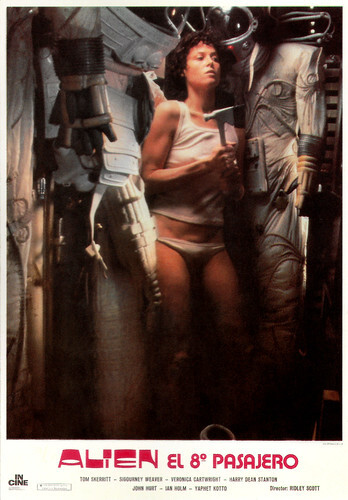
Spanish postcard by Editions Mercuri, no. 465. Photo: Sigourney Weaver in Alien (Ridley Scott, 1979). Caption: Alien el 8 pasajero.
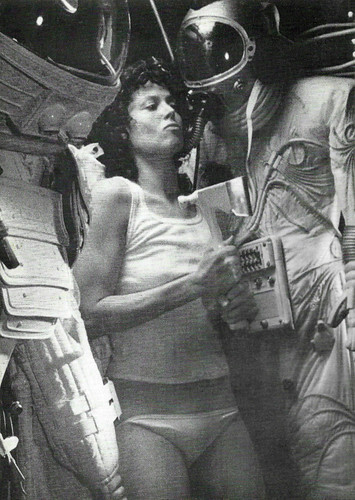
British postcard in the Mini Series by Lilliput Production, London, no. 505. Photo: Sigourney Weaver in Alien (Ridley Scott, 1979).
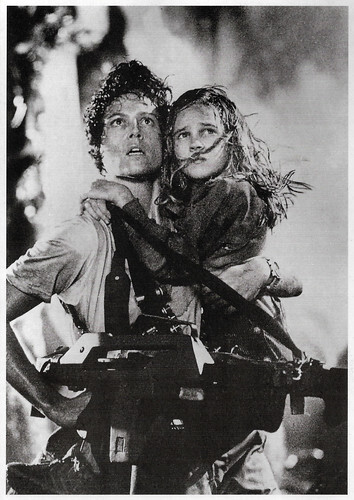
Canadian postcard by Canadian Postcard, no. A-433. Sigourney Weaver and Carrie Henn in Aliens (James Cameron, 1996).
Resurrection
Sigourney Weaver reprised the role of Dana Barrett in the sequel Ghostbusters II (Ivan Reitman, 1989) and played Rebecca Gorin in the reboot Ghostbusters (Paul Feig, 2016). Weaver also reprised the role of Ellen Ripley in the films Alien³ (David Fincher, 1992) and Alien: Resurrection (Jean-Pierre Jeunet, 1997) with Winona Ryder, as well as in the game Alien: Isolation (2014), the latter of which marks the actress' return 17 years after her last appearance in the franchise.
Weaver collaborated with Ridley Scott again, appearing as Queen Isabella in 1492: Conquest of Paradise (1992) and appeared in the Roman Polanski–directed Death and the Maiden (1994), in a major role opposite Ben Kingsley. For her role in The Ice Storm (Ang Lee, 1997), she received her fourth Golden Globe nomination and won a BAFTA for Best Supporting Actress. In 1999, she co-starred in the hilarious Science Fiction comedy Galaxy Quest (Dean Parisot, 1999) with Tim Allen and Alan Rickman.
Then followed a decade in which she continued to appear in films but also had multiple voice roles in animated films, including The Tale of Despereaux (Sam Fell, Rob Stevenhagen, 2008) and the Pixar films WALL-E (Andrew Stanton, 2008) and Finding Dory (Andrew Stanton, 2016). She also worked in several documentaries, such as the BBC series Planet Earth (2006) and The Beatles: Eight Days a Week (2016).
During the 2010s, she made a major comeback in the cinema with supporting roles in the blockbuster Avatar (2009), which marked her reunion with James Cameron, and in the historical blockbuster Exodus: Gods and Kings (Ridley Scott, 2014), starring Christian Bale, for which she reunited with Ridley Scott.
She made a lasting return with the Sci-Fi thriller Chappie (Neill Blomkamp, 2015), the fantasy film A Monster Calls (Juan Antonio Bayona, 2016), and the TV mini-series The Defenders (2017). Last year, she returned as Dana Barrett in Ghostbusters: Afterlife (Jason Reitman, 2021). Sigourney Weaver married director Jim Simpson in 1984, with whom she had a daughter in 1990.

Dutch postcard by Film Freak Productions, Zoetermeer, no. FA 461, 1997. Photo: Twentieth Century Fox Film Corporation. Poster image of Alien - Resurrection (Jean-Pierre Jeunet, 1997) with Sigourney Weaver and Winona Ryder .
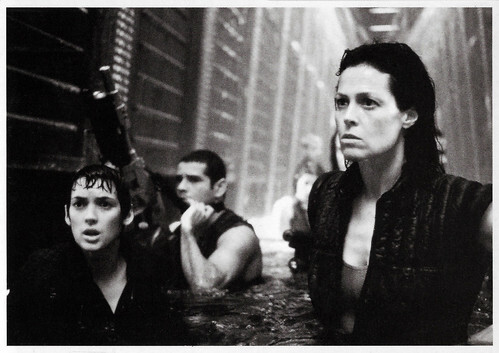
Vintage postcard in the Movie's Images series, no. 59. Winona Ryder and Sigourney Weaver in Alien - Resurrection (Jean-Pierre Jeunet, 1997).

Vintage postcard in the Movie's Images series, no. 52. Ron Perlman, Dominique Pinon, Sigourney Weaver, and Winona Ryder in Alien - Resurrection (Jean-Pierre Jeunet, 1997).
Sources: Wikipedia (English, Dutch and French), and .

Spanish postcard by Coleccion Estrellas Cinematograficas Cacitel, S.L., no. 34.

Vintage postcard in the Movie's Images series, no. 54. Sigourney Weaver in Alien - Resurrection (Jean-Pierre Jeunet, 1997).

British postcard in the Mini Series by Lilliput Production, London, no. 502.
Alien
Susan Alexandra 'Sigourney' Weaver was born in New York, in 1949. Weaver is the daughter of television producer and president of NBC Pat Weaver and British actress Elizabeth Inglis. She changed her name to 'Sigourney' at the age of 14, after a character in F. Scott Fitzgerald's book 'The Great Gatsby'.
She graduated from Stanford and Yale, in the same class as Meryl Streep . In the 1970s, she acted in experimental and classical plays, including those by her former classmate Christopher Durang. Because of her height (she is 1.82 metres), she was often ignored by most producers and directors. In 1976, Weaver got a role in the soap opera Somerset.
The following year, she made her film debut: she appeared for six seconds in Annie Hall (Woody Allen, 1977). However, it made many people sit up and take notice. She had her first starring role in Madman (Dan Cohen, 1978) starring Michael Beck. Her breakthrough followed in Ridley Scott's Alien (1979). The part of Ellen Ripley became her most famous role and made Weaver one of the greatest actresses of the moment.
She continued her career with drama films such as Eyewitness (Peter Yates, 1981) and The Year of Living Dangerously (Peter Weir, 1982), with Mel Gibson. In 1984, she played her first comic role as Dana Barrett in Ghostbusters (Ivan Reitman, 1984). In 1986, the first sequel to Alien was released. In Aliens (James Cameron, 1986), Weaver portrayed Ripley as an intelligent, powerful woman. The film was an even greater commercial success than the original and she was rewarded for her role with her first Oscar nomination.
She was also nominated for an Oscar for her roles as the animal rights activist and zoologist Dian Fossey in Gorillas in the Mist (Michael Apted, 1988) and her delicious performance as a double-crossing, power-hungry corporate executive in the comedy Working Girl (Mike Nichols, 1988). She missed out on the award all three times but did receive Golden Globes for the latter two films.

Spanish postcard by Editions Mercuri, no. 465. Photo: Sigourney Weaver in Alien (Ridley Scott, 1979). Caption: Alien el 8 pasajero.

British postcard in the Mini Series by Lilliput Production, London, no. 505. Photo: Sigourney Weaver in Alien (Ridley Scott, 1979).

Canadian postcard by Canadian Postcard, no. A-433. Sigourney Weaver and Carrie Henn in Aliens (James Cameron, 1996).
Resurrection
Sigourney Weaver reprised the role of Dana Barrett in the sequel Ghostbusters II (Ivan Reitman, 1989) and played Rebecca Gorin in the reboot Ghostbusters (Paul Feig, 2016). Weaver also reprised the role of Ellen Ripley in the films Alien³ (David Fincher, 1992) and Alien: Resurrection (Jean-Pierre Jeunet, 1997) with Winona Ryder, as well as in the game Alien: Isolation (2014), the latter of which marks the actress' return 17 years after her last appearance in the franchise.
Weaver collaborated with Ridley Scott again, appearing as Queen Isabella in 1492: Conquest of Paradise (1992) and appeared in the Roman Polanski–directed Death and the Maiden (1994), in a major role opposite Ben Kingsley. For her role in The Ice Storm (Ang Lee, 1997), she received her fourth Golden Globe nomination and won a BAFTA for Best Supporting Actress. In 1999, she co-starred in the hilarious Science Fiction comedy Galaxy Quest (Dean Parisot, 1999) with Tim Allen and Alan Rickman.
Then followed a decade in which she continued to appear in films but also had multiple voice roles in animated films, including The Tale of Despereaux (Sam Fell, Rob Stevenhagen, 2008) and the Pixar films WALL-E (Andrew Stanton, 2008) and Finding Dory (Andrew Stanton, 2016). She also worked in several documentaries, such as the BBC series Planet Earth (2006) and The Beatles: Eight Days a Week (2016).
During the 2010s, she made a major comeback in the cinema with supporting roles in the blockbuster Avatar (2009), which marked her reunion with James Cameron, and in the historical blockbuster Exodus: Gods and Kings (Ridley Scott, 2014), starring Christian Bale, for which she reunited with Ridley Scott.
She made a lasting return with the Sci-Fi thriller Chappie (Neill Blomkamp, 2015), the fantasy film A Monster Calls (Juan Antonio Bayona, 2016), and the TV mini-series The Defenders (2017). Last year, she returned as Dana Barrett in Ghostbusters: Afterlife (Jason Reitman, 2021). Sigourney Weaver married director Jim Simpson in 1984, with whom she had a daughter in 1990.

Dutch postcard by Film Freak Productions, Zoetermeer, no. FA 461, 1997. Photo: Twentieth Century Fox Film Corporation. Poster image of Alien - Resurrection (Jean-Pierre Jeunet, 1997) with Sigourney Weaver and Winona Ryder .

Vintage postcard in the Movie's Images series, no. 59. Winona Ryder and Sigourney Weaver in Alien - Resurrection (Jean-Pierre Jeunet, 1997).

Vintage postcard in the Movie's Images series, no. 52. Ron Perlman, Dominique Pinon, Sigourney Weaver, and Winona Ryder in Alien - Resurrection (Jean-Pierre Jeunet, 1997).
Sources: Wikipedia (English, Dutch and French), and .
Published on June 02, 2022 22:00
June 1, 2022
Sevilla de mis amores (1931)
Mexican-American actor Ramon Novarro (1899-1968) was a popular Latin Lover of the 1920s and early 1930s. Sevilla de mis amores/La Sevillana (1930) was Novarro's first film direction and fully spoken and sung in Spanish. It was the alternate-language version of the musical Call of the Flesh (1930), directed by Charles Brabin. Novarro also co-directed with Yvan Noé a French version, Le chanteur de Séville (1931). The process of filming alternate-language versions was common in the American film industry in the early 1930s and continued until improved dubbing technology became available. Novarro appears in both alternate versions, reprising his role as Juan de Dios Carbajal. Ivo Blom collected a series of eight Spanish collectors cards of the Spanish version.
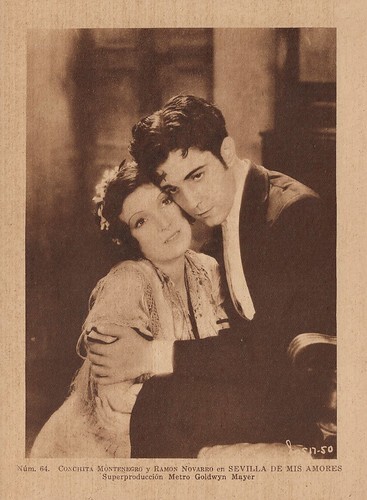
Spanish collectors card by Editorial Grafica Barcelona in the Estampas del cinema series, no. 57, series 8, 1931, no. 1 of 8. Photo: Metro-Goldwyn-Mayer. Conchita Montenegro and Ramon Novarro in Sevilla de mis amores (Ramon Novarro, 1931).
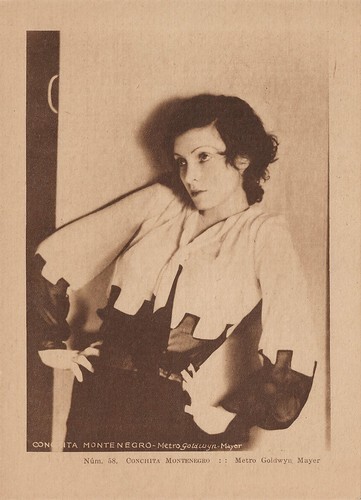
Spanish collectors card by Editorial Grafica Barcelona in the Estampas del cinema series, no. 58, series 8, 1931, no. 2 of 8. Photo: Metro-Goldwyn-Mayer. Conchita Montenegro in Sevilla de mis amores (Ramon Novarro, 1931).
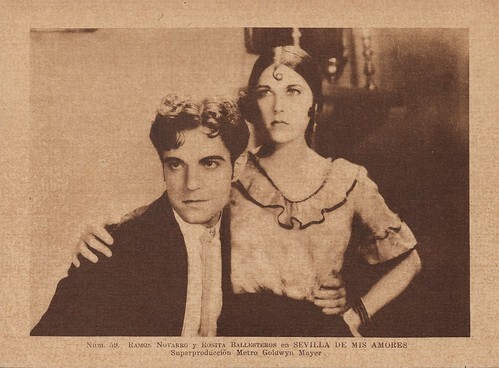
Spanish collectors card by Editorial Grafica Barcelona in the Estampas del cinema series, no. 59, series 8, 1931, no. 3 of 8. Photo: Metro-Goldwyn-Mayer. Ramon Novarro and Rosita Ballesteros in Sevilla de mis amores (Ramon Novarro, 1931).
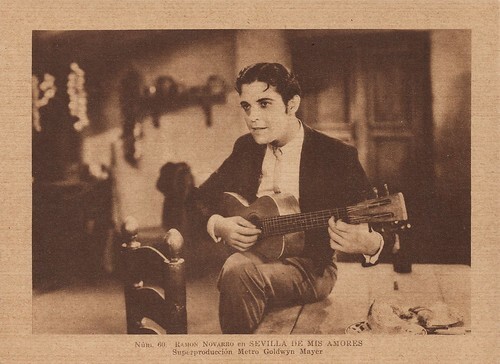
Spanish collectors card by Editorial Grafica Barcelona in the Estampas del cinema series, no. 60, series 8, 1931, no. 4 of 8. Photo: Metro-Goldwyn-Mayer. Ramon Novarro in Sevilla de mis amores (Ramon Novarro, 1931).
Peering over the convent wall to the cantina
Sevilla de mis amores/La Sevillana (1930) marked Novarro's first performance in Spanish, his first language. Ramon Novarro plays Juan de Dios, a young Spaniard from a poor working-class background. Juan is a cantina performer in Seville, singing and dancing with his partner Lola (Rosita Ballesteros). They have a contentious professional and personal relationship. She is jealous and cannot tolerate his constant flirting.
Juan aspires to become a serious opera singer, under the tutelage of Estaban (José Soriano Viosca). Once the greatest impresario in Spain himself, Estaban lost everything because of the same reckless behaviour that Juan now exhibits. Estaban is trying to quell that behaviour in Juan.
Estaban's plan is to get one of his old contacts in Madrid, an impresario (Michael Vavitch), to manage Juan's career to get him serious singing gigs, leading to that fame and fortune Esteban once used to have. It's love at first sight when Juan meets Maria Consuelo Vargas ( Conchita Montenegro ).
What he initially doesn't know is that their meeting was by no accident, as she, a postulant at St. Agustín convent who just escaped from that life, had been mesmerised by him and his singing every time she saw him as she peered over the convent wall to the cantina. As she tells him that she has no home, he takes her in.
When Juan learns that Maria Consuela used to be a nun in training, he has to decide whether to marry her as is his wont or try to get her back to the convent. Factored into his decision may be her brother, Army Captain Enrique Vargas (Martin Garralaga), who believes she is destined to be married to God, jealous Lola, and his and Estaban's own aspirations for his singing career.
The plot was based on a story by Dorothy Farnum. The art direction was by Cedric Gibbons, cinematography by Merritt B. Gerstad. The film cost $103,437 and had its American release at the Teatro Califórnia Internacionale in Los Angeles on 5 December 1930, and its Spanish premiere in Barcelona, on 4 April 1931. Sevilla de mis amores (1930) and Le chanteur de Séville (1931) were filmed using a different crew and supporting cast on the same sets at MGM Studios as Call of the Flesh (1930). A German-language version, also to be directed by Novarro, was never filmed for financial reasons.
Sevilla de mis amores (1930) is credited with boosting the career of the then 19-years-old Conchita Montenegro . Novarro's mother, Leonor Pérez Gavilán de Samaniego, makes her only film appearance as Mother Superior of the convent. Ramón Guerrero, who appears in the film, translated the original screenplay, and Novarro translated the song lyrics, assisted by Herbert Stothart.
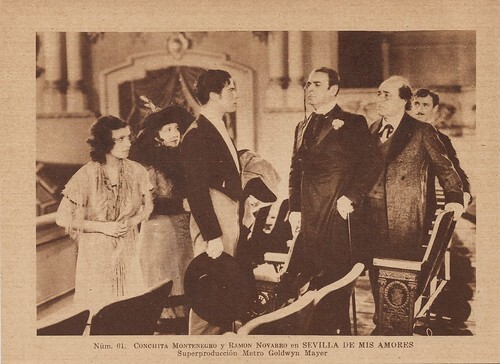
Spanish collectors card by Editorial Grafica Barcelona in the Estampas del cinema series, no. 61, series 8, 1931, no. 5 of 8. Photo: Metro-Goldwyn-Mayer. Ramon Novarro and Conchita Montenegro in Sevilla de mis amores (Ramon Novarro, 1931).
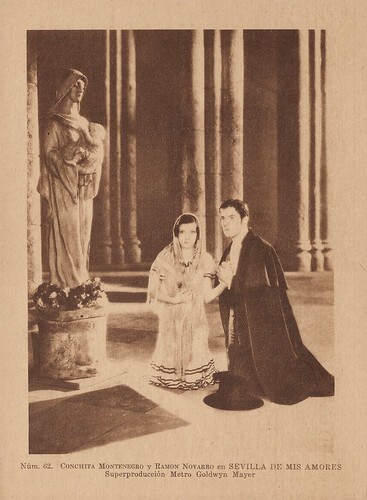
Spanish collectors card by Editorial Grafica Barcelona in the Estampas del cinema series, no. 62, series 8, 1931, no. 6 of 8. Photo: Metro-Goldwyn-Mayer. Ramon Novarro and Conchita Montenegro in Sevilla de mis amores (Ramon Novarro, 1931).
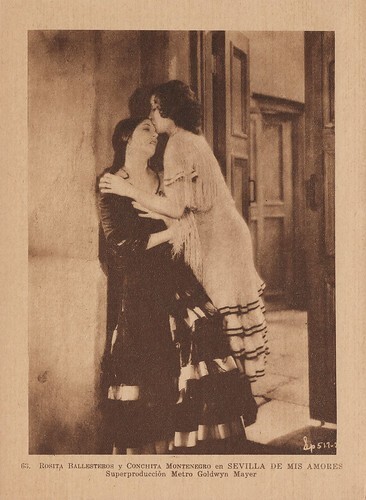
Spanish collectors card by Editorial Grafica Barcelona in the Estampas del cinema series, no. 63, series 8, 1931, no. 7 of 8. Photo: Metro-Goldwyn-Mayer. Rosita Ballesteros and Conchita Montenegro in Sevilla de mis amores (Ramon Novarro, 1931).
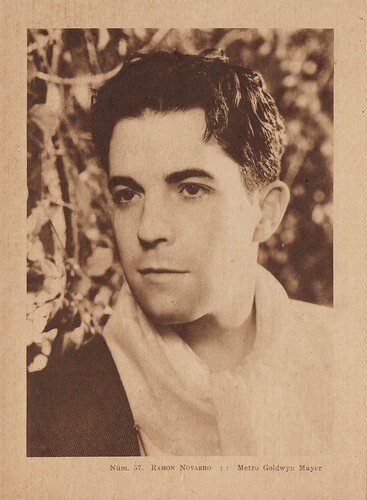
Spanish collectors card by Editorial Grafica Barcelona in the Estampas del cinema series, no. 64, series 8, 1931, no. 8 of 8. Photo: Metro-Goldwyn-Mayer. Ramon Novarro in Sevilla de mis amores (Ramon Novarro, 1931).
Sources: Wikipedia and IMDb.

Spanish collectors card by Editorial Grafica Barcelona in the Estampas del cinema series, no. 57, series 8, 1931, no. 1 of 8. Photo: Metro-Goldwyn-Mayer. Conchita Montenegro and Ramon Novarro in Sevilla de mis amores (Ramon Novarro, 1931).

Spanish collectors card by Editorial Grafica Barcelona in the Estampas del cinema series, no. 58, series 8, 1931, no. 2 of 8. Photo: Metro-Goldwyn-Mayer. Conchita Montenegro in Sevilla de mis amores (Ramon Novarro, 1931).

Spanish collectors card by Editorial Grafica Barcelona in the Estampas del cinema series, no. 59, series 8, 1931, no. 3 of 8. Photo: Metro-Goldwyn-Mayer. Ramon Novarro and Rosita Ballesteros in Sevilla de mis amores (Ramon Novarro, 1931).

Spanish collectors card by Editorial Grafica Barcelona in the Estampas del cinema series, no. 60, series 8, 1931, no. 4 of 8. Photo: Metro-Goldwyn-Mayer. Ramon Novarro in Sevilla de mis amores (Ramon Novarro, 1931).
Peering over the convent wall to the cantina
Sevilla de mis amores/La Sevillana (1930) marked Novarro's first performance in Spanish, his first language. Ramon Novarro plays Juan de Dios, a young Spaniard from a poor working-class background. Juan is a cantina performer in Seville, singing and dancing with his partner Lola (Rosita Ballesteros). They have a contentious professional and personal relationship. She is jealous and cannot tolerate his constant flirting.
Juan aspires to become a serious opera singer, under the tutelage of Estaban (José Soriano Viosca). Once the greatest impresario in Spain himself, Estaban lost everything because of the same reckless behaviour that Juan now exhibits. Estaban is trying to quell that behaviour in Juan.
Estaban's plan is to get one of his old contacts in Madrid, an impresario (Michael Vavitch), to manage Juan's career to get him serious singing gigs, leading to that fame and fortune Esteban once used to have. It's love at first sight when Juan meets Maria Consuelo Vargas ( Conchita Montenegro ).
What he initially doesn't know is that their meeting was by no accident, as she, a postulant at St. Agustín convent who just escaped from that life, had been mesmerised by him and his singing every time she saw him as she peered over the convent wall to the cantina. As she tells him that she has no home, he takes her in.
When Juan learns that Maria Consuela used to be a nun in training, he has to decide whether to marry her as is his wont or try to get her back to the convent. Factored into his decision may be her brother, Army Captain Enrique Vargas (Martin Garralaga), who believes she is destined to be married to God, jealous Lola, and his and Estaban's own aspirations for his singing career.
The plot was based on a story by Dorothy Farnum. The art direction was by Cedric Gibbons, cinematography by Merritt B. Gerstad. The film cost $103,437 and had its American release at the Teatro Califórnia Internacionale in Los Angeles on 5 December 1930, and its Spanish premiere in Barcelona, on 4 April 1931. Sevilla de mis amores (1930) and Le chanteur de Séville (1931) were filmed using a different crew and supporting cast on the same sets at MGM Studios as Call of the Flesh (1930). A German-language version, also to be directed by Novarro, was never filmed for financial reasons.
Sevilla de mis amores (1930) is credited with boosting the career of the then 19-years-old Conchita Montenegro . Novarro's mother, Leonor Pérez Gavilán de Samaniego, makes her only film appearance as Mother Superior of the convent. Ramón Guerrero, who appears in the film, translated the original screenplay, and Novarro translated the song lyrics, assisted by Herbert Stothart.

Spanish collectors card by Editorial Grafica Barcelona in the Estampas del cinema series, no. 61, series 8, 1931, no. 5 of 8. Photo: Metro-Goldwyn-Mayer. Ramon Novarro and Conchita Montenegro in Sevilla de mis amores (Ramon Novarro, 1931).

Spanish collectors card by Editorial Grafica Barcelona in the Estampas del cinema series, no. 62, series 8, 1931, no. 6 of 8. Photo: Metro-Goldwyn-Mayer. Ramon Novarro and Conchita Montenegro in Sevilla de mis amores (Ramon Novarro, 1931).

Spanish collectors card by Editorial Grafica Barcelona in the Estampas del cinema series, no. 63, series 8, 1931, no. 7 of 8. Photo: Metro-Goldwyn-Mayer. Rosita Ballesteros and Conchita Montenegro in Sevilla de mis amores (Ramon Novarro, 1931).

Spanish collectors card by Editorial Grafica Barcelona in the Estampas del cinema series, no. 64, series 8, 1931, no. 8 of 8. Photo: Metro-Goldwyn-Mayer. Ramon Novarro in Sevilla de mis amores (Ramon Novarro, 1931).
Sources: Wikipedia and IMDb.
Published on June 01, 2022 22:00
May 31, 2022
Pearl White
Pearl White (1889-1938) was dubbed 'Queen of the Serials', and noted for doing her own stunts, in silent film serials such as The Perils of Pauline (1914) and The Exploits of Elaine (1914-1915). Often cast as a plucky onscreen heroine, White's roles directly contrasted those of the popularised archetypal ingénue. Until the end of the First World War White remained globally a popular action heroine.
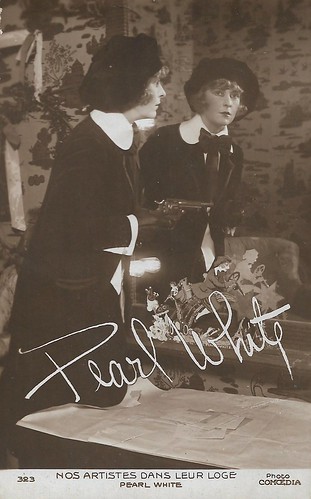
French postcard. Nos artistes dans leur loge, no. 323. Photo: Comoedia, Paris.
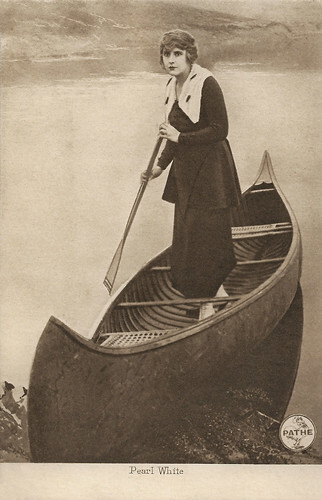
British postcard. Photo: Pathé.
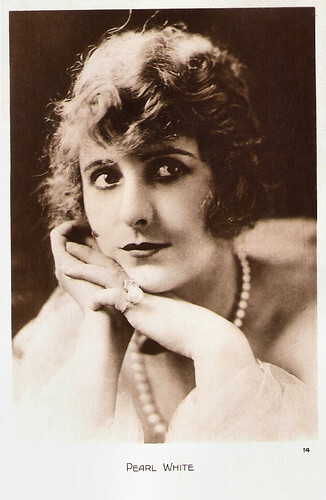
French postcard by Cinémagazine-Edition, Paris, no. 14.
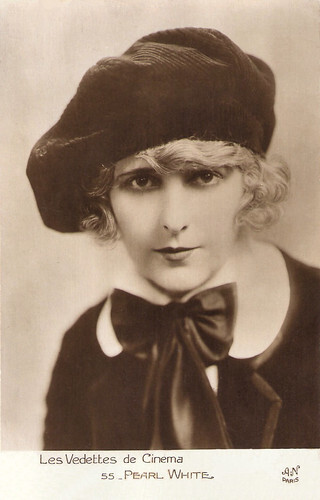
French postcard by A.N., Paris, in the Les vedettes de cinéma series, no. 55.
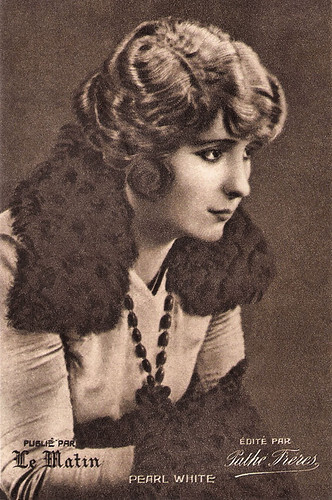
French postcard by Le Matin. Photo: Pathé Frères.
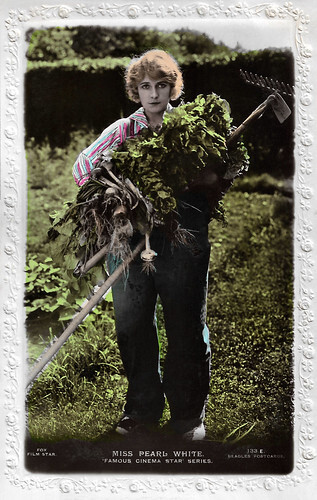
British postcard in the Famous Cinema Stars series by J. Beagles & Co. Ltd., London, no. 133E. Photo: Fox.
Pathé Frères
Pearl Faye White was born in 1889 on her father's farm in Green Ridge, Missouri, the youngest of five children. She moved with her family to Springfield, Missouri, where she grew up. Her mother died when Pearl was only three years old. Pearl joined the Diemer Theatre Company during her second year of high school.
At age 18, she went on the road with the Trousdale Stock Company, a repertoire group, in 1907. She was signed by the Powers Film Co. in New York in 1910. The following year, she moved to Philadelphia and joined the more professional film studio Lubin Film Company. She worked opposite some well-known actors, including Arthur Johnson and Florence Lawrence.
Then White got a contract with Pathé Frères. She only appeared in a few films there, before starting to work for Crystal Film Company where she first gained public attention. She acted in a handful of films that met with great success, including Pearl as a Clairvoyant (Phillips Smalley, 1913), Pearl's Dilemma (Phillips Smalley, 1913), Pearl as a Detective (Phillips Smalley, 1913), and What Pearl's Pearls Did (Phillips Smalley, 1914).
After this success, she returned to Pathé, where she became a star. In 1914, Pearl White starred in Pathe's 20-part film series The Perils of Pauline (Louis J. Gasnier, Donald MacKenzie, 1914), the fifth serial ever made.
Another success was The Exploits of Elaine (1914-1915). In Europe, The Exploits of Elaine were re-edited with two subsequent serials into Les Mystères de New York. Around 1914-1915 she was the most popular female film star, and for a time she even topped Mary Pickford 's popularity at the box office. She became an international star and was the leading heroine in a number of serials, which enjoyed immense popularity.
She gained her initial fame by performing her own dangerous and life-threatening stunts. Stunt doubles were used after her popularity surged, and the studio became concerned for her safety. In 1922, during the filming of her final serial, Plunder, John Stevenson - her stand-in/stunt double - was killed while attempting a dangerous stunt. He was supposed to leap from the top of a bus on 72nd Street and Columbus Avenue onto an elevated girder. He missed the girder and struck his head. Stevenson died of a fractured skull. A rumor immediately spread that she had been killed, and a slight scandal arose when it was revealed that she had used a stand-in.
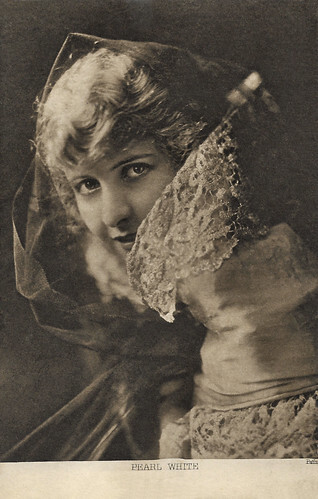
British postcard in the Pathé Frères Cinema LTD Series. Photo: Pathé Frères.
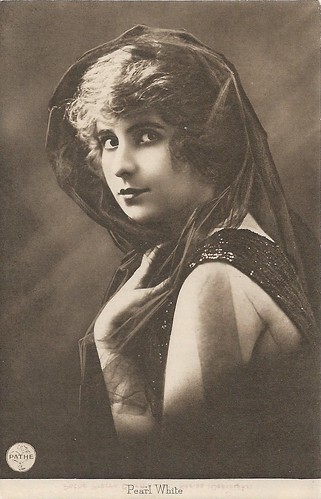
British postcard in the Pathé Frères Cinema LTD Series. Photo: Pathé Frères.
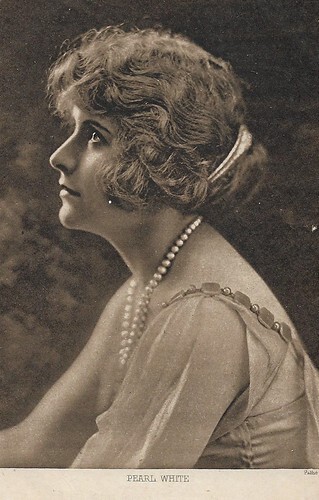
British postcard in the Pathé Frères Cinema LTD Series. Photo: Pathé Frères.
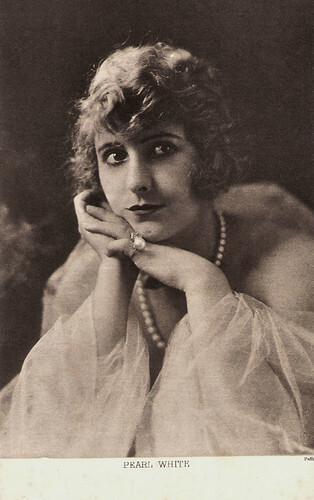
British postcard in the Pathé Frères Cinema LTD Series. Photo: Pathé Frères.
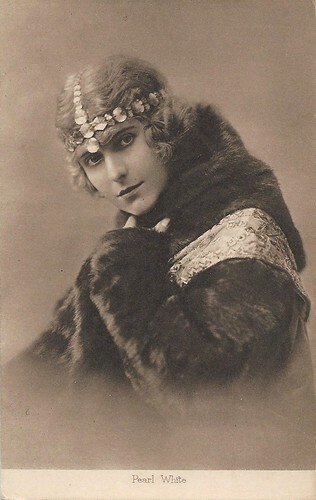
British postcard in the Pathé Frères Cinema LTD Series. Photo: Pathé Frères.
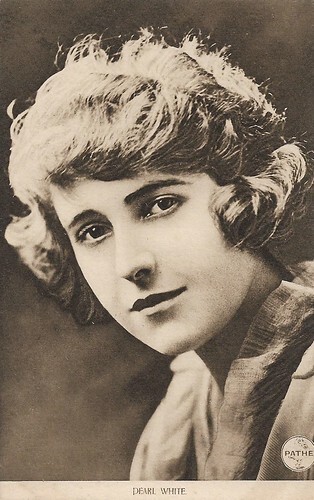
British postcard in the Pathé Frères Cinema LTD Series. Photo: Pathé Frères.
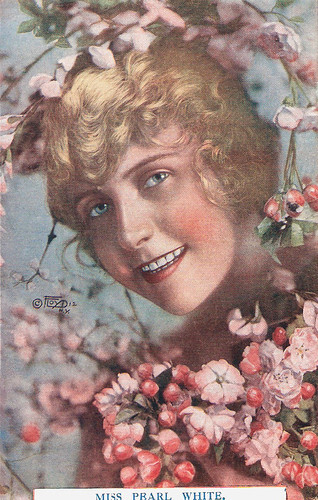
British postcard in the Pathé Frères Cinema LTD., Series. Photo: Floyd, N.Y.
Fox Film Corporation
Pearl White was married twice. In 1907, she met her first husband, Victor Sutherland when they were touring together. It was a problematic marriage and a divorce followed in 1914. In 1919, she married actor and war hero Wallace McCutcheon Jr., son of pioneering cinematographer and director Wallace McCutcheon Sr. He had been gassed in World War One and suffered mental problems. The couple divorced two years later.
In 1919, she left Pathé for a film contract with Fox Film Corporation, where she appeared in nine films. Almost all of the films flopped, so White returned to Pathé in 1923. Her second husband was distraught over the dissolution of the marriage and had disappeared only weeks after the divorce. It was believed that he had committed suicide.
Pearl went to Paris and subsequently suffered a nervous breakdown. The breakdown was attributed in part to her guilt over Stevenson and McCutcheon. She remained in seclusion in France until McCutcheon's reappearance in May 1923. In 1928, he fatally shot himself. When found, his pockets were bulging with clippings about Pearl. With her health deteriorating, she retired.
White was born into poverty, but by the time she retired from films in 1924, she had amassed a fortune of $2 million ($30 million in 2020). Pearl was a shrewd businesswoman, investing in a successful Parisian nightclub and a Biarritz resort hotel/casino. She owned a profitable stable of thoroughbred racehorses and divided her time between her townhouse in Passy and a 54-acre estate near Rambouillet.
In later life, Pearl White suffered from all the stunts she had performed. In 1933, she was permanently hospitalised. She died five years later, in 1938 at the age of 49. She left her enormous fortune to her partner, Greek businessman Theodore Cossika. Pearl White was buried in the Passy Cemetery in Paris, her tombstone bears only her name.
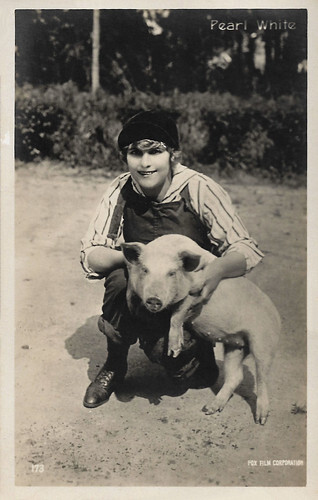
Italian postcard by G. Vettori, Bologna, no. 173. Photo: Fox Film Corporation.
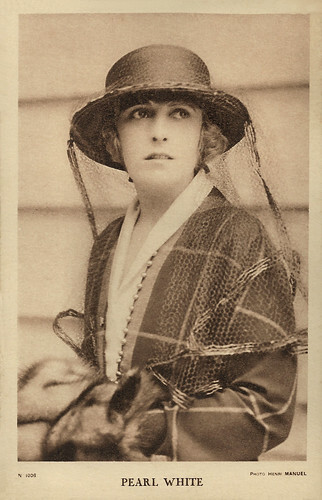
French postcard by Edition de la Cinematographie Française, Paris, no. 1006. Photo: Henri Manuel.
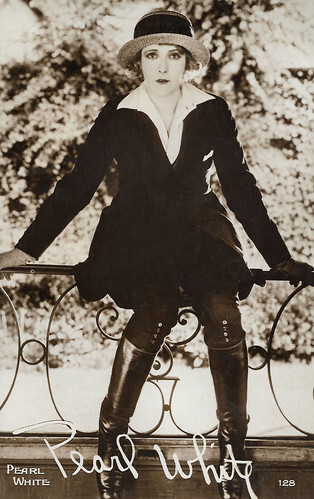
French postcard by Editions Cinémagazine, no. 128.
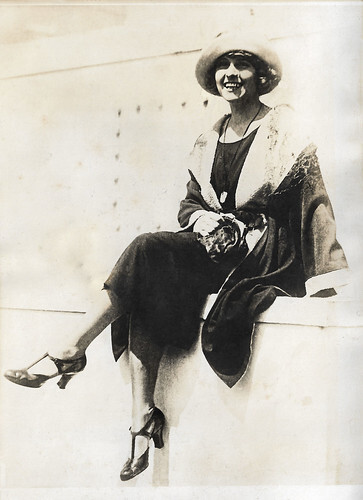
German press photo by Atlantic-Photo-Co., Berlin, no. 7275. Caption: From the monastery to the stage. Pearl White, the English [sic] film actress who retired to a convent some time ago, will return to film. First, she will appear in a revue in Paris.
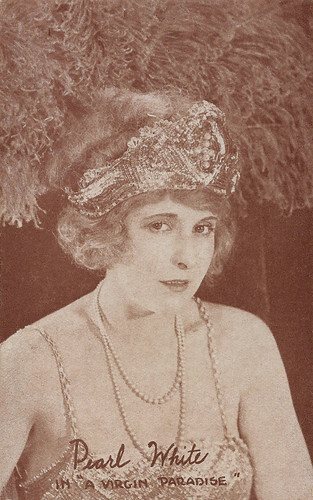
American postcard. Photo: Pearl White in A Virgin Paradise (J. Searle Dawley, 1921).
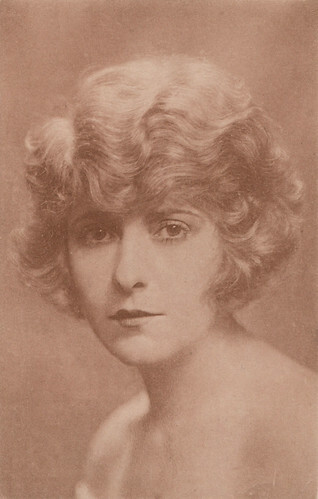
French postcard by Editions Sid, no. 8035. Photo: G.L. Manuel Frères.
Sources: (IMDb), Wikipedia (Dutch and English), and .

French postcard. Nos artistes dans leur loge, no. 323. Photo: Comoedia, Paris.

British postcard. Photo: Pathé.

French postcard by Cinémagazine-Edition, Paris, no. 14.

French postcard by A.N., Paris, in the Les vedettes de cinéma series, no. 55.

French postcard by Le Matin. Photo: Pathé Frères.

British postcard in the Famous Cinema Stars series by J. Beagles & Co. Ltd., London, no. 133E. Photo: Fox.
Pathé Frères
Pearl Faye White was born in 1889 on her father's farm in Green Ridge, Missouri, the youngest of five children. She moved with her family to Springfield, Missouri, where she grew up. Her mother died when Pearl was only three years old. Pearl joined the Diemer Theatre Company during her second year of high school.
At age 18, she went on the road with the Trousdale Stock Company, a repertoire group, in 1907. She was signed by the Powers Film Co. in New York in 1910. The following year, she moved to Philadelphia and joined the more professional film studio Lubin Film Company. She worked opposite some well-known actors, including Arthur Johnson and Florence Lawrence.
Then White got a contract with Pathé Frères. She only appeared in a few films there, before starting to work for Crystal Film Company where she first gained public attention. She acted in a handful of films that met with great success, including Pearl as a Clairvoyant (Phillips Smalley, 1913), Pearl's Dilemma (Phillips Smalley, 1913), Pearl as a Detective (Phillips Smalley, 1913), and What Pearl's Pearls Did (Phillips Smalley, 1914).
After this success, she returned to Pathé, where she became a star. In 1914, Pearl White starred in Pathe's 20-part film series The Perils of Pauline (Louis J. Gasnier, Donald MacKenzie, 1914), the fifth serial ever made.
Another success was The Exploits of Elaine (1914-1915). In Europe, The Exploits of Elaine were re-edited with two subsequent serials into Les Mystères de New York. Around 1914-1915 she was the most popular female film star, and for a time she even topped Mary Pickford 's popularity at the box office. She became an international star and was the leading heroine in a number of serials, which enjoyed immense popularity.
She gained her initial fame by performing her own dangerous and life-threatening stunts. Stunt doubles were used after her popularity surged, and the studio became concerned for her safety. In 1922, during the filming of her final serial, Plunder, John Stevenson - her stand-in/stunt double - was killed while attempting a dangerous stunt. He was supposed to leap from the top of a bus on 72nd Street and Columbus Avenue onto an elevated girder. He missed the girder and struck his head. Stevenson died of a fractured skull. A rumor immediately spread that she had been killed, and a slight scandal arose when it was revealed that she had used a stand-in.

British postcard in the Pathé Frères Cinema LTD Series. Photo: Pathé Frères.

British postcard in the Pathé Frères Cinema LTD Series. Photo: Pathé Frères.

British postcard in the Pathé Frères Cinema LTD Series. Photo: Pathé Frères.

British postcard in the Pathé Frères Cinema LTD Series. Photo: Pathé Frères.

British postcard in the Pathé Frères Cinema LTD Series. Photo: Pathé Frères.

British postcard in the Pathé Frères Cinema LTD Series. Photo: Pathé Frères.

British postcard in the Pathé Frères Cinema LTD., Series. Photo: Floyd, N.Y.
Fox Film Corporation
Pearl White was married twice. In 1907, she met her first husband, Victor Sutherland when they were touring together. It was a problematic marriage and a divorce followed in 1914. In 1919, she married actor and war hero Wallace McCutcheon Jr., son of pioneering cinematographer and director Wallace McCutcheon Sr. He had been gassed in World War One and suffered mental problems. The couple divorced two years later.
In 1919, she left Pathé for a film contract with Fox Film Corporation, where she appeared in nine films. Almost all of the films flopped, so White returned to Pathé in 1923. Her second husband was distraught over the dissolution of the marriage and had disappeared only weeks after the divorce. It was believed that he had committed suicide.
Pearl went to Paris and subsequently suffered a nervous breakdown. The breakdown was attributed in part to her guilt over Stevenson and McCutcheon. She remained in seclusion in France until McCutcheon's reappearance in May 1923. In 1928, he fatally shot himself. When found, his pockets were bulging with clippings about Pearl. With her health deteriorating, she retired.
White was born into poverty, but by the time she retired from films in 1924, she had amassed a fortune of $2 million ($30 million in 2020). Pearl was a shrewd businesswoman, investing in a successful Parisian nightclub and a Biarritz resort hotel/casino. She owned a profitable stable of thoroughbred racehorses and divided her time between her townhouse in Passy and a 54-acre estate near Rambouillet.
In later life, Pearl White suffered from all the stunts she had performed. In 1933, she was permanently hospitalised. She died five years later, in 1938 at the age of 49. She left her enormous fortune to her partner, Greek businessman Theodore Cossika. Pearl White was buried in the Passy Cemetery in Paris, her tombstone bears only her name.

Italian postcard by G. Vettori, Bologna, no. 173. Photo: Fox Film Corporation.

French postcard by Edition de la Cinematographie Française, Paris, no. 1006. Photo: Henri Manuel.

French postcard by Editions Cinémagazine, no. 128.

German press photo by Atlantic-Photo-Co., Berlin, no. 7275. Caption: From the monastery to the stage. Pearl White, the English [sic] film actress who retired to a convent some time ago, will return to film. First, she will appear in a revue in Paris.

American postcard. Photo: Pearl White in A Virgin Paradise (J. Searle Dawley, 1921).

French postcard by Editions Sid, no. 8035. Photo: G.L. Manuel Frères.
Sources: (IMDb), Wikipedia (Dutch and English), and .
Published on May 31, 2022 22:00
Paul van Yperen's Blog
- Paul van Yperen's profile
- 13 followers
Paul van Yperen isn't a Goodreads Author
(yet),
but they
do have a blog,
so here are some recent posts imported from
their feed.



